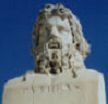








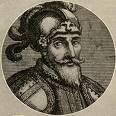


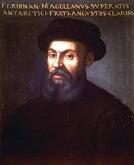

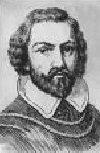


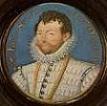


















TLW's Explorerscope™ (Explorer Historyscope) |
By T.L. Winslow (TLW), the Historyscoper™ |
© Copyright by T.L. Winslow. All Rights Reserved. |
Original Pub. Date: Feb. 15, 2017. Last Update: Dec. 2, 2024. |













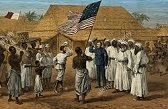
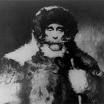


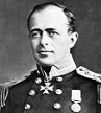
Westerners are not only known as history ignoramuses, but double dumbass history ignoramuses when it comes to explorer history. Since I'm the one-and-only Historyscoper (tm), let me quickly bring you up to speed before you dive into my Master Historyscope.
About 515 B.C.E. (July -518?) Scylax of Caryanda, a Greek in the Persian navy is sent by Darius I to explore the coastlines of India and Egypt, spending 30 mo. and helping Darius I conquer the Indus River Valley.
In 470 B.C.E. Hanno ("merciful") the Navigator (Hanno II of Carthage) makes a celebrated voyage beyond the Pillars of Hercules down the African coast as far as Senegal, Sierra Leone, Cameroon, Gabon, or Nigeria, establishing a dye manufacturing plant in Mogador (Mogadore) in Morocco; he first describes gorillas, describing them as a savage hirsute people whose males couldn't be captured and the three females that were were so vicious that they had to kill them and transport their skins instead - once you go black you'll never go back?


Up until the rise of the Greeks, everything was cool, and then Greek sailor Pytheas of Massilia (-380 to -300) visited the British Isles and checked it out around 330 B.C.E., in the days of Alexander III the Great (-356 to -323), and reported back, which could have been bad, but the know-it-all philosopher geniuses back in Greece thought he was a space cowboy and didn't believe him, so they never followed up, else we'd all be speaking Greek today. Or maybe it was that the freezing stormy Atlantic was too much for these bare-backed Greek wusses used to the warm, mild panytwaist sailing of Club Med. Too bad, the Romans, who started in the Tiber River Valley in the center of the Italian peninsula, kept clawing their way out, kicking the butts of all the tribes in their way, the main obstacle being the Etruscans, and after reaching the neck and going east and running out of butt to kick, the only way left was to go west, so the fun started.


In 90 B.C.E. Greek Stoic polymath philosopher-historian Posidonius "the Athlete" of Apamea (Rhodes) (-135 to -51) sets out on a mission to visit the "wild" Celts of the forests and mountains of W Europe, producing his History of the Wild Celts (later lost), which becomes a Roman bestseller; he says that the Celts are sophisticated people who perform highly ritualized human sacrifice, compose beautiful poetry, and give their Celtic women greater freedom than even the Romans (incl. the right to be a warrior), and falsely claims that they are cannibals; Roman gen. Julius Caesar (-100 to -44) reads it and now knows what his life work will be, namely, to kill or enslave them all and steal everything they've got to make himself a millionaire and big man who's spread civilization to the less fortunate?; once nice thing, the Celts have no written language, so the survivors won't later stink Rome up with bestselling exposes? After all, they raped his great-great-great-great grandmother, and had no respect for the male supremacist gods on Mount Olympus. In 58 B.C.E., when he was 42 years old and at the time of life when he had to think about feathering his nest for retirement, the Senate gave him a 5-year mission, should he decide to accept it, to explore strange new lands in the wild west and kill every Celt he could get his hands on, then steal all their wealth and make slaves to take back to Rome for a big parade, and in eight expeditions he divided and conquered them tribe by tribe, killing a million Celts and wiping them out of the Continent. To show how magnanimous he was, he pardoned the last fifteen thousand Belgi after first having their right (sword/spear-throwing) arms chopped off so his war mastiffs could have a treat. Belgium was sure a funny-looking country after that, but at least their Gaelic language survived enough to help form French and Walloon. Meanwhile, since they were supposed to wipe with their left hand and shake with their right, who wanted to shake a Belgi's hand? Funny that Gene Roddenberry picked the name Captain Kirk for a futuristic Caesar controlled by a Prime Directive. The Germans helped Caesar by sandwiching the Celts in a 2-front war. He then chased the Germans back over the Rhine and turned Gaul into a Roman province with Roman settlers, an evening walk in the forest, flowers, and fields.
In 458 C.E. Buddhist priest Hui Shun (Fusang) sails from China to Alaska accompanied by four Afghan disciples, then journeys on foot down the North Am. Pacific Coast, reaching Mexico, where he teaches Buddhism to the Indians and Mayans, naming Guatemala for Gautama Buddha; he stays for over 40 years, then returns to China, reporting his travels to Lord Yu Kie and Emperor Wu in 502.

In 629 C.E. Chinese Buddhist monk Xuanzang (Hiuen Tsang) (Tang Sanzhang) (602-63) defies an imperial edict forbidding foreign travel, and escapes from the capital of Sian-fu (Signan) on a 16/17-year journey to India (Cambodia) to fetch Buddhist scriptures (ends 1645).
In 874 C.E. Norse Vikings under chieftain Ingolfur (Ingolfr) Arnarson) discover and settle Iceland (AKA Island or Lydveldid Island) at Reykjavik (Norse "bay of smoke") (named by Arnarson) on the Faxafloi River close to the Arctic Circle (world's northernmost capital), and drive the Irish hermits out, creating a New Norway with a high culture, with the city's volcanic springs giving abundant boiling hot water - blonde babes and hot tubs, who needs civilization?
About 900 C.E. Norwegian Viking leader Gunnbjorn Ulfsson sights icy ungreen mosquito-plagued Greenland, 200 mi. W of green not-so-icy Iceland, but it is soon forgotten?

In 981 C.E. Norwegian Viking leader (known for his red hair and/or temper) Eric (Erik) "the Red" Thorvaldsson (Porvaldsson) (950-1003) of Iceland, whose father Thorvald (Porvald) was exiled from Norway to Iceland for a killing, and who had already been driven from one part of the island for killing a neighbor, kills two of his neighbor's sons in a feud over wooden house beams, is convicted of manslaughter and banned from Iceland for three years along with his wife Tjodhilde (daughter of a wealthy islander). In 982 C.E. exiled Eric the Red lands at Ericsfjord in E Greenland with his small band of Viking colonists, explores Greenland, and finding it mainly rocky and snow-covered, unlike green, clement Iceland (except for some grassy valleys in Ericsfjord, which enjoy a brief summer period of verdure, so he can't be successfully sued?), he decides to use false advertising to attract more settlers, naming it you know what? - good reason to fish west for a better home?

In 999 C.E. Eric the Red's son Leif Ericson (970-1020) sails from Greenland to Norway, drifts off course to the Hebrides and winters, falls for some babe and converts to Christinsanity with not a minute to spare, goes on to Norway and is baptized at the court of King Olaf Tryggvason I, then is commissioned to carry the faith back to Greenland, with a priest to accompany him. In 1003 C.E. Icelandic Viking anything-goes-man Leif Ericson (Ericsson) (970-1020), son of Erik the Red buys Bjarni Herjulfson's ship, then sails with a 35-man crew from Greenland in a SW direction, running into North Am., first at Baffin Island, which he calls Helluland, then Labrador, which he calls Markland, and finally Newfoundland, which he calls Vinland the Good (Land of Grapes/Berries/Meadows), a place where wild grapes and wheat are seen growing; they winter there, building a village of "big houses", encountering the Beothuk people; in the 1960s Helge Ingstad finds evidence of Vinland in L'Anse aux Meadows (Fr. "L'Anse-aux-Meduses" = jellyfish cove) in Newfoundland; did they bring back native women?

About 1250 English Franciscan friar Roger Bacon (1214-94) invents the Magnifying Glass, breaking away from slavish reliance on Aristotle and demanding real experiments, look at that bug. In 1267 he pub. Opus Majus (Great Work), an encyclopedic work on experimental science, math, optics, and philosophy, coining the word "almanac" (Arab. "al manakh" = the weather), giving a recipe for gunpowder (41.2% saltpeter, 29.4% charcoal, 29.4% sulfur) (Pt. VI), predicting powered flight, proposing that one day be dropped from the Julian Calendar every 125 years, and containing the soundbyte (Pt. IV): "The sea between the end of Spain on the west and the beginning of India on the east is navigable in a very few days if the wind is favorable", later inspiring Columbus; it concludes with a warning that science cannot save mankind, but that "The science of morality is the mistress of every department of philosophy"; he didn't invent gunpowder, just repeated a formula he got from others - whether they're ground in, smeared on, or powdered, it doesn't matter, that's the power of Gunbarrel Clean? About 1270 he writes the soundbyte: "The philosophy of Averroes today obtains the unanimous suffrage of wise men." In 1271 he pub. the unfinished Compendium Studii Philosophiae, dissing nominalism in favor of realism; "A universal is nothing but the similarity of several individuals"; "One individual has more reality than all universals put together"; too bad, he also goes after the clergy, papacy, univs., and philosophers of his day, listing "36 great and radical defects", even going after Thomas Aquinas for pontificating on the angels, causing a conspiracy to silence him? No surprise, in 1277 the heads of the Franciscan and Dominican orders get together and imprison Bacon for "suspected novelties" until he gets too old to do any more harm (1292).
In 1253 Louis IX of France sends Flemish Franciscan missionary William of Rubruquis (Rubruck) (Wilhelm van Ruysbroeck) (1220-93) to the court of the Great Khan in C Asia, returning in 1255 with an invitation to submit France to the Mongol power, later reporting his amazing experiences, incl. the source of the Don and Volga Rivers, the location of Lake Balkhash, the cult of the Dalai Lama, the presence of Islam in C Asia, how the Caspian Sea doesn't flow into the Arctic Ocean, Nestorian Christian settlements in China, and the difference between Mongols and Tatars; in May 1254 he engages in a formal debate at the Mongol court with Buddists and Muslims.

In 1271 Kublai Khan officially creates the Great Yuan (Mongol) Dynasty (ends 1368); meanwhile the Polos begin their 2nd trip from Europe to Asia (ends 1275), accompanied by Niccolo Polo's 17-y.-o. son Marco Polo (the Younger) (1254-1324), stopping in Jerusalem to get oil from the lamp of the Holy Sepulchre as requested by Kublai Khan, sailing to the SE Turkish port of Ayas, then traveling E by caravan across the entire width of Asia through E Turkey (noting that Mt. Ararat is too hard to climb), Georgia and Azerbaijan (noting "a fountain from which oil springs in great abundance", which is good for burning but no good in a salad), Armenia (with 30 lb.-fat-tailed sheep), Persia (noting the cool soft Kerman "shals"), Badakhshan (seeing salt mined and rubies dug), then via camel along the S Silk Road through the Taklamakan Desert and Great Sand Sea (Gobi Desert) (noting sandstorms and mirages), visiting Balkh, the Pamir Plateau, Kashgar, Khotan, Lop Nor, Tangut, and Kanchow, homeland of the Mongols, finally reaching Chandu (Shangtu) (Xanadu), becoming the first Westerners in a generation to cross the Wakhan Corridor to China; during his visit to Baku, Azerbaijan on the shores of the Caspian Sea, he sees oil being collected from seeps, writing the soundbyte: "On the confines toward Georgine there is a fountain from which oil springs in great abundance, in as much as a hundred shiploads might be taken from it at one time. This oil is not good to use with food, but 'tis good to burn, and is also used to anoine camels that have the mange. People come from vast distances to fetch it, for in all the countries round there is no other oil." What was that about the lights of Broadway? Backward West meets Dazzling East and likes it? In May Marco Polo (1254-1324) and his party arrive at Kublai Khan's summer capital of Chandu (Shangtu) (Xanadu) N of the Great Wall in Cathay (China), where they stay until 1292, noting that he keeps 10K milk-white horses within the walls of his summer residence; in the fall they accompany Kublai Khan to his winter capital at Peking, where they view his "stately pleasure dome" of violet, green, and vermilion on gilded walls carved with figures of dragons and Buddhas, which has a huge hall capable of entertaining 6K at dinner; the royal dude has 1M retainers, and his New Year's parade features 5K elephants each carrying two coffers of treasure; Marco pleases Kublai's ear with his own stories, and is given free run of Cathay for 17 years, observing spectacles (eyeglasses) in gen. use. My mind's such a sweet thing, crimson and clover, over and over? In 1298 Italian world traveler Marco Polo (1254-1324) is captured in battle and thrown in jail in Genoa, which gives him the leisure to write up his cool travels, and he begins dictating his memoirs to his cellmate, incl. a sherbet recipe brought home from Asia, finishing ca. 1300; it takes until 1447, but finally A Description of the Marvels of the World (The Travels of Marco Polo), AKA (by his many doubters) Il Milione (The Million Lies) (The Marco Millions) is pub.; it describes heating coal ("black stones"), oil lamps, asbestos, Chinese scholars wearing eyeglasses, crocodiles, yaks ("grunting oxen"), coconuts, how emperor Kublai Khan's harem is filled with 100 new concubines every two years by special emissaries, the Pacific Ocean, his route across the Asian continent and all the cool wonders and sights, the interior workings of unsaved China, everything except tea, foot binding, and the Great Wall of China?; on the other hand, he claims that a prince "sixth in descent from Prester John" rules a territory W of Peiping (Peking); although there really is a Kublai Khan who rules from Siberia to the Punjab, and he really did go away from age 17-40 and mainly tell it like it is, it takes cents. for him to be believed by members of the Holy Mother Church and its infallible Pope with a pipeline to Christ and God; the stories introduce Japan, Peking, Java, Sumatra, Siam, Burma, Ceylon, the Zanzibar Coast, Madagascar, and Abyssinia to the West, inspiring commerce and travel, and helping inspire Columbus.
In May 1291 Genoese explorer-merchants Ugolino Vivaldi (de Vivaldo) and Vandino (Vadino) (Guido) Vivaldi set out from Genoa in two galleys to sail around Africa to India, accompanied by two Franciscan missionaries; too bad, after reching Cape Nun off the S coast of Morocco they are never heard from again, becoming one of the first voyages from the Mediterranean to the Atlantic since the ancient Roman Empire in the 5th cent. C.E.
In Apr. 1318 a group of Franciscans led by Odoric of Pordenone (Odorico Mattiussi or Mattiuzzi) (1286-1331) incl. James of Ireland leave Padua, Italy on a mission to the East (ends 1330), taking them to Venice, Constantinople, Trebizond, Armenia, Media, Persia incl. Kashan, Yazd, Persepolis, and Shiraz, India (Thane near Mumbai), Sumatra, Java, Borneo, Champa, Guangzhou, Quanzhou, Zhejiang, Hangzhou, Nanjing, and Khanbaliq (modern-day Beijing) in 1324-7, returning via the Land of Prester John (Mongolia), Casan, Tibet, N Persia (incl. Tabriz) to Venice; in 1328 Odoric becomes the first Euro to visit Tibet - the original Pordenone's Complaint?
In 1328 Wang Dayuan (1311-) travels from Quanzhou, China along the South China Sea to South Asia, reching Singapore in 1330, Bengal, Sri Lanka, and India by 1333, and North Africa and East Africa in 1334-9; in 1349 he writes Daoyi Zhilue, one of the first accounts of the history of Singapore.

In 1369 Moroccan traveler-scholar Muhammad Ibn Battuta (b. 1304) dies after traveling through most of the Muslim World and many non-Muslim countries in North Africa, the Horn of Africa, West Africa, the Middle East, India, Central and Southeast Asia, and China, leaving his "Travels" (Rihla).

In 1405 the pesky Mongols out of his hair, Chinese Emperor Yung-lo commissions the Seven Voyages of Cheng Ho in the Indian Ocean (ends 1433) in 317 technologically advanced ships with 37K crew in order to impress neighbors, bring states into vassalage, and get treasure and trade goods (dwarfing anything the Euros can match for the next two cents.), all headed by Chinese Muslim (Hui) royal eunuch adm. Cheng Ho (Zheng He) (1371-1433), accompanied by four officials incl. Ma Huan of Zheng (1380-1460), Fei Xin (Hsin) (1385-1437), Gong Zhen (Kung Chen), and Guo Chongli; the First Voyage of 63 ships with 27K men begins (ends 1407), with the goal not to conquer or trade, but to assert Chinese superiority.

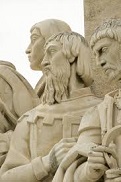
In 1434 after sailing from Lagos, Portuguese explorer Gil Eannes (Eanes) (1395-) rounds Cape Bojador (Bulging Cape) S of the Canary Islands on the W coast of Africa (modern-day Mauritania) in a modified fishing barquentine, and discovers the Rio de Ouro (Oro) to the S, bringing back wild roses to Sagres to prove their success, after 10 years of trying and 14th attempts, delighting Prince Henry the Navigator and opening the Portuguese Age of Discovery in Africa; next year he and and Afonso Goncalves Baldaia (1415-81) sail two ships 150 mi. S of the cape, reaching the African coast; the year after that Baldaia sails farther S along the coast of Western Sahara and collects thousands of monk seal skins before becoming the first Euro to cross the Tropic of Cancer and reach Pedra da Gale (Galha Point), becoming the first commercial cargo brought to Europe from West Africa; too bad, failure to find any natives to kidnap causes Prince Henry to not authorize another expedition until 1441 - more big strong Mandingos to kidnap?

In 1441 Portuguese explorer Nuno Tristao (Tristão) (Tristam) sails to Cabo Blanco (Cape Blanc) S of Cape Bojador in West Africa, and finds the first loose African negroes running around without pink slips and dog tags, prompting plans to restart the slave trade; he brings back some Moors, who when they get to Portugal are allowed to return after trading themselves for "black Moors" with kinky hair; Portuguese Order of Christ member Antao Goncalves makes the first European landing on the W coast of Africa at Rio de Oro (Ouro) (Gold River) S of Cape Bojador, then brings the first black African slaves to Europe via the Atlantic Ocean (12 black Muslim Azanaghis) (before this they had all been brought via the Mediterranean, but weren't as good as the ones from the W coast?), which Goncalves gives as a gift to his boss Prince Henry the Navigator - I did what I did before love came to town?
In 1445 Antao Goncalves of Portugal visits the Bay of Arguin and contracts with Muslim merchant Ahude Meymam to purchase 10 black slaves, along with some gold dust and ostrich eggs, becoming the first recorded purchase of West Africans by Europeans in West Africa?
In 1445 Venetian explorer Ca'da Mosto discovers the Gambia River in West Africa, going approximately 150 mi. into the interior.
In 1445 Portuguese explorer Dinis Dias (Diniz Diaz), who was of retirement age but decided "he was unwilling to let himself grow soft in the well-being of repose" discovers and rounds Cape Verde (800km S of Cap Blanc) the westernmost point of Africa, and increases the Portuguese trade with West Africa; he misses the Cape Verdes Islands.
In 1446 Guinea-Bissau on the W coast of Africa is discovered by Portuguese explorer Nuno Tristao.
By 1448 approx. 1K black Africans have been carried to Portugal or its newly-acquired Atlantic islands Azores and Madeira.
In 1448 Danish nobleman Vallarte, who had joined the court of Portugal's Prince Henry the Navigator becomes the first N European on record to sail to West Africa; he is captured and killed off Goree.


In 1453 C.E. European invasion of Africa really starts when the Ottoman Muslims after hundreds of yearly attempts finally capture the eastern Christian outpost stronghold of Constantinople, freaking the entire Christian world and leading to perversions and flukes like Vlad Dracula the Impaler, causing the Portuguese under Prince Henry the Navigator (1394-1460) to accelerate their search for escape routes to the south, having already discovered the Azores (1432) and West Africa (1433) after they broke down and stooped to use the infidel Muslim astrolabe then made their own technological leap of a 3-masted vessel that allowed them to finally navigate in open waters around 1420. In 1441 the lucky Portuguese discover cocoa puff African blacks, which they immediately recognize as two-legged animals that would be useful as slaves, setting up Elmina Castle in Ghana in 1482, which becomes the world's #1 slave-trading post, it's as big as a horse, ask me about it sometime, gag. In 1486 they finally round the Cape of Good Hope, allowing them to go east and reach India and China. Meanwhile on June 18, 1452 after requests by Portuguese king (1438-81) Afonso V the African (1431-81), Pope Nicholas V issue the bull Dum Diversas, authorizing him to conquer and subdue diverse dumb African Saracens and pagans, and consign them to indefinite slavery, launching the West African slave trade. Too bad, on Jan. 8, 1455, after getting over the shock of the 1453 Ottoman Muslim capture and rape of Constantinople, and wanting to bless the adventurous but devout Portuguese and Spanish with global holy mojo, Nicholas V finally decides to take off the gloves and issues the bigger bull Romanus Pontifex, creating the Roman Catholic Doctrine of Discovery, with the soundbyte "We bestow suitable favors and special graces on those Catholic kings and princes... athletes and intrepid champions of the Christian faith... to invade, search out, capture, vanquish, and subdue all Saracens and pagans whatsoever, and other enemies of Christ wheresoever placed, and ... to reduce their persons to perpetual slavery, and to apply and appropriate ... possessions and goods, and to convert them to ... their use and profit." Not that I mind it when it comes to horrible Muslims, but when it ends up being used to enslave people just for not having white skin, it stinks.
In 1455 the uninhabited Cape Verde Islands 400 mi. W of Cape Vert, Senegal are discovered by Alvise Cadamosto (Alvide da Ca'da Mosto) (1432-83), a Venetian in the service of Portuguese Prince Henry, who goes on to explore most of Cape Vert (home of modern-day Dakar), the Senegal and Gambia Rivers (until 1457) - if only they had kept going west?
In 1462 Portuguese settlers found a settlement in the Cape Verde Islands off the W coast of Africa 400 mi. W of Dakar, Senegal, which they call Ribeira Grande, becoming the first permanent Euro settlement in the African tropics; Portuguese explorer Pedro de Sintra explores inland from Freetown Habor, naming the surrounding hill formation Serra de Leao (Sierra Leone) (Lion Mts.), AKA Sierra Leone, then goes on to explore the Benin Empire; in 1495 a fort and trading post are built in Freetown Harbor by Portuguese traders, which becomes a trading center for African slaves.
On Dec. 21, 1471 Portuguese explorers Joao de Santarem (Santarém) and Pedro (Pero) Escolar discover Mina (Elmina) (S coast of South Ghana 7.5 mi. W of Cape Coast) on the Gold Coast in West Africa, stretching from Cape Three Points to the Volta (Port. for bending or turning) River, and set up a trading station, becoming the first Euro settlement in West Africa; they go on to discover Annobon next Jan. 1 and Principe on Jan. 17, 1472.
In 1472 the Portuguese discover Cameroon, naming it after the giant shrimp (Port. camaroes) they find there.
In 1472 the Portuguese push past the equator, and Fernando Po (Póo) (Fernao do Po) discovers Fernando Po Island in the Bight of Biafra on the W coast of Africa, becoming strategically important as an entry port to the diseased "White Man's Grave" of the African equatorial zone.

In summer 1482 Portuguese navigator Diogo Cao (Diego Cam) (1452-86) becomes the first European to sight and enter the Congo River, discovering Angola (1482-4). On July 6, 1484 Diego Cam discovers and explores the mouth of the Congo River; later Nzinga Myemba, king of Congo (who later takes the name Dom Alfonso) invites the Portuguese to Christianize and Europeanize his kingdom.

Sounds like a hot night with a high class hooker? On Feb. 4, 1488 after reaching Walvis Bay in Dec., discovering the Westerlies and exploring Table Bay at the N end of the Cape Peninsula, then rounding the Horn, becoming the first European to reach the Indian Ocean from the Atlantic Ocean, reaching a record S latitude for a European then turning NE and sailing for 30 days, discovering and mapping discovering Angra Pequena (Port. "small bay") (AKA Angra de Sao Christovao) in modern-day Namibia, Portuguese explorer Bartholomeu (Bartolomeo) Dias (Diaz) (1450-1500) discovers Mossel Bay, then turns back after reaching the mouth of Bushman's River on Mar. 12; in May on his return he discovers the Cape of Good Hope, which he calls the Cabo Tormentoso (Cape of Storms) before returning to Lisbon in Dec.; King John II later renames it in the spirit of Erik the Red to keep his sailors from bolting; he discovers Robben Island in Table Bay in South Africa, then returns to Lisbon in Dec.
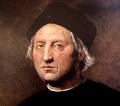









In 1492 up-and-coming "Los Reyes Catolicos" (the Catholic Kings) Ferdinand II (1452-1516) and Isabella I (1451-1504) of Aragon and Castile finally finished the Catholic Reconquista, kicking the last Muslim butt out of Spain (which the Allah Akbars had invaded back in 711 C.E., talk about persistence), deciding to expel all 250K pesky Jews from Spain too for good measure, when they were suddenly approached by mysterious Italian-Portuguese-who-knows-what Ben Cristobal Kingsley Colon, AKA Christopher Columbus (1451-1506), who had already been told to piss-off in 1483 by Portuguese king Joao (John) II the Perfect (1455-95), and who seemed to know that if they just went west far enough, there'd be an escape route for the Jews, who had long found a safe haven from the horrible mean Christians in Muslim Spain, where they had been free to work up to grand vizier and live the good life as high-paid physicians and moneylending usurers gorging on kosher Valencia oranges, and now had nowhere to go except to Africa, where the Christians might invade at any moment, and no way to stay unless they liked to be basted with oranges; Columbus finally sells Isabella on it by telling her in 1486 that all the spices he returned with could be turned into gold to finance yet another Crusader expedition to recapture Jerusalem and rebuild the temple to give Christ his signal to return; too bad, after finally talking her into it in, it didn't turn out the way he planned, but after more voyages to the New World uncovered vast riches that made the Spanish into the new Euro superpower, they forgot about Jerusalem anyway when the pesky Protestant Reformation came along, as if they didn't have their hands full ridding the Iberian Peninsula of pesky Jews, many of whom fled to Muslim lands; Columbus was probably a secret Jew, a front man like English actor Sir Ben Kingsley (1943-) in the 1993 Steven Spielberg flick "Schindler's List", or maybe a Christian Jewish sympathizer like Oskar Schindler (1908-74) himself. No, this isn't yet more proof that the New Worlders are the Lost Tribes of the Hebes and he had their original map, since he based his data on an ancient Greek map by brain man Eratosthenes of Cyrene (-276 to -194) that he got from the Muslims, which had been mistranslated to shrink 25K mi. (the true circumference of the Earth, as Big E had measured from Sun angles in Egypt) to 3K mi., making him believe that since in past times Jews would flee the persecution of Christians by going 2K mi. east to India, they should be able to find a 1K mi. shortcut to the west, and bypass all them Muslims that were in control of the Mediterranean to boot, never mind how he kept his men from throwing him overboard as he doctored his log books to make it look like they were going awfully slow but land was just over the next horizon, like something more adventurous to do this summer, go Australian. His cover story to the Catholic Kings was that after reaching the east coast of Cathay or India he would work his way to some emperor or maharaja and bring back a boatload of rare spices, which were in high demand in an era of no refrigeration, and would not only pay for the trip but finance yet another Crusade to the Holy Land to kick infidel Muslim butt for Dear Lord Christ, who somehow had let them lose all them other Crusades dating back to 1095 C.E. because they weren't worthy enough yet. Ferdinand didn't buy it, but Isabella did, and so you can credit America's discovery to a black, a woman, two Jews, and a cripple a la James Gaius Watt (1938-), whose portrait bears a striking resemblance to Julius Caesar's uncle Gaius Marius (-157 to -86). Too bad, Columbus was accompanied by holier-than-thou Roman Catholic priests experienced in using all the tools, who worked with him and Spanish soldiers to kill, rape, torture, and enslave the aborigines, which they found natural after discovering them chomping on human flesh, which is why they called the new sea the Caribbean, after the ferocious man-eating Caribe (Carib) tribe (Spanish for cannibal).
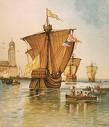





How to lose 93 million friends in ten days, or, When he started out he didn't know where he was going, when he got there he didn't know where he was, and when he got back he didn't know where he'd been, until he looked between his legs? The biggest TV reality show without teleprompter or cue cards? On Aug. 3, 1492 (same day the Jews are expelled from Spain by Ferdinand II and Isabella I) after receiving 17K ducats from baptized Jewish finance minister Luis de Santangel (-1498) (who talked the monarchs into it), and allegedly receiving a vision from the Holy Spirit to bear Christ to the West Indies (or a vision from the Devil to carry his Catholic Church there?), writing "I could feel his hand upon me to sail to the Indies... There was no question that the inspiration was from the Holy Spirit", 41-y.-o. Christopher (Gr. "Christ-bearer") Columbus (Lat. "dove") (1451-1506) (who is really working for the Illuminati, since his real name is Cristobal, i.e. "anointed of Baal or Satan", plus Colombo (It.) = Colom (Catalan) = Colon (Sp.) = anus?, and Lat. "paloma" = dove = penis?), and who has never been farther E than the Aegean S for Asia by going W instead of E, setting sail from Paloma, er, Palos, Spain for the island of La Gomera in the Canary Islands to pick up wine and water, getting into a romance with gov. Beatriz de Bobadilla y Ossorio (1462-1501) and staying for 1 mo. (returning in 1493 and 1498, when she marries somebody else), who gives him sugar cane cuttings, after which he sails for the "West Indies" (West Asia), thinking that his voyage will lead him to Cathay (China), Cipango (Japan), the Spice Islands (the Moluccas), then India in three ships with a total crew of 88, incl. five Marranos (converted Jews), incl. interpreter Luis de Torres, surgeon Marco, physician Bernal, and sailors Alonzo de la Calle and Gabriel Sanchez (who later sells Columbus on the idea of capturing 500 Indians to sell as slaves in Seville, becoming the beginning of Am. slavery); the crew is really Catalonian?; the ships incl. the caravel Pinta (Sp. "pint, spotted one") (the fastest), piloted by Martin Alonzo Pinzon (Pinzón) (1441-93), the caravel Nina (Niña) (Sp. "girl") (real name Santa Clara) (Columbus' favorite ship), piloted by his brother Vincente Yanez Pinzon (Yáñez Pinzón) (1461-1515) (who ends up going on all five of Columbus' voyages), and the 235-ton carack (nao) Santa Maria (real name Mariagallante = Gay Mary), Columbus' flagship (crew of 70) (Columbus calls it "La Capitana") (the Santa Maria was used in the 3rd voyage, but Christopher's son Ferdinand writes a history which starts the confusion going); since there are no watches yet to determine longitude at sea, Columbus sails first into the latitude of Cipango (Japan) (the Tropic of Cancer) and proceeds straight W, being helped greatly by the trade winds, which he discovers as he goes; after about 1 mo. at sea, the crew began getting nervous, so instead of continuing west and making landfall in the Carolinas, Columbus seizes on a sighting of a flock of birds migrating to the SW, changing course to follow and instead heading for the West Indies; on Oct. 10 the crew nearly mutinies, and makes Columbus promise to return home if land isn't sighted in two days (sounds like a fairy tale concocted later to make them seem to enjoy divine favor?); on Oct. 11 (10 p.m.) a UFO is sighted, consisting of "a light glimmering at a great distance", which disappears and reappears several times, moving up and down "in sudden and passing gleams" - let me guess, a welcome signal from ETs?
The Ultimate Thank God It's Friday? On Oct. 12, 1492 (Oct. 22 Gregorian) (Fri.) (2:00 a.m.) (after 36 days and 2.6K mi.), Pinta's crow's nest sailor Rodrigo de Triana (Juan Rodrigo Bermejo) (1469-?) does guess what, you guessed it, sights land (and later gets so pissed-off at not being given a reward that he moves to Africa and converts to Islam?), and Christopher Columbus (1451-1506) and his crew anchor at San Salvador (Sp. "Holy Savior") (Watlings) Island (called Guanahani by the aborigines) in the Bahamas just N of the Tropic of Cancer, at 23.5 deg. N 75 deg. W (the log books say 24 deg. N 75.5 deg. W) (named after pious pirate Watling, who forbade pillaging on Sundays, the residents renaming it San Salvador in 1926 to claim it as the place of Columbus' first landfall after 434 years of controversy, but it is never conclusively decided, with Cat Island and Samana Cay proposed), and Columbus dresses in full admiral's regalia to take possession of the new land in the name of Ferdinand and Isabella; having never seen a ship, the natives don't see them until a shaman convinces them that they're real, after which they greet Columbus with warm hospitality, causing him to write "They willingly traded everything they owned... They do not bear arms... They would make fine servants... They could easily be made Christians... With fifty men we could subjugate them all and make them do whatever we want"; after the natives present them with tobacco leaves, which they discard, they sail SW through the Great Bahama Bank, landing on Cuba on Oct. 17, thinking it is the Chinese continent, searching in vain for the magnificent cities described by Marco Polo; on Oct. 20 Columbus writes "I shall set sail for another very large island which I believe to be Cipango, according to the indications I receive from the Indians on board", which proves to be Hispaniola, and he finally lands on Haiti on Dec. 5. On Nov. 3 after invading France to punish it for supporting Perkin Warbeck, Henry VII of England forces them to agree to the Peace (Treaty) of Etaples (Étaples) (official end of the Hundred Years' War), in which France expels Warbeck and pays England an indemnity of £159K. In Nov. a gift of tobacco leaves from the Arawaks (Aruacans) is kept this time after Santa Maria crewman Rodrigo de Jerez learns to smoke from the natives, and brings back the habit to his hometown of Ayamonte, causing his wife to denounce him as a man who "swallows fire, exhales smoke, and is surely possessed by the devil", after which he is imprisoned by the Spanish Inquisition for seven years, by which time the super-addictive habit of smoking has caught on. On Dec. 21 (St. Thomas' Day) Columbus discovers Port St. Thomas in Haiti, and on Dec. 22 he has his first meeting with Marien chief (cacique) Guacanagaric (Guacanagarix) (Guacanagari), who allows him to found the settlement of La Navidad; too bad, the settlers are killed by a rival tribe before Columbus returns on his 2nd voyage. On Dec. 24 (Dec. 15 Old Style) Columbus writes in his journal that he is very impressed by the aborigines, who are of "pleasing appearance with fine features and medium height with muscular bodies", adding, "A better race there cannot be, and both the people and the lands are in such quantity that I know not how to write it... All here have a loving manner and gentle speech". On Dec. 25 the Santa Maria sinks off Hispaniola (La Espanola) (Haiti); it was first shot with a cannonball by Columbus' flagship to disable it on Caracol Beach, and rechristened Ft. Natividad, housing the men Columbus left behind until the natives attacked and burned it?; he left the men behind to force Isabella into financing a 2nd voyage?; her overseers, the fleet's master at arms, comptroller, and secy. were left behind to avoid being contradicted when he told Isabella he had discovered India? - she had to leave to give birth to Santa Claus? On Dec. 26 Columbus writes in his journal that he had been hoping to find gold "in so great quantity that the Sovereigns within three years would undertake and prepare to go and conquer the Holy Places [Holy Land]"; chickens and rats are introduced to America; smallpox is also introduced to native Ams. as a get-unwell card by 1518; Jews are also introduced next year, with Portuguese Jews settling in St. Thomas Island, later becoming the first large plantation owners, running sugar factories with 3K African slaves; too bad, when the new discovery doesn't fulfill the original mission of furnishing a route to India and China, desperation sets in, causing the need to milk the New World for plunder and profit to take over, resulting in a mean cold systematic mass murder machine that goes on for cents. and reduces the native pop. to almost nil; Columbus hangs natives 13 at a time in honor of Christ and the 12 Apostles?
On Sept. 24, 1493 Christopher Columbus begins his 33-mo. Second Voyage to the Caribbean in a grand fleet of 17 ships with 1.2K crew (incl. some free black Africans?), leaving the Canary Islands on Oct. 13, and arriving in the Bahamas in Nov., sighting Saint Martin Island on Nov. 11, becoming the first voyage to carry limes to prevent scurvy, planting the first sugar cane in the New World in Hispaniola, which has its first harvest in 1501, after which cane sugar mills are built in the 1520s in Cuba and Jamaica, along with hundreds in Brazil by 1540, causing a great need for African slaves to work the sugar cane fields, which leads to the Triangle Trade with Africa and Europe; he brings horses to the New World, albeit the West Indies only, leaving it to Cortez to bring them to the mainland in 1519; on Nov. 19 Columbus discovers Puerto Rico (Sp. "rich port") (Arawak name Boriquen), then reaches Espanola on Nov. 22, followed by La Navidad on Nov. 28, finding that 40 men previously left there are all dead, and on Dec. 7 founds the town of La Isabela on the N coast of Santo Domingo, becoming the first planned colonial town in the New World, which only lasts a few years after mismanagement, disease, hurricanes, and mutiny; he then sets off to the SE and discovers the Virgin Islands (almost 50 cays and islands), followed by St. Christopher (Kitts) (Liamuiga), Nevis, Antigua and Barbuda, and Montserrat (Sp. "saw-toothed mountain"), the twin butterfly-wing islands of Guadeloupe (Carib "Karukera" = island of beautiful waters) (and his first pineapples), Dominica (Lat. "Sunday") (discovered on Sun., Nov. 3) (home of Caribs who practice ritual cannibalism, which the Euros exaggerate to justify inhuman treatment of all Indians), and St. Thomas; he also discovers Jamaica, 90 mi. S of Cuba and 100 mi. W of Haiti, home to the unlucky Arawaks, and names it St. Iago (James); he first encounters the canoe (Sp. canoa) in use by Caribbean aborigines, whom he calls cannibals, because he observes the ferocious man-eating Caniba chowing down on tasty peop and hume? - stand by your man?


On June 24, 1494 Italian explorers John Cabot (1450-98) and his son Sebastian Cabot (1476-1557), discover North Am.?; he is actually Italian sea captain Giovanni Caboto from Genoa, changing his name to an English one to be PC? In Mar. 1496 Henry VII of England commissions them to search for a northerly route to China (Asia), and they leave in the summer on one ship, but run out of supplies and encounter bad weather, turning back. On May 2, 1497 Cabot leaves on his first voyage in the Matthew of Bristol, owned by English merchant (of Welsh descent) Richard Amerike (Ameryk) (1445-1503), trying a course far to the N of Columbus', and on June 24 (St. John the Baptist's Day) discovers Cape Breton Island and Newfoundland, becoming the first white Euros to rediscover the mainland of North Am., returning on Aug. 6 with news of fish not gold, so people are unimpressed; since Amerike backed earlier expeditions of Bristol sailors to Newfoundland as far back as 1479, and his family coat of arms is stars and stripes, some later argue that America was named for him not Amerigo Vespucci; the Chinese have a gold mining operaton on Cape Breton Island, that soon eats shoots and leaves?
On Mar. 10, 1496 Columbus departs La Isabela for Spain, reaching Portugal on June 8, ending his second voyage in 2 years 8.5 mo.; Romano Pane, a monk who went on the voyage becomes the first to describe the tobacco plant; Columbus writes to Ferdinand and Isabella: "We can send from here, in the name of the Holy Trinity, all the slaves and brazilwood which could be sold. If the information I have is correct, we can sell 4,000 slaves, who will be worth at least 20 millions, and 4,000 hundredweight of brazilwood, which will be worth just as much."

On July 8, 1497 Portuguese explorer Vasco da Gama (1460-1524) sails from Lisbon in four ships for a voyage around Africa to India, and rounds the Cape of Good Hope on Nov. 22; his voyage is long enough for scurvy to be discovered. Just what the Indians need? On May 20, 1498 Portuguese explorer Vasco da Gama (1460-1524) becomes the first European to sail around Africa to reach India as he arrives in Kappakadavu near Calicut (Calcutta) on the Malabar coast, finding that Arab merchants already live there; on Aug. 29 he departs for Portugal, sailing against the monsoon winds, taking 132 days to reach the Arab-run coastal town of Malindi (pop. 6K) next Jan. 7 (vs. 23 days the other way to India), during which time half of his crew dies, and the rest get scurvy; Game Vasco meets with the sheik of Malindi to sign a trade agreement, and hires a guide for his voyage to India, erecting a coral pillar, which survives to modern times; next year the Portuguese establish a trading post in Malinda, followed in 1509 by a custom house, which is abandoned in 1512, although Malindi remains the center of Portuguese activity in E Africa until 1593; the discovery of the sea route to India (bypassing the Muslim-infested Mediterranean) opens the Age of Global Imperialism, with round-trip distances longer than round-the-globe voyages along the equator. On Dec. 25, 1498 (Christmas day) Vasco da Gama sights and names the South African country of Natal (Birthday). In Sept. 1499 after two of his ships precede him in July-Aug., Vasco da Gama arrives in Lisbon, and is welcomed as a hero and awarded the title "Admiral of the Indian Seas" along with Dom (lord) by Manuel I, the latter title also being awarded to his siblings and their descendants; meanwhile Venice is shocked by news of a new sea route to India threatening its commercial supremacy, causing it to eventually begin building an inland empire (Padua, Verona, Cremona et al.) - I still got gama? On Feb. 12, 1502 after receiving the title of adm. in Jan., Vasco da Gama (1460-1524) leaves Lisbon on his Second Voyage around Africa with 20 ships, discovering the Seychelles, then arriving in Calcutta on Oct. 30, killing Muslims and spreading Christianity all the way, after which he founds and gives Portuguese protection to Cochin (Emakulam), the first European settlement in India, and the center of Roman Catholic penetration. In Feb. 1503 after wreaking savage vengeance at a trading station in Calcutta, Vasco da Gama leaves India for Portugal; Alfonso de Albuquerque and his cousin Dom Francisco da Alameda help create the first Portuguese fortresses and trading posts in Cochin and Quilon, laying the foundation stone of Fort Cochin (Kochi) on Sept. 26; Unniram Koyikal I dies, and Unniraman Koyikal II (-1537) becomes ruler of Cochin (until 1537).
On May 30, 1498 Christopher Columbus leaves Sanlucar, Spain on his Third Voyage with six ships, arriving on July 31 on Trinidad (Sp. "Trinity") (named after three mountains on the SE side) (the Arawaks and Caribs call it "land of the hummingbird") off the coast of Venezuela, then discovering the sister island of Tobago (Indian name Tobaco, from the tobacco grown there) 20 mi. to the NE (later believed to be the site of Daniel Defoe's "Robinson Crusoe"), then the island of Grenada (not colonized); he then visits the coast of South Am., sighting the mouth of the Orinoco River, believing it to be flowing out of the Garden of Eden; he arrives at Hispaniola on Aug. 19.
In May 1498 after receiving honors from Henry VII along with new letters patent in Feb., Venice-born London explorer John Cabot begins his Second Voyage with five ships, travelling hundreds of miles down the ragged E coast of North Am. incl. Labrador and Newfoundland, after which one ship returns damaged by a storm; he either wrecks near Grates Cove and dies, or returns in spring 1500 and dies 4 mo. later.



On Apr. 6, 1499 after being sent by Manuel I of Portugal, Italian explorer Amerigo Vespucci (1454-1512) allegedly reaches the South Am. mainland, then returns to Cadiz on Oct. 15. On May 16, 1499 Alonzo de Hojeda (Alonso de Ojeda) (1468-1515) (cmdr.), Amerigo Vespucci (1451-1512) (pilot), and Juan de la Cosa (the Biscayan) (1450-1510) (navigator and cartographer, co-discoverer of America with Columbus and owner of the Santa Maria) leave Cadiz, Spain, and sail to the mouth of the Amazon River, discovering Curacao (Curaçao) (40 mi. N of Venezuela) and Bonaire on July 29, and Lake Maracaibo on Aug. 9, naming Venezuela (Sp. "little Venice") for Venice because the inhabitants live in houses built over the water; they also explore the Arawak island of Aruba 18 mi. off the coast of Venezuela; Ojeda becomes the Neil Armstrong of (first white Euro to set foot on) the South Am. continent; after discovering the Amazon River, they sail to Cape de la Vela, then reach Espanola with slaves and pearls, only to be accused of trespassing on Columbus' turf; Vespucci observes Venezuelan natives chewing coca leaves, writing: "They kept this herb in their mouths to stave off thirst." In Sept. 1500 Vespucci returns to Spain. On May 14, 1501 Vespucci leaves Lisbon and sails along the coast of South Am., spreading joy to the natives, and convincing himself that this isn't Asia but a vast unexplored new continent, which he calls Mondus Novus (the New World). On Jan. 1, 1502 Amerigo Vespucci reaches Bahia de Todos Santos, then travels down the coast of South Am. to the River Plata; he returns to Lisbon on July 22, and concludes that South Am. is an independent continent, and is not India. In 1502 Vespucci pub. Letters About the American Indians; explicit soft-core letters with juicy details about how they go around naked, their sexual habits, cannibalism, communism, etc., which go through many reprints in many languages throughout the cent., becoming one of the first printed bestsellers - the first porno on the Internet? On June 18, 1504 Vespucci returns to Lisbon. In 1507 the name "America" is first used by German cleric-cartographer Martin Waldseemueller (Waldseemüller) (1470-1520) of the Monastery of Saint-Die-des-Vosges in Lorraine, France in his Cosmographiae Introductio in honor of Amerigo Vespucci; it contains a world map titled Universalis Cosmographia incl. the first depiction of the Western Hemisphere, showing America as an island surrounded by water, and saying "It is fitting that this fourth part of the world, inasmuch as Americus discovered it, be called Amerige, or let us say, land of Americi, that is, America"; the depiction of a body of water to the W of America before the discovery of the Pacific Ocean remains a modern mystery; on Apr. 30, 2007 (500th anniv.) it is officially given to the U.S. by German chancellor Angela Merkel.


In Oct. 1499 after sailing with Christopher Columbus on his 2nd Voyage and promising to give the Spanish crown one-fourth of his net profits, Spanish explorer Rodrigo de Bastidas (1460-1527) leaves Cadiz for the New World, going on to map the N coast of South Am., discover Panama, and found the city of Santa Marta - we can laugh even while having problems, amen?


On Jan. 26, 1500 Brazil (named after brazilwood, which produces a valuable red dye) is discovered by Spanish sailor Vicente Yanez Pinzon (1461-1513) in a 4-ship fleet at Cape Santo Agostinho (Cabo Santa Maria de la Consolacion) near Cape Sao Roque; his four ships then turn NW and discover the estuary of the Amazon River 4 mo. later, mistaking it for the Ganges River and naming it Rio Santa Maria de la Mar Dulce; Pinzon then sails between Trinidad and the mainland and reaches the Gulf of Paria in Venezuela on May 1, then turns N, passes the Windward and Leeward Islands to the W, followed by Puerto Rico and Hispaniola to the N, then NW through the Bahamas, where he loses two ships, then returns to Palos in Sept.; meanwhile on Apr. 22 (24?) after leaving Lisbon on Mar. 9 with 13 ships and 1K crew on a royal trade expedition to India along Vasco da Gama's route along the Cape of Good Hope, Portuguese sailor Pedro Alvares (Álvares) de Cabral (1467-1526), lands in Brazil, claiming it for his king under the name Island of the True Cross; his shipmate Diogo Dias dances on the beach to the pipes of the Tupiniquim, easing their fears; Cabral sails for India after leaving a small force there; after losing half his fleet in a storm, he reaches SW India and founds the first Euro settlement in India in Cochin (Kochi), then reaches Calcutta and establishes a factory there; his co-capt. Pero (Pedro) Vaz de Caminha (1450-1500) writes to the king of Portugal about newly-discovered Brazil that "The best fruit that can be taken from it... will be saving its people" (by Christianizing them).

In summer 1500 Portuguese explorer Gaspar Corte-Real (1448?-1502) leaves Lisbon, and discovers Newfoundland ("Terra Verde"), visiting varous points between Labrador and the Bay of Fundy; in May 1501 he returns to Newfoundland, charts about 600 mi. of the Labrador coast, then disappears mysteriously at sea in 1502 after sending back two of his vessels; in 1503 King Manuel I sends another expedition to learn his fate, but they return after finding nothing, causing him to forget the idea of a Northwest Passage and concentrate on India; an archeologist later discovers evidence that he reached Mass. and lived until the year 1511 - lost and found land?
On Aug. 10, 1500 (St. Lawrence's Day) Portuguese explorer Diogo Dias becomes the first Euro to sight Madagascar, naming it Sao Lourenco, connecting it with the Arabic Island of the Moon reported in 1490 by Portuguese explorer Pero (Pedro) da Covilha (Pêro da Covilhã) (1460-1527).
In Mar. 1501 after Rodrigo de Bastidas reaches Venezuela, then Colombia, he discovers the Magdalena River, finally exploring the whole coastline from Cape de Vela to the Gulf of Darien, incl. the coast of Panama.
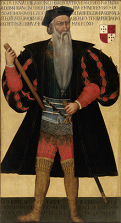
In 1501 Portuguese explorer Joao de Nova (1460-1509) discovers Ascension Island off the W coast of Africa; too bad, he fails to report it, causing fellow Portugese explorer Alfonso de Albuqeurque (1453-1515) to rediscover it in 1503 on Ascension Day (40th day of Easter) and name it; otherwise barren, it is a good place to hunt egg-laying green turtles. In 1502 de Nova discovers uninhabited Saint Helena Island in the S Atlantic Ocean 1.2K mi. W of Africa on the same latitude as the Angolan-Namibian border.

On Feb. 12, 1502 after receiving the title of adm. in Jan., Vasco da Gama (1460-1524) leaves Lisbon on his Second Voyage around Africa with 20 ships, discovering the Seychelles, then arriving in Calcutta on Oct. 30, killing Muslims and spreading Christianity all the way, after which he founds and gives Portuguese protection to Cochin (Emakulam), the first European settlement in India, and the center of Roman Catholic penetration.



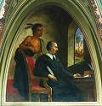
On May 11, 1502 after being returned to favor and getting an order last Sept. 3 to replace his enemy Francisco Bobadilla, Christopher Columbus (1451-1506) begins his Fourth Voyage (last), leaving Cadiz with four ships (Capitano, Vizcaino, Santiago de Palos, El Gallego) and 140 men, with instructions to discover the Malacca Straits and not engage in trade, carrying a 2-year supply of food and Arabic speakers, arriving in Hispaniola on June 29, along with new gov. (until 1509) ordered by newly-appointed Hispaniola gov. (1502-9) Nicolas de Ovando y Caceres (Nicolás de Ovando y Cáceres) (1460-1518); (a lares or cmdr., and member of the Military Order of Alcantara), future Incan Conquistador Francisco Pizarro Gonzalez (1471-1541), and future Dominican missionary Bartolome (Bartolomé) de las Casas (1484-1566), who accompanied him on his 3rd voyage in 1498, and starts out as a planter; Columbus arrests Bobbin' Bob and ships him to Spain, where he dies in a thrilla' of a shipwreck caused by a hurricane; Columbus goes on to discover Martinique (400 mi. NE of Venezuela), reaches Nicaragua on July 30, seizes a large native canoe containing cacao beans on Aug. 15, visits Costa Rica on Sept. 18, and lands in Portobelo (Porto Bello) (Sp. "Beautiful Port) in Panama on Nov. 2 and plants a colony; the Chibchan-speaking Cuna-Cuna (Cuna) (Kuna) (Guna) (San Blas) (Tule) Indians of Panama have several cases of hereditary albinism, causing legends of white Indians to arise; Ovando later becomes gov. of Santo Domingo, bringing 1.5K Spanish families to populate it and spread their seed into the new white Lebensraum, while instituting hyper-cruel genocidal measures against the West Indies aborigines, which reduce them from 500K in 1492 to 60K in 1507 - pardon me while I vomit?
In 1502 Portuguese traders take the first peanuts from Brazil and Peru to Africa; they reach China by 1573.
In 1503 Portuguese merchant-explorer Antonio de Saldanha discovers Table Bay at the N end of the Cape Peninsula at the base of Table Mountain in South Africa (later home of Robben Island of Nelson Mandela fame).
In 1505 Sri Lanka (Ceylon) is discovered by Portuguese explorer Lourenco de Almeida (1480-1508) (son of Francisco de Almeida), who founds a settlement.
In 1505 Spanish navigator Juan de Bermudez (Bermúdez) (-1570) discovers Bermuda (650 mi. E of N.C.). in his ship La Garza en route from Hispaniola to Spain.

In 1506 after having to pass up a job as viceroy of India due to temporary blindness, Portuguese explorer Tristao da Cunha (1460-1540) (cousin of Afonso de Albuqueraue) sails to the E coast of Africa in a fleet of 15 ships to conquer Socotra Island, discovering the five volcanic Tristan da Cunha Islands 1.2K mi. from Saint Helena Island, the most remote archipelago on Earth, which remains uninhabited until 1810, visiting Madagascar and Mozambique before conquering Socotra - you don't even have a rear window wiper?


You're ruining my genius career, you bum? In 1506 Ferdinand Magellan (1480-1521) sets out on his first expedition to the East Indies to install adm. Dom Francisco de Almeida (1450-1510) as the first Portuguese gov. (viceroy) of the East Indies, incl. India, where he works to exclude Muslims and Venetians from a slice of the commerce pie - I want to give you this Capitol One check for a million dollars? Nothing beats jellin' like Magellan? On Sept. 20, 1520 after spending more money on sherry than weapons, Ferdinand Magellan (1480-1521) leads an expedition of 237 men sailing from Spain in five small ships incl. flagship Trinidad, Concepcion, San Antonio, Victoria, Santiago in search of a westerly route to the Spice Islands in Indonesia (the Indies), which ends up circumnavigating the globe, starting by crossing the equator on Nov. 27 and sighting South Am. on Dec. 6, reaching modern-day Rio de Janeiro on Dec. 3, then sailing S to Rio de la Plata in Feb. 1520, and overwintering in Puerto San Julian in Argentina, surviving a mutiny on Easter (Apr. 1-2); on Oct. 21, 1520 they reach Cape Virgenes and begin navigating the Magellan Strait between South Am. and Tierra del Fuego (later site of the city of Punta Arenas, Chile, southernmost city on Earth); after mistakenly believing that native Tehuelches are giants, he names Patagonia from the Spanish word pata or feet, "Land of the Bigfeet"; actually they avg. 5'11", compared to 5'1" for the Spaniards, but it takes until the end of the 18th cent. to debunk the myths; on Nov. 28 after one is wrecked in a storm and the other returns to Spain, three of the five ships sail into the Pacific Ocean, which Magellan names because of how calm and peaceful it is compared to the Atlantic (how could he know about them hurricanes?); 98 days later they reach the Philippine Islands. On Feb. 28, 1521 after discovering the Northern Mariana Islands (Guam, Rota, Saipan, Tinian, Asuncion), and naming them "Ladrones" (Sp. "thieves") for the thievish practices of the native Chamorros, Magellan and his men reaching Guam ("land of sails", named for their lateen sails) and find supplies, then take off and sight the Philippine Islands; on Apr. 27 (dawn) Magellan is KIA in the Battle of Mactan with the islanders led by chief Lapu-Lapu before he can circumnavigate the globe; one of the three remaining ships is abandoned, and the last two set sail, with the Victoria commanded by Magellan's 2nd-in-command Juan Sebastian de Elcano (del Cano) (1476-1526), who changes Magellan's plan and sails W into the Indian Ocean, reaching the Spice Islands on Nov. 6 with 115 crew, sailing around the Cape of Good Hope on May 6, 1522 and limping home on Sept. 6, 1522 with 18 aboard, making a small net profit from their cargo of 26 tons of cloves and cinnamon.
In 1507 after discovering Socotra Island in 1503, Portuguese navigator Diogo Fernandes Pereira discovers volcanic mountainous reefed Mauritius Island 500 mi. E of Madagascar, naming it Ilha do Dirne, but doesn't settle it; he also discovers the rest of the Mascarenhas Archipelago incl. Mauritius, Reunion, and Rodrigues, becoming the first Euro to sail E of Madagascar.

On Mar. 1, 1510 after getting caught stealing cattle, a Portuguese exploration party led by Portuguese viceroy Dom Francisco de Almeida (b. 1450) (first Portuguese viceroy of India) is massacred at Table Bay by the native Khoikhoi (Hottentots), who kill 64 soldiers and 11 captains along with Almeida, causing the Portuguese to decide to stick to the E coast of Africa.


In 1510 after what's left of his party (100 of 600) flees to yet another harbor, Spanish conquistador Diego de Nicuesa (1464-1511) utters the soundbyte "Let's stop here in the name of God", and they found Nombre de Dios (Sp. "Name of God") on the Atlantic coast of Panama, which becomes a major port of call for the Spanish treasure fleet, and the first Euro town in Panama and the Am. mainland; too bad, it is situated near an unhealthy swamp, and is hard to fortify, and by 1580 Veracruz, Mexico becomes more popular; meanwhile the party of Alonso de Ojeda (1465-1515) founds the colony of San Sebastian, then is forced out by the Indians, after which he sets out for Hispaniola, leaving Francisco Pizarro in charge, then gets shipwrecked before reaching Santo Domingo, croaking in 1515; meanwhile on Sept. 1 Ojeda's rich atty. friend (financial backer) Martin Fernandez de Enciso (1470-1528) heads out from Espanola, with poor ignorant pig farmer Vasco Nunez (Núñez) de Balboa (1474-1519) of Hispaniola stowing away on his ship to avoid creditors, after which he is discovered then talks him into going to the Gulf of Uraba, where they find San Sebastian deserted, then talks him into going to the W side of the gulf, where they found Santa Maria de la Antigua; too bad, yellow fever and malaria reduce the 800 original Spanish pop. to 60, causing them to revolt and elect Balboa as chief, after which in mid-Nov. a relief force for Nicuesa led by Rodrigo Enriquez de Colmenares arrives, finding Nicuesa in Nombre de Dios with far less than 100 men; too bad, Nicuesa throws a feast, gets drunk, and boasts of all the hell he will put his enemies through when he gets to Antigua, causing everybody to consider him a lunatic, after which Nicuesa makes a mistake and allows ambassadors to be sent ahead of him who spread the word. On Jan. 12, 1519 after clashing with Panama gov. Pedro Arias de Avila, Vasco Nunez de Balboa (b. 1474) is framed then beheaded for treason - tresor chocolat?
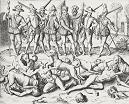
What's that noise? In Mar. 1511 insane tyrant Diego de Nicuesa is voted out of power in Antigua and deported on a dilapidated ship that wrecks en route to Espanola, killing all aboard; meanwhile after sending Enciso back to Spain, Balboa has fun enslaving and looting the local pop. the Catholic Spanish way, incl. setting wild dogs on same-sex married females (lesbians), gays, and other Indians he thinks are too un-Christian to fool with; after cents. of suppression of same-sex marriage and homosexuality, followed by a coverup for the winning side, in 2004 U.S. Pres. George W. Bush utters the immortal soundbyte: "The union of a man and woman is the most eduring human institution, honored and encouraged in all cultures and by every religious faith."
In 1512 after setting sail from Malacca last Nov. with three ships led by the Santa Catarina, along with 120 Portuguese and 60 slaves guided by Malay pilots, Portuguese navigator Antonio de Abreu (1480-1514) sails through Java, the Lesser Sunda Islands, and Ambon Island, discovering Timor (Malay "timur" = east) at the E end of the Lesser Sunda Islands (modern-day pop. 3.1M), and the 10 volcanic Banda Islands 2K km E of Java (modern-day pop. 18.5K), world's only source of nutmeg and mace.
In 1512 Juan Ponce de Leon discovers the Turks and Caicos Islands, going on to capture and enslave the Taino and Lucyan natives for work in Hispaniola, depopulating them by 1513 and not recovering until the 17th cent.
In 1512 Portuguese explorer Pedro Mascarenhas (1470-1555) discovers Diego Garcia in the Indian Ocean, and reaches Mauritius in the Mascarene Islands.
In 1512 Portuguese explorer Francisco Serrao (-1521) (cousin of Ferdinand Magellan) discovers Malacca near the Strait of Malacca in the S Malay Peninsula, sailing E through Indonesia and the East Indies and becoming a personal advisor to Sultan Bayan Sirrullah of Ternate.

On Jan. 20, 1513 Vasco Nunez de Balboa writes a letter to the Spanish king containing the first known reference to El Dorado, a one-stop-shopping center for gold smelting, mentioning the Panamanian cacique Dabaibe (Dabeiba), whose people like to live in trees. Big year for surfers? On Sept. 25, 1513 (27?) after receiving reinforcements from Spain along with the title of capt.-gen. of Antigua, and hearing that his enemy Martin Fernandez de Enciso has been bringing charges of usurpation against him, making it necessary to do something big (turn some profit) to stay in power, then leaving on Sept. 1 with 190 Spaniards and 1K Indians to search for a great body of water described by an Indian friend, and fighting off pesky natives in dense jungles and swamps, Vasco Nunez (Núñez) de Balboa (1474-1519) climbs solo to a mountain peak and becomes the first Euro to see the Pacific (Peaceful) Ocean (Great South Sea); four days later he and his men reach the ocean and claim it and all shores washed by its waters as a possession of the Spanish (Castilian) crown, with Balboa wading into the sea in full armor to jazz it up, returning next Jan. with a treasure of loot incl. 40K pesos in gold, plus pearls and slaves; meanwhile on July 27 the king appoints 72-y.-o. Pedro Arias de Avila (Pedrarias) (1442-1531) as gov., and next year he sets out in 20 ships with 2K men and women, incl. Francisco de Coronado, Hernando de Soto, Diego de Almagro, and Pascual de Andagoya; meanwhile Balboa founds Castilla del Oro (Darien) on the base of the Isthmus of Panama on the South Am. mainland, with Spanish 1.5K colonists; the currency of Panama is later named after him (Costa Rica goes for Cristobal Colon, er, Christopher Columbus); the (rocky?) Balboa Monument is inagurated in Panama City on Sept. 29, 1924; Ferdinand Magellan names the Pacific Ocean in Nov. 1519; the Pacific is actually anything but peaceful during the hurricane season, but people get less seasick on it than they do on the Atlantic Ocean when rounding the Horn?

On Mar. 4, 1513 Puerto Rico gov. Juan Ponce de Leon (León) (1460-1521) sets out from Puerto Rico with 200 men, sighting Florida (Fla.) (Sp. "flowery") on Mar. 27 (Pascua Florida) (Easter Sunday), naming it, and planting orange and lemon trees there; the Fountain of Youth, allegedly to be found at a mysterious place called Bimini he looks for but doesn't find, and the Spanish end up launching six unsuccessful expeditions by 1563 to colonize Fla. In July 1521 Juan Ponce de Leon (b. 1460) dies in Havana, Cuba, having failed to capitalize on his royal patent to colonize Fla., although he introduces cattle and swine, which run wild in the swamps; after his death rumors circulate that he was searching in Fla. for the Fountain of Youth - there weren't enough wealthy swine-chomping Jewish senior citizens yet?

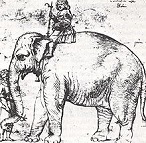
On Mar. 12, 1514 Portuguese explorer Tristao da Cunha (1460-1540) marches down the streets of Rome in an elaborate procession to present the new conquests of Portugal to Pope Leo X, who receives them at Castel Sant'Angelo; the procession features pet white Indian elephant Hanno the Elephant (1510-16), (given to him by the king of Cochin), whom popey adopts, becoming his favorite pet, dying two years later from complications of treatment for constipation with a gold-enriched laxative.

On Feb. 8, 1517 Spanish conquistador Francisco Hernandez de Cordoba (Francisco Hernández de Córdoba) (-1517) leaves Havana in three ships with 100 men, and lands on the Yucatan Peninsula while on a slave-hunting expedition from Cuba, discovering traces of the once-great Mayan civilization;he gets the name Yucatan straight from the local Mayans, who reply "Yukatan" ("I don't understand you") when he asks them their name?; an attempt by Hernan Cortes to defame his rival Diego de Velazquez in a letter to the king of Spain, the Nahuatl word "Yokatlan" meaning "place of richness" all along?

In 1516 Spanish explorer Juan Diaz de Solis (1470-1516) reaches the mouth of the Rio de la Plata (Sp. "silver river") (confluence of the Uruguay and Parana Rivers) region of South Am., and discovers "Purple Land" Uruguay (filled with small purple flowers); he later is killed with his landing party on the banks of the river by fierce dark heavy-set semi-nomadic Charrua aborigines while searching for a passage to the Pacific Ocean; the Charruas get their hackles up and prevent colonization until 1624, adopting horses and bolas until they are finally exterminated by the first pres. of Uruguay in 1831.

On Apr. 8, 1518 Spanish conquistador Juan de Grijalva (1489-1527) sails with 170-300 people on four ships from Matanzas, Cuba to Yucatan, discovering Cozumel and arriving on May 1 in Tobasco, where he first observes cigarette smoking, renaming the Tobasco River Rio Grijalva, then discovers Mexico and names it New Spain to thank them for not smoking; on Dec. 18 the Spanish start a smallpox epidemic among the aborigines in Santo Domingo, which soon spreads to Yucatan, Mexico, and Peru, ultimately killing 20M (50%-90% of the indigenous pop.), and clearing the way for smoke-free Euros.

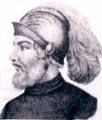



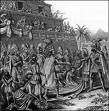


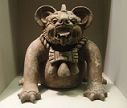
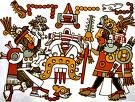
In 1518 Diego de Velazquez is appointed gov. of Cuba by the king of Spain; he and Hernán (Hernan) Cortes (1485-1547) organize a military expedition to Mexico, with Cortes countermanding Velazquez's orders and following the coast of Yucatan, clashing with Indians in Tabasco and reaching San Juan de Ulua (Ulúa) on the Gulf of Mexico near modern-day Veracruz; the Tabasco natives give Cortes several hot women, incl. Malitzin (Doña Marina) (Malinche), a Mexican slave who speaks Mayan and Nahuatl and becomes his common-law wife and official interpreter. In Feb. 1519 Spanish conquistador Hernan Cortes (Hernán Cortés) (1485-1547) renounces the authority of Diego de Velazquez, relocates the city of Havana (from the Indian name Guanabacoa meaning "site of the waters") in Cuba to the N coast as a Spanish naval base (modern pop. 2M), then takes off with on 11 ships with 400-600 men (70 musketeers, 40 crossbowmen, and several hundred Indian and Cuban servants), incl. 2nd-in-command Pedro de Alvarado y Contreras (1495-1541) and chronicler Bernal Diaz del Castillo (1496-1584) for New Spain (Mexico), and on Apr. 21 he lands in Veracruz with his well-armed men, 16 horses, 14 pieces of artillery, and a big pair of balls, and founds the city of Villa Rica de la Veracruz (Vera Cruz) (Sp. "true cross") in Mexico after burning his own ships to keep his men from returning to Cuba; after his soldiers elect him as chief magistrate and send reps to the crown for confirmation, Cortes leaves a small garrison then begins travelling through Aztec villages, finding altars piled with skulls and smelling of rotten blood mixed with flowers while sending envoys to Emperor Montezuma (Moctezuma) II (1480-1520, who is zapped out by the belief that these white dudes are gods and Cortes is pale-faced feathered-serpent man-god Quetzalcoatl (whose arrival is predicted by the Mayan priests this year after some lost Viking stumbled ashore long ago?), and avoids confrontation; Cortes gains support from the Totonacs, then ends up in 11K-ft. mountains where their clothing is inadequate, and several servants die, then crosses desert salt lakes without food and water, until he comes to the independent city of Tlaxcala, and faces 149K fierce warriors with obsidian clubs and spears, holding out for two weeks on a little hill until they suddenly give up, welcome him as a friend, and offer him their daughters, then offer to help him fight their worst enemies the Aztecs (Mexica); on Mar. 12 Cortes and his men arrive in Potonchan (Potonchán) on the left bank of the Grijalva (Tabasco River), finding them hostile, after which on Mar. 25 they win a V over the Aztecs at the Battle of Centla, where Diego de Ordaz (1480-1532) distinguishes himself, going on to climb 17,802 ft. (5,426m) Popocatepetl (Popocatépetl) in C Mexico 40 mi. SE of Mexico City with two comrades, becoming the first white Euros, impressing Cortes native allies, after which HRE Charles V authorizes Ordaz to pus the volcano on his coat of arms; after passing through the narrow streets of Cholula (known for its Great Pyramid) Cortez and his men meet fierce resistance, incl. rooftop ambushes, and kill 3K and sack it, the news reaching Montezuma, who says his heart is "washed in chilies" with grief; Cortes brings horses to the Am. mainland for the first time? Fun in the sun of Mexico NOT, or How 500 white men conquered 7M-30M red men suffering from auto-reverse racism, and reduced their pop. to 3M in 50 years? In Mar. 1520 displeased at the resistance of Hernan Cortes to his authority as gov. of Cuba, Diego Velazquez sends an expedition under Panfilo de Narvaez (Pánfilo de Narváez) (1470-1528) from Havana, which lands at San Juan de Ulua on Apr. 23 and captures Cempoala; in May Cortes leaves Tenochtitlan under the protection of Pedro de Alvarado and 200 men, then defeats Narvaez on May 26 and takes him prisoner at Vera Cruz, persuading his men to join him. Like a cheating husband who won't go away? In June 1520 Cortes returns to Tenochtitlan, where Montezuma II always gets a kick out of watching Spanish soldiers play cards, and observes Aztecs (Mexica) writing with lead crayons (pencils?), but this time the cocoa bean-bartering Aztecs have had it up to there with Cortes and his cruel lt. Alvarado, who attacked warriors during religious celebrations, and believing their king has lost his aura, on June 30 they stone Montezuma II while trying to persuade them to kiss white Spanish butt from the palace roof (he dies on July 3), then trap and cut off Alvarado and his men, destroy the three bridges leading out of the island city, and siege them, but Alvarado makes a portable bridge out of ceiling beams and sneaks out at midnight; too bad, he is spotted halfway across, saves his life by jumping over Alvarado's Leap in the causeway, and loses three-fourths (800) of his men killed or captured (later used for sacrifices to the war god) before escaping and regrouping with Cortes under a huge ceiba (silk-cotton) (kapok) tree in what becomes known as La Noche Triste (the Sad Night), in which Cortes sits under the tree and weeps; after making sure his shipbuilder Martin Lopez is still with him, he says, "Okay, let's go, for we lack nothing", and they head back to their race-traitor allies in Tlaxcala; meanwhile Montezuma II (b. 1479) is succeeded as Aztec king by his younger brother Cuitlahuac (Cuitláhuac) (1476-120), who prepares to finish Cortes off, but on July 7 Cortes kicks their butts in the Battle of Otumba, with 100K-200K Aztecs getting their butts kicked by 500 Spaniards and a few hundred Tlaxcalans, losing only 73 Spanish KIA; in late Sept. after a reign of 80 days Cuitlahuac dies of the smallpox, and is succeeded by Montezuma II's nephew Cuauhtemoc (Cuautehmóc) (Cuitlahuac) (d. 1521), the last Aztec ruler; Cortes returns to Tlaxcala, receives reinforcements, and ends up making Texcoco his base on Dec. 31 while he prepares to return with 600 men and tens of thousands of native allies, having a stroke of genius and building a fleet of 13 40-ft. brigantines on land, which he has disassembled to be hauled overland by 8K native porters back to Tenochitlan for a final siege. On May 26 1521 Hernan Cortes sieges Tenochtitlan, and on Aug. 13 he defeats the Aztecs after 80 days of starving the 250K pop. (a tactic unknown in their history?), reducing them to eating lizards and grass, capturing 800 women and children foraging at night for food, then taking the city street by street until the Aztecs, reeling from starvation, white man's measles and smallpox make their last stand at the stacked pyramid of Tlatelolco, sister city of Tenochtitlan to the N; the Aztec Empire (founded 1428) ends (7M-30M people torpedoed by a few hundred Satanists, er, Saints, er, Spaniards?), and the Spanish Empire in Am. begins with the forceful seizure of Mexico, which becomes known as New Spain (until 1821), with Cortes as viceroy #1 (until Dec. 24), followed by Cristobal (Cristóbal) de Tapia (until Dec. 30), followed by Cortes again (until Oct. 12, 1524) after Tapia clears him of misconduct; Cortez sees bison in Montezuma's menagerie; in 1524 Mexico City is founded on the razed ruins of Tenochititlan after the lake is filled-in by Aztec slaves; king #4 (since 1487) Cosijoeza (Cocijoeza) (-1529) of the nearby Zapotecs in SE Mexico hears of the Spanish V and decides to lay low to avoid the same fate, allying with the Mixtecs (Mixteca) in modern-day Oaxaca, Guerrero and Puebla, but that doesn't stop the Spanish from attacking them next year, and subduing them by 1527, the Zapotec bat god and Mixtec jaguar god proving impotent against Spanish cannon, firesticks, and biological warfare.
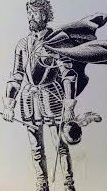
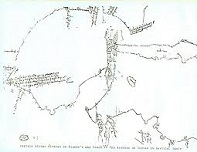
In Mar. 1519 with backing from gov. Francisco de Garay, Spanish explorer Alonso Alvarez (Álvarez) de Pineda (1494-1520) leaves Santiago, Jamaica with three ships and 270 soldiers, exploring and mapping the Gulf of Mexico coastline, establishing that Florida is a peninsula instead of an island; on June 2 he reaches Mobile Bay (Alabama River), then discovers the mouth of the Mississippi River, and reaches Corpus Christi Bay in Tex. on June 24 (Feast of Corpus Christi), making the first known map of the Gulf Coast region of the U.S. incl. Texas, anchoring off Villa Rica de la Veracruz shortly after Hernan Cortes leaves, causing the latter to turn around to meet him, after which Pineda attempts in vain to negotiate a boundary between the lands they claim, then sails N to the "Las Palmas" (Panuco) River, landing near modern-day Tampico and spending 40+ days repairing his ships; too bad, next Jan. the Huastecs attack and kill him, although 60 colonists are evacuated by Diego de Camargo.
On Aug. 15, 1519 Pascual de Andagoya (1495-1548) founds Panama City as the seat of govt. for Pedro Arias de Avila, bringing in 400 (later 1.5K) settlers, incl. Hernando de Soto; Avila refounds Nombre de Dios on the Alantic side, and clears a route across the isthmus; Panama City becomes the base for Spanish exploitation of the W coast of South Am., incl. the unfortunate Incas, whose treasure later flows in from the coast, is loaded onto mules, and transported over the jungle trail to Porto Bello on the Caribbean for loading onto Spanish galleons.
In 1523 Portuguese sailor Simao de Abreu discovers Celebes (Sulawesi) in the Greater Sunda Islands in Indonesia E of Borneo, followed in 1525 by Gomes de Sequira; a base is established in Makassar, which is taken by the Dutch in 1665 after arriving in 1605.


Welcome to Hurricane Country? In Apr. 1528 the Narvaez (Narváez) Expedition, led by 1-eyed Spanish explorer Panfilo de Narvaez (Pánfilo de Narváez) (1470-1528) sails from Cuba with 300 soldiers and colonists in an attempt to colonize Florida (Fla.) (Sp. "land of flowers"), and lands on Apr. 14 near Cape Corrientes after discovering Pensacola Bay in the Fla. Panhandle; after exploring a dismal swampland filled with people who don't want them they end up in Tallahassee, and on Sept. 22 they set sail in five crude barges and try to reach the Panuco River, but get shipwrecked in Nov. on the Texas coast, where he tells his men "every man to himself - Spain ends here"; too bad, the Apalachee Indians kick his butt, and he barely escapes to the Mississippi River before being killed in Nov.; on Nov. 6 after surviving a storm at the mouth of the Mississippi River, his treasurer Alvar Nunez (Álvar Núñez) Cabeza de Vaca (1490-1557) (Sp. "cow head") and three others, incl. African (Moroccan) slave Esteban Dorantes (Estevanico) (1500-39) (first African to set foot in the future U.S.?) land on Galveston Island in Texas, and run into the Karankawa (Carancahua) coastal Indians, who take pity and feed them, showing them giant oyster beds and how to eat cattail "nuts"; Cow Head ends up separated from the other survivors, enslaved and taken to the mainland next spring, and spends eight years walking to the Spanish colony in Mexico while getting kicked around and meeting the indigenous pop. incl. the peyote-smoking Coahuiltecans (pr. cal-TEK-ans), becoming the first Euro to view Am. bison (buffaloes); he also later reports seeing "a devilish thing, and it is that I saw one man married to another"; when Estevanico returns to New Spain, he tells about hearing of the Seven Golden Cities of Cibola.


In Jan. 1530 Spanish conquistador Francisco Pizarro (1471-1541) sets sail for Panama accompanied by brothers Gonzalo Pizarro (1510-48) and Hernando Pizarro (1508-78), plus a small group of recruits - with dreams of wealth and power dancing in their heads? A couple of hundred Euro guns and Toledo swords beat an empire of 5M-10M still in the Bronze Age as the Inca Empire (begun 1438) ends so fast that it makes your head spin? In Jan. 1531 after organizing a military expedition in Panama, Francisco Pizarro (1471-1541) sets sail for Pizarria, er, New Castile, er, Peru (aided by an El Nino?), lands in Tumbes, and founds San Miguel de Piura at the foot of San Miguel Volcano, becoming the first Spanish city in South Am.; he then gathers more recruits, and in autumn begins traversing one of the convenient adobe-walled Incan royal roads laced with tambos (relay stations); meanwhile handsome 30-y.-o. Atahualpa (1501-33), while fighting his half-brother Huascar (1495-1533) over the succession for Inca (king) learns of the white newcomers through his spies, and, in case they happen to be gods, orders his people to feed and house them along the way, causing them to be the first Euros to taste yummy potatoes and hamsters (the first Euro customers of McDonald's golden arches?); some of his men observe the process of head shrinking, and decide that the Incans are devil worshippers, while the Incans are wowed by their first sight of horses; in early Nov. they leave the coast and begin traversing the Andes; meanwhile Atahualpa receives news from his spy (dressed as a commoner) Apu ("divinity") that they are not gods but men who get sick and die, and plans to kill all of them but the blacksmith, the horse breeder, and the barber (who must have plenty of mojo by the way people enter his tent all worn-out and leave with their skin as fresh as a baby's butt?). Either a big year for Roman Catholic miracles in Mexico, or a load of moose hockey they made up after killing the witnesses and creating a New World Order? In the spring the Spanish reach Queretaro (Querétaro) ("place of the ball game or great city") in C Mexico, inhabited by the ruling Purepecha (Tarasca) (Tarascos) and the subject Otomi, along with a few Chichimecas ("barbarians"), and ally themselves with Otomi chief Conin, striking a deal with the Indians to embrace Spanish rule and the Roman Catholic religion if they are defeated in a weaponless battle, and just as the Spanish are about to lose, St. James the Greater allegedly appears in the darkened sky holding a fiery Holy Cross, causing the Indians to concede; on July 25 the city of Santiago de Queretaro (Querétaro) is founded 160 mi. NW of Mexico City, becoming known as Mexico's 3rd city after Mexico City and Puebla, becoming a staging base for conversion efforts in the N and later used as the starting point for Father Junipero Serra's journey to Alta Calif.
In 1530 Juan de la Barrera of Seville, Spain begins transporting African slaves directly from Africa to the New World, bypassing Europe, starting a stampede; a significant percentage are Muslim, but they have to convert to Christianity or face death; the African slave trade will eventually bring 10M slaves to America.

On Apr. 20, 1534 Saint-Malo, Brittany-born French explorer Jacques Cartier (1491-1557) begins his First Voyage to North Am., arriving in the New World on May 20, crossing the Strait of Belle Isle and exploring Newfoundland; on June 24 he lands at Gaspe (Gaspé), Quebec, claiming Canada (Iroquois "Kanata" = "group of huts") for France, erecting the 30-ft.-high granite Jacques Cartier Cross (Cross of Gaspé) overlooking the Bay of Gaspe on July 24, with the inscription "Long live the king of France", which is rebuilt in granite in Gaspe, Quebec on July 24, 1534; on Aug. 10 (Feast of St. Lawrence) he discovers the Gulf of St. Lawrence (named after 3rd cent. St. Lawrence), sighting the coast of Labrador and Prince Edward Island, then explores the St. Lawrence River. In 1535 Jacques Cartier makes his Second Voyage to North Am., taking the St. Lawrence River to visit the Canadian Indian settlement which in 1608 becomes Quebec (Algonquin "shut-in place, narrow passage, strait") (modern-day pop. 8M); he also visits an Indian settlement at the foot of Mount Royal, future site of Montreal. On May 3, 1536 Cartier orders his men to abduct Iroquois Chief Donnacona (-1539) from the village of Stadacona on modern-day Quebec City to take him back to France with them so he can tell the king his stories of the splendors of the New World; he dies in France in 1539; Cartier first uses the name Canada in his writings - Donna, Donna, my Donnacona? On May 23, 1541 Jacques Cartier begins his Third Voyage; in summer he and the Sieur de Roberval attempt to found the Charlesbourg-Royal settlement on the St. Lawrence River near the mouth of the Cap-Rouge River with 400 colonists; in Sept. 1543 after Indian raids, scurvy, and bad weather, it is abandoned.

On Mar. 10, 1535 the Galapagos Islands are discovered by Spanish bishop of Panama #4 Fray Tomas de Berlanga (1487-1551) while sailing to Peru to settle a dispute between Francisco Pizarro and his lts.

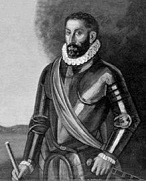
On Feb. 2, 1536 the city of Buenos Aires (Our Lady St. Mary of the Good Winds) in Argentina on the estuary of the Rio de la Plata (modern pop. 3M) is settled by Spanish conquistadors led by Pedro de Mendoza (1487-1537), who began colonizing the year before; Juan de Ayolas (-1537) and Domingo Martinez de Irala (1509-56) lead expeditions up the Parana and Paraguay Rivers in search of a route to Peru; after fighting the Guarani, crossing the Chaco to the Andes, and seizing some booty, Ayola is killed along with his whole co. by the Payagua; meanwhile de Irala escapes, and next year is elected capt. gen. of the Rio de la Plata by his men, going on to relocate the pop. of Buenos Aires to Asuncion in 1841 before the city is abandoned; in 1552 he is confirmed by Charles V as gov., building encomiendas and forcing the native pop. into them.

On May 18, 1539 Pizarro's lt. Hernando de Soto (1496-1542), having returned to Spain as a hero and married Isabel (Ines) del Bobadilla (1505-43) (daughter of a relative of Queen Isabella) in 1537, and obtained the governorship of Cuba and a royal patent to colonize the Am. Gulf coast and search for a passage to the Orient, sets sail from Spain on seven ships with 620 volunteers, 200+ horses and 500 livestock, reaching Port Charlotte (Tampa Bay?), Fla. on May 30, while his wife Isabel becomes the first woman gov. of Cuba, watching every day for his return; on Dec. 25 he celebrates the first Christmas in Tallahassee; too bad, he ends up stumbling around the Am. SE and killing tens of thousands of aborigines, incl. by burning their cities, but never sees the ocean again, getting killed on the Mississippi River in 1543.
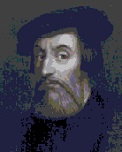
On July 8, 1539 after being sent by Hernan Cortes, Francisco de Ulloa (d. 1540) leaves Acalpulco in three small ships to seek the mythical Strait of Anian leading to the Gulf of St. Lawrence, reaching the Gulf of California, which he calls the Sea of Cortes; on Sept. 12 after one ship is lost in a storm, he resumes his voyage, saling S along the E coast of the Baja California Peninsula, landing at the Bay of La Paz to take on supplies, then rounding the tip and sailing N along the W shore in the Pacific Oean, reaching 28 deg. N near Isla de Cedros before bad weather forces him to turn back, until his ship is swept inland by a tsunami, causing it to become known as the Lost Ship of the Desert; too bad, his reports are used to depict Calif. as an island.
In 1539 New Spain viceroy Antonio de Mendoza sends Franciscan friar Sancho Panza, er, Fray Marcos de Niza (1495-1558) N from Mexico City to investigate reports by Cabeza de Vaca of the legendary Seven Cities of Cibola; he reaches the Zuni (Zuñi) pueblos of New Mexico and returns with glowing reports that impress Coronado - the women go around showing what?

Don't just take your family on a vacation, take them on an adventure? Whitey finally reaches the far side, and it's gone in a flash? On Feb. 23, 1540 Francisco Vazquez (Vázquez) de Coronado (1510-54), gov. of Nueva Galicia leads an expedition of 400 men plus 1.3K-2K Indios, four Franciscan monks, and several slaves from Compostela, Mexico, exploring N Texas and invading New Mexico and conquering the Zunis (Zuñis); on Sept. 8 they establish winter HQ at the Indian pueblos of Kuau and Puaray, using it as a base for vain searches for the riches of Quivira; in 1934 archaeologists unearth ancient paintings of Indian god-demons behind 85 layers of adobe plaster; on May 9 Spanish navigator Hernando de Alarcon (Alarcón) leaves Coronado's party, goes by sea to the Gulf of Calif., then completes the explorations of Francisco de Ulloa the preceding year, satisfying himself that there is no open water passage between the gulf and the South Sea (Pacific Ocean); he then travels up the Colorado River (which he names the Buena Guia), becoming the first Euro to navigate it, viewing Am. bison (buffalo) ("tatanka"); Garcia Lopez de Cardenas (García López de Cárdenas) leaves Coronado's party and discovers the Grand Canyon and the Colorado River in modern-day Ariz.; another lt. of Coronado reaches the pueblos of the Hopi (Moqui); Capt. Hernando de Alvarado leaves Coronado's party and explores the Rio Grande River, stopping halfway at Isleta Pueblo (S of modern-day Albuquerque), which becomes a stopping place for every future Spanish explorer in New Mexico.
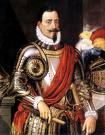
In Mar. 1540 Pedro de Valdivia (Valdavia) (1498-1554), who began working for Francisco Pizarro in 1535 and helped him fight Diego de Almagro (the N part of Peru had been under Almagro's jurisdiction) leads an expedition of 150 Spanish soldiers plus some Peruvian Indians across the Atacama Desert into the C valley of Chile, accompanied by his babe Ines Suarez.
In Feb. 1541 Pedro de Valdivia penetrates Chile's central valley and founds the city of Santiago (Del Nuevo Extremo) (modern pop. 1.2M/2.5M); hostile Indians siege the settlement until reinforcements from Peru arrive in Dec. 1543; once the city is established, he dumps his babe Ines Suarez?
In late Feb. 1541 Gonzalo Pizarro leads an expedition from Quito into Amazonia with 220 conquistadors, 4K highland natives, and 200 horses in search of the fabled rich El Dorado; the jungle can't support the natives and they all die of starvation, while the Spanish are reduced to eating their horses; they find a waterfall allegedly containing the gold of Atahualpa, but don't find any; on Nov. 9 they reach the Coca River, and by Christmas are on the verge of starvation; after a boat is built using melted-down horsehoes for nails, Francisco de Orellana (1511-46) leads 57 men, incl. Dominican missionary (chronicler and mapmaker) Father Gaspar de Carvajal (1500-84) on a food-gathering expedition, promising to return in a few days, but the current is too strong and they can't return, so they begin descending the network of rivers leading into the Amazon, getting into an epic lock-up-your-daughter adventure (ends 1542), which Carvajal records in his cool Journal of Gaspar de Carvajal.

On May 8, 1541 after failing to find the fabled Mayan city of Yupaha (discovered in 2011 near Brasstown Bald Mt. in Ga.?), and reaching Mobile Bay in Ala., then fighting fierce Choctaw chief Tuscaloosa ("black warrior") (-1540), Spanish conquistador Hernando de Soto (1496-1542) and his 400 men discover the Mississippi River (2nd longest river in the U.S. after the Missouri River), and cross it near Randolph, Tenn., then explore Ark., becoming the first Euros to see Hot Springs, then Okla. and Tex.
On May 21, 1541 Spanish explorer Hernando De Soto (b. 1496) dies of fever in the Indian village of Guachoya on the banks of the Mississippi River near modern-day McArthur, Ark.; his men, who had been trying to palm him off as a god try to disguise his death and sink him in the river in the night, but the natives see through it, and the expedition decides to return home, building ships and sailing in July down the Mississippi River, continuing to the Panuco River, where they find refuge in the Spanish frontier town of Panuco, then return to Mexico City a mo. later, with 311 of the original 620; the expedition was a dud, but it did leave horses and swine with the Indians, along with Euro diseases, causing permanent hostility.
In 1541 Francisco Vazquez de Coronado sets out from New Mexico on a 2K-mi. expedition across N Tex., the Okla. Panhandle, and E Kan. in search of the fabled rich Seven Cities of Cibola, esp. the city of Quivira (ends 1542); he carves his name and the date on a rock while searching for gold near the Cimarron River 20 mi. from modern-day Kenton, Okla. where the Santa Fe Trail later crosses the river, returning to Mexico City next spring with empty saddlebags after failing to find the fabled Seven Cities of Cibola; meanwhile Hernando de Soto explores the E border of Okla.
In 1541 Alvar Nunez Cabeza de Vaca leads an expedition through the Rio de la Plata (ends 1542), discovering Iguazu ("big water") Falls on the border of modern-day Brazil and Argentina, largest waterfall on Earth.

On Sept. 28, 1542 Portuguese navigator Juan Rodriguez Cabrillo (-1543), sent by New Spain viceroy Antonio de Mendoza in search of a northern strait discovers California (Calif.), landing at modern-day San Diego, and continuing N, discovering Monterey Bay on Nov. 16, and naming it Bahia de los Pinos because of the forest of pine trees; too bad, colonization is slow, and the first Spanish mission isn't founded until 1769 - why not call it Cabrillofornia? In 1544 Cabrillo dies of gangrene on Santa Catalina Island, and his pilot Bartolome (Bartolomé) Ferrelo (1499-1550) continues the expedition, exploring the Pacific coast as far as Oregon.
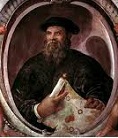
On Nov. 1, 1542 New Spain vicery Antonio de Mendoza sends an expedition of six galleons and 370-400 men led by Spanish explorer Ruy Lopez de Villalobos (1500-44) from New Spain to the "Islas del Poniente" (Islands of the West), taking Ferdinand Magellan's route, and after discovering Eniwetok (Enewetak) Atoll they enter Baganga Bay next Feb. 29, discovering Mindanao, which Lopez names Caesarea Karoll after Charles V, receiving a friendly reception, staying 32 days and suffering famine before leaving on Mar. 31, being intercepted by Portuguese ships wanting to know why there are trespassing on Portuguese territory; after hostile reception by the natives and more Portuguese, Villalobos is imprisoned by the Portuguese on Amboyna Island, where he dies next Apr. 4 after giving the name "Islas Felipinas" (Philippines) (after Charles V's son Philip II) to the Leyte region, which is later extended to the whole archipelago; 85 remaining crew members are shipped back to Lisbon on a Portuguese ship, and the rush to make the Philippines Philip's begins.
In 1544 Diego Garcia, a strategic atoll 1K mi. S of India halfway between Sri Lanka and Mauritius is discovered by Portuguese explorer Diego Garcia de Moguer (1484-1544). Bartolome de las Casas becomes Roman Catholic bishop of Chiapas in S Mexico (until 1547), later returning to Spain, where he writes about his experiences and preaches the Indians' case.

The original polymath with feet in two worlds? In 1546 Leo Africanus (Al-Hasan al-Wazzan) (Yuhanna al-Asa), AKA John/Johannes/Giovanni and/or Leo/Leone the Lion (1488-1554) pub. History and Description (Cosmography and Geography) of Africa; Granada-born Fez-raised traveler-diplomat meets Sultan Selim, is seized by Christian pirates in the Mediterranean, held as a prisoner in Rome with access to the papal library, meets with Pope Leo X, is baptized a Christian to get freed, and is given the surname "de Medici" by the pope, becoming a big dude in Rome, writing five books and meeting with Francois Rabelais before returning to Tunis and reverting to Islam; he describes Timbuktu as a city of gold where the emperor eats off half-ton golden platters, causing Euro explorers to becom
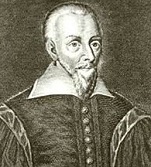
In 1553 Sebastian Cabot (1476-1557), son of John Cabot (d. 1498) convinces merchants to back him in an expedition sailing NE from England, above Scandinavia, in a fruitless search for a northeast passage; Sir Hugh Willoughby (-1554) of the Bona Esperanza, Cabot of the Bona Confidentia, and Richard Chancellor (-1556) of the Edward Bonaventure, backed by the Mystery Co. and Fellowship of Merchant Adventurers for the Discovery of Unknown Lands of London sail to the Arctic; after being separated by "terrible whirlwinds", on Sept. 14 Willoughby sails into a bay between Russia and Finland, and discovers Novaya Zemlya, while Cabot returns to England, and Chancellor anchors in the White Sea and trudges overland to Moscow to the court of Ivan IV the Terrible, where he is warmly welcomed, wined, and dined, opening English trade with Russia; Willoughby dies during the winter on the Kola Peninsula on the Lapland coast early next year, and the frozen bodies of him and his crew, along with his journals are found by fisherman a year later.

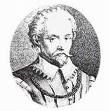
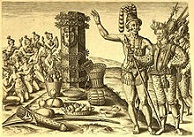
In Feb. 1562 French Huguenot Adm. Gaspard de Coligny does the Star Trek thang and sends a colonizing expedition to Fla. under the command of Jean Ribault (Ribaut) (1520-65), which arrives in Apr. then sails to Port Royal Sound, S.C., where it tries unsuccessfully to colonize Parris Island near Ft. Royal (near Beaufort), building Charlesfort; in June 1996 U. of S.C. profs. Chester DePratter and Stanley A. South announce discovery of the site; in June a 2nd expedition to Fla. under Rene Goulaine de Laudonniere (Laudonnière) (1529-87) arrives next year at the St. Johns River in Fla., then sails N to S.C., founding Ft. Caroline near modern-day Jacksonville, Fla., threatening the Spanish treasure fleets; the news causes Philip II to order their expulsion, appointing Spain's #1 adm. Don Pedro Menendez de Aviles as gov. of Fla. with the mission of driving out any settlers or pirates and then exploring and colonizing it once and for all; after all, Ponce de Leon claimed it for Spain way back in 1513; meanwhile French Calvinist artist Jacques le Moyne de Morgues (1533-88) accompanies them, making engravings of the local Timucua and Saturiwa tribes.

Early in 1568 Spanish navigtator Alvaro de Mendana (Álvaro de Mendaña) de Neyra (Neira) (1542-95) sights Tuvalu and Ontong Java, then later discovers the Solomon Archipelago.
On Nov. 22, 1574 Spanish navigator Juan Fernandez (Fernández) (1536-1602), after making repeated voyages between Panama and Peru or Chile and discovering the trade winds, shortening his sailing time so much that he ends up being tried and acquitted of witchcraft, and discovering a faster maritime route between Callao and Valparaiso that avoids the Humboldt Curent, discovers the Juan Fernandez Islands, which become a haven for pirates, incl. Alexander Selkirk; in 1966 Chile renames the islands of Mas Afuera as Alejadro Selkirk Island, and Mas a Tierra as Robinson Crusoe Island; meanwhile in 1575 Fernandez allegedly discovers the continent of Australia and/or New Zealand. Pierre qui roule n'amasse pas mousse?
In 1575 (1576?) after joining Francis Drake's expedition to Panama in May 1572, returning to England with him, and sailing back to Panama with a 120-ton ship with a crew of 70, John Oxenham (Oxnam) (-1580) becomes the first non-Spanish Euro explorer to cross the Isthmus of Panama after starting from the coastal town of Careta and receiving aid from the Cimarrones to climb the Cordillera de San Blas to the mouth of the Chucunaque River on the Pacific Ocean; too bad, after building a shallow 45-ft. oared boat from milled cedar trees (first ship built in the New World by Englishmen), and using it to pirate Spanish ships, he is captured in mid-1578, and executed in Lima on Sept. 30, 1580.

In Nov. 1577 not-yet-sir Francis Drake (1543-96), after being presented to the queen and sponsored by Hatton sets out from England with five ships to circumnavigate (not circumcize?) the world via Cape Horn while sacking Spanish towns and harrying Spanish ships that had been attacking English ships ("So it is that I would be revenged on the king of Spain for divers injuries that I have received" - Elizabeth I); his own ship is the Pelican, which he renames the Golden Hind (Hinde) as he enters the Strait of Magellan in honor of Hatton, whose coat of arms is a golden female deer; he completes his epedition in 1580, and is knighted in 1581. In Sept. 1578 English explorer and freebooter sure-to-be-Sir Francis Drake (1543-96) discovers the 400-mi.-wide Drake Passage between Cape Horn and the South Shetland Islands, rounding the Horn in 17 easy days, easily sailing past the lethal Four Evangelists and Desolation Island at the W end; in 1579 he is chased by the Spaniards up the coast of Calif., hoping to escape by the fabled Northwest Passage, and lands at Laguna Beach (Drake's Bay) near modern-day San Francisco, where the local aborigines mistake the fair English for gods and offer them their entire country, which he accepts, leaving a metal plate announcing the new English country of New Albion (N Calif.) "by the grace of God and in the name of her majesty Queen Elizabeth of England". Luck be a lady tonight, stick with me baby I'm a fellow you can win with, in 1936 San Fran store clerk Beryle Shinn discovers the plate while hunting pheasant, and it ends up on display at the U. of Calif. Of course, the Spanish pooh-pooh Drake's claims, and claim all of California for themselves, although maybe Portugal should be given San Diego for equity, ask the pope, oh yes, he already decided that question, and Cabrillo was working for the Spanish anyway. On Sept. 26, 1580 after crossing the Pacific to the East Indies, Drake arrives in Plymouth, England, becoming the 2nd man to lead a round-the-world voyage (36K mi.) (began 1577); the queen gives him a green silk scarf, but rumors of his pirate habits eventually take the shine off, and the queen keeps 20% of his £800K treasure haul.
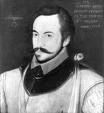
On June 11, 1583 Sir Humphrey Gilbert (1539-83) (half-brother of Sir Walter Raleigh), looking for a passage to Cathay sails from Plymouth, England to Newfoundland in the 40-ton flagship Golden Hind (Hinde) (originally the Pelican until 1577), arriving on Aug. 3 and becoming the founder of the first English colony in North Am. at St. John; after the colonists mutiny, he dies on the return voyage on Sept. 9 after deciding to sail in the 10-ton Squirrel, and it goes down with the entire crew in a storm off the Azores.

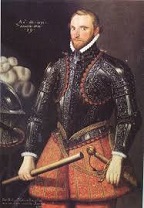
On Mar. 25, 1584 Sir Walter Raleigh (1552-1618) is knighted and granted a patent by Elizabeth I to explore and colonize North Am., threatening revocation if he doesn't establish a colony, causing him to explore the E coast, founding the first English settlement on Roanoke Island off the coast of N.C. next year by sending a 7-ship fleet under adm. his cousin Sir Richard Grenville (1542-91) and gen. Sir Ralph Lane (1532-1603), where Bohemian mining expert Joachim Gans (Ganse) researches the copper smelting techniques of the native tribes, which take only four days vs. 16 weeks for Euros; Jews are still not allowed in England under thhe 1290 expulsion order of Edward I; Raleigh sends Philip Amadas and Arthur Barlowe to explore the coast of modern-day N.C., and they return with news of king Wingina, ruler of the kingdom of Wingandacoa, causing England to annex the vast undefined area of Virginia (N.C. to Fla.), named for Virgin Queen Elizabeth I, which is good, since on his next voyage Raleigh finds out that wingandacoa actually means "What good clothes you're wearing" in Algonquian - he ought to know better?


In 1585 English explorer John Davis (1543-1605) searches for a Northwest Passage in two ships named Sunshine and Moonshine, discovering the Davis Strait between Baffin Island (Canada) and Greenland; he gives up in 1587. On July 21, 1586 Thomas Cavendish (1560-92) leaves Plymouth, England on a voyage of circumnavigation with three ships and 123 men, becoming the first to emulate Sir Francis Drake, raiding Spanish towns and ships in the Pacific and circumnavigating the Earth, reaching the Strait of Magellan next Jan. 6, reaching Guam on Jan. 3, 1588, the coast of Africa on May 14, 1588, and returning to Plymouth on Sept. 9, 1588 (2 years 49 days) (9 mo. faster than Drake) with only one ship and 48 crew, parading up the Thames River through London displaying new blue damask sails before being knighted by Elizabeth I, the captured treasure making him rich. In Aug. 1591 Sir Thomas Cavendish (b. 1560) begins his 2nd expedition, accompanied by navigator John Davis, crossing the Strait of Magellan and returning to Brazil, where a battle with the Portuguese at Vitoria kills most of the crew, after which he sets off towards Saint Helena but dies off Ascension Island after writing a letter accusing Davis of being a "villain" who caused "the decay of the whole action"; the crew goes on to discover the Falkland Islands next Aug. before returning sans most of the crew.
In spring 1586 Sir Francis Drake introduces tobacco pipe smoking to Sir Walter Raleigh before capturing Cartagena in Colombia (capital of the Spanish Main) and sacking St. Augustine on the E coast of Fla.; on June 26 Drake visits Roanoke Island and learns of its woes of recurring Indian attacks and supply shortages; in July after dropping off 15 of his own men (who are never heard from again), he returns the disheartened colonists to England, who cause a sensation by smoking (drinking?) sotweed (tobacco) from pipes; Sir Walter Raleigh becomes the first ranking Englishman to smoke, helping to make the nasty habit fashionable (along with boy buggering)? - red eyes plus a grunt, it'll all make sense?



The original Don't Be a Paleface? The foolhearty Anglo whites take a dare in Injunland a little too early? In July 1587 after John White (1540-93) (half-brother of Sir Walter Raleigh) visits the North Carolina area and returns with shocking but cool, twisted-to-Euro-prejudices paintings of the half-naked but partly civilized and hence useful Indians (hence kinda a little bit white?), he leads a party of 116 English settlers (90 men, 17 women, 9 children) and lands on Roanoke Island off the N.C. coast; on Aug. 18 Virginia Dare (1587-) is born to Gov. John White's daughter Ellinor and Ananias Dare, becoming the first white European child born in the Am. colonies (don't think Heidi Klum and Seal?); wasting no time to make the place liveable, the colonists brew their own ale from corn; on Aug. 27 Gov. White leaves for England with a skeleton crew of 15 to seek help and supplies, leaving instructions that if the colonists are forced to leave in his absence they should inscribe their destination in a "conspicuous place"; too bad, the war between England and Spain keeps him from returning until 1590; the paintings start out circulating in the hands of the elite only, but eventually get made into prints which circulate in Europe for two cents., forming their main impression of Am. Indians; meanwhile white men's diseases (smallpox, typhus, measles) begin their genocidal effect on the defenseless pop.
On Aug. 18, 1590 a relief expedition reaches Roanoke Island and finds it deserted, with the word "Croatoan" carved on a post, indicating that they had gone to Croatoan Island to the S to live with the friendly Hatteras tribe, which in 1650 migrates to the Lumber River Valley 200 mi. away, becoming the Lumbee Indians of Robeson County, N.C.; at the time, though, nobody can figure out what happened to them, and suspect the worse; the island becomes submerged by modern times - see that great episode of the Fess Parker TV series "Daniel Boone"?
In 1592 Juan de Fuca (-1601) (a Greek sailing under the Spanish flag) discovers the Juan de Fuca Strait on the W coast of North Am. separating Vancouver Island from the Olympic Peninsula, along with British Columbia.

In June 1594 Dutch explorers Willem Barents (Barentsz) (1547-97) and Cornelis Corneliszoon Nay leave Texel, Netherlands on the first of three voyages in the Barents Sea in N Russia to find the Northeast Passage (ends 1597); Nay reaches the Kara Sea this year, the second voyage next year is stopped by ice, and the third in 1596-7, by Barents alone results in his party wintering on Novaya Zemlya, after which Barents dies on the return voyage; although they fail to find the passage, they open up whale and seal fishing; in the 19th cent. Barents Sea (AKA the Murman Sea, Norwegian Sea) is named after Barents.
In Apr. 1595 Spanish explorer Alvaro Mendana de Neyra (b. 1542) sails from Callao on his second voyage to Micronesia; in May he discovers the Marquesas Islands (Las Marquesas de Mendoza); on Oct. 18 he dies in the Santa Cruz island group in the Solomons.
On July 5, 1595 Portuguese explorer Sebastiao Rodrigues Soromeno (Sebastián Rodríguez Cermeño) (1560-1602) sails from Manila in the San Agustin, reaching land between Point St. George and Trinidad Head in Calif. on Nov. 4, then S to Drakes Bay on Nov. 7, where Native Ams. greet him, but aren't as wowed as when they saw Sir Francis Drake in 1579; after a storm blows them N, their ship sinks, and they switch to a launch named the San Buenaventure, then leave on Dec. 8, heading S as fast as they can, failing to notice San Francisco Gay, er, Bay, discovering Monterey Bay on Dec. 10 and naming it Bahia de San Pedro in honor of St. Peter Martyr, and arriving at Puerta de Chacata, Mexico on Jan. 17.
In 1595 after hearing of a "city of gold" in South Am. last year, Sir Walter Raleigh explores 300 mi. up the Orinoco River, and discovers Guiana, but fails to find the fabled gold mine of El Dorado, or any gold mines, but goes on to pub. a book with an exaggerated account contributing to the legend.





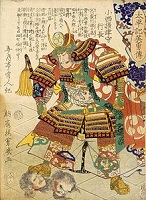


On Oct. 21, 1600 Tokugawa Ieyasu (1543-1616) wins a big V against his rival Ishida Mitsunari (1559-1600) (backing Toyotomi Hideyoshi's son Hideyori) at the Battle of Sekigahara after Kobayakawa Hideaki (1577-1602) flip-flops during the battle; Mitsunari is captured by villagers and executed on Nov. 6 in Kyoto, and his head placed on a stand, after which it mysteriously disappears a few days later; Christian daimyo Konishi Yukinaga (b. 1555) flees to Mt. Ibuki, and after capture has to be executed on Nov. 6 because as a Christian he refuses to commit hari-kari; Ieyasu moves the capital from Kyoto to Edo (Yedo) (Tokyo), and names himself shogun of the emperor, founding the Tokugawa Shogunate (Bakufu) in 1603 (ends 1868), the last Japanese shogunate, where Japan closes in on itself and becomes the ultimate martial medieval fantasyland; English navigator William Adams (AKA Miura Anjin) (1564-1620) (same age as William Shakespeare?) (whose portrait bears a striking resemblance to Hollywood actor Richard Chamberlain (1934-)?) wrecks his ship Liefde (originally called Erasmus) off the coast of Japan, becoming the first Englishman to visit Japan, and a pampered pet of shogun Tokugawa Ieyasu for the rest of his life; in return he betrays English trade secrets on shipbuilding - incl. the formula for the integrated cow chip?

On May 5, 1602 Spanish explorer Sebastian Vizcaino (Sebastián Vizcaíno) (1548-1624) departs from Acapulco with three ships, the San Diego, San Tomas, and Tres Reyes, reaching and naming San Diego Bay on Nov. 10, and continuing N, reaching and naming the Santa Barbara Channel Islands, Point Conception, the Santa Lucia Mountains, Point Lobos, the Carmel River, and Monterey Bay (Dec. 16) (named after New Spain viceroy Conde de Monterrey, overriding the name Bahia de los Pinos given it in 1542 by Juan Rodriguez Cabrillo, and the name Bahia de San Pedro given it in 1595 by Sebastian Rodriguez Cermeno), becoming the first to record the Monterey cypress forest at point Lobos; his cmdr. Martin de Aguilar becomes separated and continues N to Ore. as far as Cape Blanco (Coos Bay?); when they return they whip-up enthusiasm for settlement of Monterey, but a colonizing expedition is cancelled in 1608.
On May 15, 1602 English explorer Bartholomew Gosnold (1571-1607) explores and names Cape Cod, and visits the Elizabeth Islands at the SW corner, incl. Martha's Vineyard, and visits and builds a small fort on Cuttyhunk Island, all of which pretty much makes him the discoverer of New England's coast?; he is visited by a delegation of 50 Indians in 9 canoes (incl. the father of Massasoit?), who sit on their heels "like greyhounds", enjoy all English foods offered except mustard, mimic English speech accurately, and give Gosnold a tobacco pipe to smoke; he harvests sassafras roots for use in treating syphilis and rheumatism, and abandons his fort after four Indians attack his men while foraging; he later becomes a capt. in Jamestown - they filmed "Jaws" where?

On Mar. 15, 1603 French explorer Samuel de Champlain (1567-1635) arrives in North Am. on his first trip as an observer with a fur-trading expedition led by Francois Grave (Gravé) Du Pont (1560-1629), exploring the St. Lawrence River as a possible route to China and creating a map of it, then returning to France on Sept. 20 and writing a report for King Henri IV (his father?).
 In spring 1603 English explorer (from Bristol) Martin Pring (1580-1646)
sets out with backing from Bristol and Sir Walter Raleigh to explore the N parts of Va. in his 60-ton flagship Speedwell (not the same ship used by the Pilgrims in 1620)
and 13-ton escort ship Explorer, making first landfall in June at Penobscot Bay in Maine, then heading W to the Saco, Kennebunk, and York Rivers, then up the Piscataqua River,
where they encounter the Abenaki and set dogs on them to capture specimens to bring back to Europe; after failing to find the fabled ague (sassafras) tree (source of the elixir of life),
they reach Cape Cod at the mouth of the Pamet River, and build a fort below Cornill near modern-day Truro on the N part of the fishook, finding and harvesting sassafras but finding no Indians,
only a birch bark canoe (which they bring back to Europe), after which they leave in late July.
In spring 1603 English explorer (from Bristol) Martin Pring (1580-1646)
sets out with backing from Bristol and Sir Walter Raleigh to explore the N parts of Va. in his 60-ton flagship Speedwell (not the same ship used by the Pilgrims in 1620)
and 13-ton escort ship Explorer, making first landfall in June at Penobscot Bay in Maine, then heading W to the Saco, Kennebunk, and York Rivers, then up the Piscataqua River,
where they encounter the Abenaki and set dogs on them to capture specimens to bring back to Europe; after failing to find the fabled ague (sassafras) tree (source of the elixir of life),
they reach Cape Cod at the mouth of the Pamet River, and build a fort below Cornill near modern-day Truro on the N part of the fishook, finding and harvesting sassafras but finding no Indians,
only a birch bark canoe (which they bring back to Europe), after which they leave in late July.




Early in 1607 after leaving England last Dec. 20 in three ships, Godspeed, Susan Constant, captained by 1-armed Christopher Newport (1561-1618), and Discovery, captained by Bartholomew Gosnold (1571-1607) with 144 passengers and crew, then being pinned to the coast of England by howling winds for 6 weeks, the Virginia Co. expedition crosses the Atlantic by a southernly route and reprovisions in the West Indies, then heads N for Virginia, expecting to arrive in Apr.; too bad, they hit a tempest and sound for four days, looking for offshore shallows, and on Apr. 26 at 4 a.m. they sight land, enter Chesapeake Bay, then sail 40 mi. up the James River to hide from Spaniards; on May 14 they finally land after 144 days at sea at a marshy spot of land on the N shore of the James River (Jamestown Island in the river?) (140 mi. N of Roanoke), in an area surrounded by howling Indian settlements, naming it Jamestown in honor of James I, becoming the first permanent English settlement on the North Am. mainland; too bad, they arrive in the driest 7-year period in almost 8 cents. (1606-12); Capt. John Smith (1580-1631), who had accused the leaders ("our ignorant transporters") of incompetence, calling them "ten times more fit to spoil a commonwealth than... to begin one", was clapped in irons on the voyage and sentenced to hang but pardoned to be used in possible future fighting by Capt. Newport after a gallows is built on Nevis Island in the Caribbean, becoming the first English Am. inmate; most of the 107 male cavalier colonists are devout, have Puritan leanings and are strongly anti-Catholic, and allegedly first stop at Cape Henry at the mouth of the James River and plant a cross on the shore, claiming it for Christ; to keep investors from bugging out, the names of seven governing council members are carried in a sealed box, and opened upon landing, and capt. Edward Maria Wingfield (1550-1631) becomes the first pres. of the council; after living behind a crescent brush fence for two weeks they are attacked by 200 Indians, who are repelled with the help of the ship's cannon after two English die and 11 are wounded, causing them to decide to build a log palisade, and in June heat under frequent arrow attack they cut and split 600+ trees in 19 days and lay them in a 300-yard 2.5-ft.-deep triangular trench, after which "scarce 10 among us could either go or well stand, such extreme weakness and sickness oppressed us" (Smith); being "gentlemen adventurers" they don't know how to farm, hunt in the woods or even fish, forcing them to depend for food supplies on trade for copper scraps with the 30-tribe 14K-21K pop. Powhatan (Powatan) (Powhaten) (1545-1618) (pr. pow-uh-TAN) confederation of Algonquian Indians in the Tidewater area of E Va. between the James and York Rivers, led by 60-y.-o. Pawmunkey chief Powhatan, real name Wahunsonacock (sounds like?) (father of 11-y.-o. Pocahontas), whom Capt. Smith says "sat covered with a great robe made of raccoon skins, and all the tails hanging by" flanked by "two rows of men, and behind them as many women, with all their heads and shoulders painted red", and wearing long strings of pearls, presenting "such a grave and Majesticall countenance, as drave me into admiration to see such state in a naked Salvage", and to whom Smith later lies that they are merely visitors driven there to hide from the Spanish (ask Dr. D. James Kennedy how they only came to spread the gospel to the heathens?); too bad, the Powhatans want English swords and firearms, not just copper and them cool glass beads, and to make allies of them to fight other Indians, not to become tributaries to James I, and since the colony is owned by Walmart, er, the London Co., er, the Virginia Co., they have to show a profit for the stockholders back in the Big E, so in June Capt. Newport leaves for England with two ships carrying samples of clapboard and sassafras, leaving 104 settlers, all male (incl. some boys, cute cute cute?), who also attempt to hunt for precious minerals and plant cotton; too bad, a major drought lasting for seven years makes freshwater scarce, and being too lazy to dig a well, they have to drink from the Shi, er, James River (filled with you know what from the many Indian settlements upriver), giving them salt poisoning and dysentery to go with their typhoid?; Smith goes around trading with the Indians and forcing them to give up their corn for his trinkets with terrorist tactics if necessary, until, in a magic moment for English-Indian relations, the arrogant prick is captured on one of his expeditions to explore and map the region, and held for 3-6 weeks in Dec. at the Injun capital of Werowocomoco ("place of chiefs") on the York River, where he attempts to outwit, outlast, and outthink them by claiming his compass is magic and that they can plant gunpowder next spring to grow their own; too bad, after springing his lie about being just visitors, Chief Powhatan (Wahunsonacock) orders the white devil's head pressed on a stone altar to beat out his brains with clubs, but in a second magic moment, his #1 most beautiful daughter out of 100+ wives, 13-y.-o. Pocahontas (1595-1617) ("frisky") ("undisciplined brat"?) (real name Matoaka or Amonute) (poke it up my hot what?), whom Smith says "much exceeded any of the rest of his people not only for feature, countenance and proportion... but for wit and spirit, the only Nonpareil of his country", intervenes and pleads for his life, causing the chief to adopt him and give him the honorary name of Nantaquoud, and offer him some nearby land; Smith doesn't recognize that the ceremony is only a ritual to impress him with the chief's authority after the big feast of oysters, turkey, and cornbread he just threw, and later writes that he and Poca had "a very mad affair"; instead of staying, he decides to stay single and free, and returns to Jamestown, finding it on the verge of starvation, and in early Jan. she arrives with enough food to save their lives; later she saves his life again by sneaking through the forest alone at night to warm him of an ambush; they never actually hooked up or were an item, despite later romantic writers slobbering over forbidden interracial romance?

On May 1, 1607 English explorer Henry Hudson (1566-1611) makes his First Voyage in his 80-ton ship Hopewell to find a Northwest Passage, and makes it as far N as Willem Barents' Spitsbergen. In 1608 Henry Hudson makes his Second Voyage, looking for a Northeast Passage through 5.4M sq. mi. of ice - good luck, sucker? In summer 1609 English explorer Henry Hudson (1566-1611) begins his Third Voyage to search for a Northwest Passage in the Dutch ship Half Moon (Halve Mein); on Aug. 28 after a budding mutiny of his crew causes him to reverse course and head toward the New World, he discovers Delaware Bay and the Delaware River; on Sept. 11 he discovers New York Bay, sailing into the Hudson River on Sept. 12 and founding New Amsterdam (renamed New York in 1664) on the Hudson River, while setting eyes upon the wooded island of Manhattan, from the Lenape word Mannahatta, meaning island of many hills; on Sept. 14 he enters the Tappan Zee (Sea) 10 mi. N of Manhattan, thinking that the widening of the Hudson River indicates a Northwest Passage, then giving up after reaching modern-day Troy; meanwhile he makes the first Euro encounter with the Mohicans (Mahicans); upon returning to Europe he is arrested for sailing under another nation's flag - does that make him an illegal alien? In 1610 Henry Hudson (b. 1566) makes his Fourth Voyage in search of a Northwest Passage, sailing through the Hudson Strait and discovering Hudson (Hudson's) Bay and the Hudson River; too bad, the crew mutinies and returns to England after setting Henry, his son and several others adrift in Hudson Bay on June 22, and they are never seen again.
On June 14, 1615 Dutch mariner Jacob Le Maire (1585-1616) and Willem Schouten embark on a round-the-world voyage from Texel, Netherlands; on Jan. 29, 1616 they become the first to round Cape Horn, named after their ship Hoorn (named after the town in N Holland), which was lost in a fire, and discover the Le Maire Strait; too bad, they are arrested in Java by the jealous Dutch East India Co. for violating its trade monopoly, and their remaining ship Eendracht is confiscated, and Le Maire dies on the remaining ship Amsterdam on return journey to Amsterdam, which ends on July 1, 1617 after 2 years 17 days - fills the need for speed, or there's only one way to rock?

On Mar. 26, 1616 after being hired by the Muscovy Co. to find the Northwest Passage, English explorers William Baffin (1584-1622) (pilot) and Robert Bylot leave Gravesend, Kent, England, pass up the Davis Strait W of Greenland, and discover ice-clogged Baffin Bay(between Nunavut, Canada and Greenland, also discovering Ellsmere Island (home of the Arctic Cordillera Mts. and the Arctic willow), Smith Sound, which later becomes a route to the North Pole, and Lancaster Sound NW of Baffin Bay (named after British East India Co. dir. Sir James Lancaster), through which the Northwest Pasage is discovered three cents. later, also sighting Devon Island in Baffin Bay, which becomes the largest uninhabited island on Earth, and reaching 77 deg. 45 min N latitude, which becomes the record until 1852 (236 years); too bad, they aren't believed until Sir John Ross rediscovers Baffin Bay in 1818, and Bylot is not given credit because he participated in the mutiny on Henry Hudson's ship in Hudson Bay in spring 1611.

In 1634 French explorer Jean Nicolet (1598-1642) crosses Lake Michigan and lands at Green Bay (originally La Baie des Puants, "Bay of Stinking Waters") (modern-day pop. 104K/312K), home of the Menominee and Winnebago (Ho-Chunk) people to explore the region; expecting Chinese, he dresses in bright-colored flowery Chinese robes; the city grows up at the mouth of the Fox River 112 mi. N of Milwaukee, Wisc.

On Aug. 14, 1642 Dutch explorer Abel Janszoon Tasman (1603-59) leaves Batavia, reaching Mauritius on Sept. 5 to gather supplies for his crew, leaving on Oct. 8 and sailing E through the Roaring Forties westerly winds, sighting Van Dieman's Land on Nov. 24 and naming it for Dutch East Indies gov. Antonio van Diemen; on Dec. 13 he sights New Zealand, naming it Staten Landt; on Dec. 19 four of his men are killed by the natives at Massacre (Murderers) (Golden) Bay.
In 1650 Spanish explorer Don Diego del Castillo explores the Wichita Mts. in Comanche County, Okla. for 6 mo. looking for gold and silver before dying next June on the banks of the Mississippi River - you-u-u-u made me leave my happy home?


In July 1673 Ft. Frontenac is founded on the mouth of the Cataraqui River on the St. Lawrence River near modern-day Kingston, Ontario, Canada by Rene-Robert Cavalier, Sieur de La Salle (1643-87), who gave away his father's fortune to join the Jesuits and sailed for New France in spring 1666, hoping to find a western passage to China. In early 1679 he builds Fort Conti at the mouth of the Niagara River on Lake Ontario; on Aug. 7 he launches the 7-cannon 45-ton Le Griffon, which becomes the first full-sized ship to sail across the Great Lakes in a quest for the Northwest Passage, reaching an island in Lake Michigan, where La Salle disembarks with 26 of 32 men, sending the rest back to Niagara with a load of furs, after which it disappears in Green Bay, Wisc.; in Sept. 1679 he sails on a barque with Father Louis Hennepin (1626-1705) to Lake Erie, Lake Huron, and Michillmackinac, discovering Niagara Falls, then sails through the Detroit River to Green Bay, ditching the barque and switching to canoes, paddling down the W shore of Lake Michigan to the mouth of the Miami (St. Joseph) River, building Fort Miami on the shores of Lake Superior near modern-day Duluth, Minn. in Jan. 1680, and leaving on Dec. 3, reaching modern-day South Bend, Ind., then crossing the Kankakee River to the Illinois River, building Fort Crevecoeur near modern-day Peoria, Ill., surviving a mutiny and canoeing down the Mississippi River in 1682, naming Louisiana after Louis XIV and claiming the entire territory for him, then building Fort Saint Louis at Starved Rock on the Illinois River to replace Fort Crevecoeur before leaving for France, returning on July 24, 1684 with a large expedition incl. four ships and 300 colonists, founding Fort Saint Louis on Garcitas Creek in modern-day Victoria, Tex., claiming Texas for France; too bad, while searching for the mouth of the Mississippi River, La Salle is ambushed and killed on Mar. 19, 1687 by Pierre Duhaunt in modern-day Navasota, Tex, after which his fort on the Illinois River is later taken over by John Jacob Astor's fur trading co.

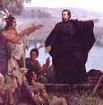
In 1673 French cartographer Louis Joliet (1645-1700) and French Jesuit missionary Jacques Marquette (1637-75) explore the mighty Mississipi River in birch bark canoes, if not down to the Gulf of Mexico, at least to the mouth of the Arkansas River.

In 1679 English buccaneer-explorer William Dampier (1651-1715) begins his first buckin' voyage around the world (ends 1691), featuring two visits to the Bay of Campeche on the Gulf of Mexico, a raid across the Isthmus of Darien in Panama, and more raiding of Spanish settlements in Peru in 1683, switching ships and sailing across the Pacific Ocean to the East Indies incl. Guam, Mindanao, Manila, Poulo Condor, China, the Spice Islands, and New Holland, reaching King Sound in NW Australia on Jan. 5, 1688. In 1697 Dampier pub. A New Voyage Round the World, which causes a sensation, causing him to be given command of the 26-gun HMS Roebuck in 1699 with a commission from William III to explore Australia and New Guinea. On Jan. 14, 1699 famous circumnavigator William Dampier leaves England in HMS Roebuck, and on July 26 reaches Dirk Hartog Island at the mouth of Shark Bay in W Australia, then explores the NW coast of Australia, and passes Timor on the way to New Guinea, which he sights on Dec. 3, passing New Hanover, New Ireland, and New Britain (modern-day Bismarck) Islands and charting the Dampier Strait, finally returning to England in Aug. 1701 after ending up marooned near Ascension Island for five weeks; too bad, he ends up getting court-martialed for cruelty and kicked out of the Royal Navy, so he goes back to being a pirate - will it be any dampier for him now? On Sept. 11, 1703 after the War of the Spanish Succession makes the English govt. about-face on his case, William Dampier, new cmdr. of the 26-gun 120-man English navy ship St. George sails from Kinsale, Ireland to fight the Spanish and French along with 96-ton 16-gun 63-man galleon Cinque Ports; they go on to capture three Spanish ships returning from Buenos Aires, and fight to a push with a French ship; he returns to England in Dec. 1707 (his 2nd circumnavigation of the Earth) after giving Daniel Defoe a subject for a new novel?
In 1691 Hudson's Bay Co. explorer Kelsey sees Am. bison (buffalo).
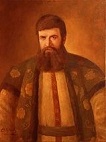
In 1697 Siberian Cossack explorer Vladimir Vasilyevich Atlasov (Otlasov) (1661-1711) explores the Kamchatka Peninsula in the Sea of Okhost for Russia, discovering 7,674-ft. perfect cone-shaped Atlasov Island and 15,580-ft. near-perfect cone-shaped Klyuchevskaya Volcano (Sopka) (one of 30), the largest active volcano in Eurasia, having over 600 eruptions by the year 2000, and whose base is known as the Valley of Death because of the poisonous gases.

Detroit really is the original home of Cadillac? On July 26, 1701 French king Louis XIV gives permission for the settlement of Detroit (Fr. "le Detroit" = the Straits), originally Fort Pontchartrain du Detroit (Détroit) to ever-broke Gascony, France-born explorer and scoundrel Antoine Laumet de La Mothe, Sieur de Cadillac (1658-1730) on a peninsula joining Lake Huron and Lake Erie to control Illinois trade; the settlement is begun in July; Cadillac arrived from France at Point Royal in 1683, added "de La Mothe Cadillac" to his name after Cadillac in SW France,, and spent four years exploring the New World down to the Carolinas, getting a promotion to cmdr. of Fort de Buade (Michilimackinac) (near modern-day St. Ignace, Mich.) in 1694, exploring the Great Lakes in 1695 until he got into trouble for selling alcohol to the Indians and returned to Montreal in 1696, traveling back to France in 1697 to talk them into building Fort Pontchartrait on the straits; too bad, it burns down in 1703, and he returns to Quebec, getting charged with trafficking in alcohol and furns, taking until 1708 to clear his name, after which in 1710 he is appointed gov. of Louisiana, founding Mine La Motte in modern-day Madison County, Mo., the first lead mine in Missouri, worked by the first African slaves in Mo.; in 1716 he is fired, and returns to France in 1717, gaining an undeserved rep as a hero until the 1950s.
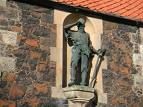
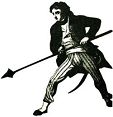
The original Capt. Kirk? In Oct. 1704 Scottish sailing master Alexander Selkirk (1676-1721) of the Cinque Ports (part of the William Dampier expedition), which tried to round Cape Horn only to fall prey to a scurvy outbreak which killed 48, incl. Capt. Pickering, who was replaced by 21-y.-o. Lt. Thomas Stradling, then sailed to Mexico, capturing several Spanish ships along the way, then stopped at the Juan Fernandez archipelago off the coast of Chile to resupply, is put ashore at his own request on Mas a Tierra (renamed to Robinson Crusoe by Chile in 1966) after an argument with Stradling about the s Capt. Woodes Rogers (1679-1732) of the English privateer Duke, run by sailing master William Dampier (1651-1715) (engaged in 1708), whose expedition makes a £200K profit from all the booty, although Dampier dies in 1715 before receiving his share; the old barge Cinque Ports does indeed sink off the coast of Colombia and lose most of its crew, so there?

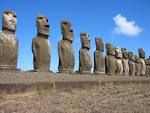
On Apr. 5, 1722 (Easter Sun.) after entering the Pacific in Mar. and sailing E to W in a search for Terra Australia, Easter Island (Rapa Nui) (Isla de Pascua) in the mid-South Pacific is discovered by Dutch explorer Adm. Jacob (Jakob) Roggeveen (1659-1729); due to overpop., deforestation, and the introduction of the Polynesian rat, the pop. is down to 2K-3K from 15K a cent. earlier; it is filled with 300 30-ft.-high stone busts (moai) (carved from volcanic rock from dormant Rano Raraku) with red headpieces, mounted on huge platforms; Roggeveen and his three ships sail away, and when Euros return almost 50 years later, the busts had been toppled from the platforms to the ground after tribal wars; 400 more uncompleted busts are found inside the crater, covered with Rongorongo inscriptions; Roggeveen continues on and discovers Bora Bora and Maupiti of the Society Islands and Samoa.

On Jan. 9, 1725 (Dec. 29 Old Style) Peter I the Great asks Danish-Russian explorer Vitus Jonassen Bering (1681-1741) to launch an expedition E from St. Petersburg to explore the N Pacific Ocean, becoming known as the First Kamchatka Expedition, going on to discover the Bering Strait, Gulf of Kamchatka, Avacha Bay, and the Chukchi Sea, proving that Asia and North Am. aren't connected; they return on Feb. 28, 1730 to St. Petersburg via Okhotsk, making Bering a celeb. In 1732 Vitus Bering leads the massive Russian govt.-backed Great Northern Expedition to map the Arctic coast of Siberia and some parts of the North Am. coastline (ends 1743); Russian naval officer Ivan Fyodorov (Fedorov) (-1733) and Russian geodesist Mikhail Spiridonovich Gvozdev (1700-59) discover Alaska near Cape Prince of Wales, westernmost point of North Am., completing the discovery of the Bering Strait, then chart the NW coast of Alaska. On Dec. 8, 1741 (Dec. 19 Old Style) Russian-Danish explorer Vitus Jonassen Bering (b. 1681) dies on Bering Island of exposure after discovering Alaska; during his expedition, German naturalist Georg Wilhelm Steller (1709-46) discovers Steller's sea cow (Hydrodamalis gigas) in the Commander Islands; too bad, it becomes extinct in 1768.
In Apr. 1725 after mapping the W African Kingdom of Whydah, French explorer Reynaud des Marchais, Chevalier des Marchais witnesses the coronation of king Haffon (1695-1727); Whydah is conquered by Dahomey in 1727; he also discovers the Miracle Fruit (Synsepalum Dulcificum), whose berries cause sour foods (lemons, limes etc.) to taste sweet; it takes until 1968 to isolate the active ingredient miraculin.

Trying to get that view of that booty? In 1731 French Canadian explorer Pierre Gaultier de Varennes, Sieur de La Verendrye (Vérendrye) (1685-1749) and his four sons incl. Francois de La Verendrye (Vérendrye) (1715-94) and Louis-Joseph Gaultier de La Verendrye (Vérendrye) (1717-61) begin exploring French territory W of the Missouri River (until 1742), going on to discover the Dakotas, W Minn., part of Montana, Manitoba, and Western Canada, becoming the first white Euros to reach N.D. and the upper Missouri River; in 1739 Francois and Louis-Joseph discover the Saskatchewan River, and explore the Great Plains as far as Wyo. and in 1742-3 become the first white Euros to see the Rocky Mts. N of N.M.; the 253-acre Verendrye Nat. Monument in W N.D. is protected by the U.S. in 1917-56.

In 1738 French explorer Jean-Baptiste Charles Bouvet de Lozier (1705-86) begins an expedition on the ships Aigle and Marie to prove or disprove the existence of an Antarctic continent in the S Atlantic Ocean (ends 1739). On Jan. 1, 1739 French explorer Jean Baptiste Charles Bouvet de Lozier discovers 49 sq. km Bouvet (Liverpool) (Lindsay) Island SSW of the Cape of Good Hope (most remote island on Earth, 1K mi. from Queen Maud Land), after which his crew falls ill and they return to France; too bad, they don't accurately locate the island, or even circumnavigate it to prove it's an island, causing English capt. James Cook to try to find it in 1772, and when he gives up it takes until 1808, when Capt. James Lindsay of the English Enderby Co. whaler Snow Swan spots it and fixes its position, after which on Dec. 10, 1825 Capt. Norris of the Enderby Co. whalers Sprightly and Lovely lands on it and names it Liverpool Island; the first party to stay on the island is a Norwegian expedition led by Lars Christensen in 1927, who claims it for Norway; on Sept. 22, 1979 the Vela Incident sees a satellite record a double flash of light (nuke or meteor) between the island and Prince Edward Islands.

In Sept. 1740 British Adm. Sir George Anson, 1st Baron Anson (1697-1762) sets out on a round-the-world voyage (ends 1744) after starting out with seven vessels and preying on Spanish colonies and commerce during the War of Jenkins' Ear.

In 1741 Russian navigator Alexei Ilyich Chirikov (1703-48) discovers some of the Aleutian Islands, and lands in Calif.
In 1743 after sailing to Bering Island in 1743, Russian Cossack explorer Emelian Basov explores the Aleutian Islands.

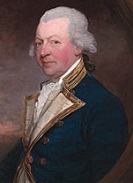
In 1763 French soldier Louis-Antoine, Comte de Bougainville (1729-1811), aide-de-camp to the Marquis de Montcalm in Canada in the Seven Years' War (who wrote a textbook on calculus at age 25) enters the navy as a capt., and next Jan. attempts to establish the French colony of Port Louis in the Falkland Islands (Islas Malvinas) using 150 expelled Acadians from Canada, but objections by Spain cause it to be abandoned in 1766, when France surrenders its claims on the islands to Spain, and after possession is transferred on Jan. 31, 1767 France renames the colony to Puerto Soledad; meanwhile in 1766 British capt. John MacBride (1735-1800) colonizes Port Egmont on Saunders Island, which is discovered and captured by Spain in 1770, and restored to Britain in 1771, after which in 1774 Britain voluntarily withdraws from the islands after leaving a plaque claiming them for George III. In Jan. 1768 Bougainville, who began a round-the-world voyage in 1766 begins a voyage to the Pacific (ends 1769), visiting Tahiti and claiming it for France, then visiting Samoa, Espiritu Santo, the N Solomons and New Guinea, Bougainville Island in the Solomons and Bougainville Strait, eventually circumnavigating the Earth; it takes him 52 days to round Cape Horn; he keeps Bougainville's Journal, which feeds the "cult of the noble savage" in Europe.
In 1763 Russian fur trader Stefan (Stephan) Glotov discovers Kodiak Island; it is not settled until 1784.


In 1766 English explorers Samuel Wallis (1728-95) of the HMS Dolphin, and Philip Carteret (1733-96) of the HMS Swallow begin sailing the Pacific in search of the fabled Southern Continent (ends 1769); after passing the Strait of Magellan they split up, and Wallis discovers Tahiti, while Carteret discovers Pitcairn Island and the Carteret Islands; Wallis names or renames 5+ islands in the Society Islands along with six atolls in the Tuamoto Islands; Wallis renames Uvea Island after himself before reaching Tinian in the Mariana Islands, then travels to Batavia, where most of his crew die from dysentery, arriving back in England in May 1768, giving useful info. to Capt. James Cook for his Pacific voyage.


In May 1768 Marton, Yorkshire, England-born Capt. James Cook (1728-79) sails for the South Pacific on a 3-year round-the-world voyage (ends 1771) timed to observe a rare transit (eclipse) of the Sun by Venus next June 3; German naturalist Peter Simon Pallas (1741-1811) travels through Russia to the Chinese frontier to observe the transit.
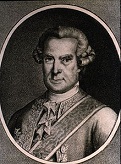
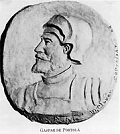

On Jan. 10, 1769 after getting concerned about Russian incursions along the Pacific coast from their base in Alaska, Spanish minister Jose de Galvez (José de Gálvez) y Gallardo, Marqués de Sonora (1720-87) sends the dual land-sea Portola (Portolá ) Expedition, led by Gaspar de Portola (Portolà) i Rovira (1716-86) to explore and settle Alta Calif. with a system of presidios (military forts) and Franciscan missions, starting with the San Carlos sailing from La Paz, followed on Feb. 15 by the San Antonio sailing from Cabo San Lucas, while the land epedition leaves Velicata on Mar. 25; on July 16 Franciscan Father Miguel Jose "Junipero" Serra y Ferrer (1713-84) ("Apostle of Calif.") founds the first of 21 Catholic missions in Calif. at Mission San Diego de Alcala (Alcalá), becoming the start of El Camino Real (the Royal Road), which becomes an Indian Roman Catholic conversion factory as well as an agricultural estate; the super climate produces early crops of grapes, oranges and olives; over the next 50 years the Franciscans build 20 more missions spaced a day's journey apart along the coast all the way to San Francisco.
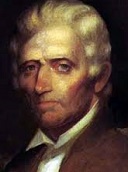

On June 7, 1769 Berks County, Penn.-born frontiersman-explorer Daniel Boone (1734-1820), who has explored the area since 1767 with six companions, incl. French-Indian War buddy John Finley (Findley) (1759-1846) settles the "Dark and Bloody Ground" (called that by Cherokee chief Dragging Canoe, referring to the endless battles between his tribe and the Creeks, Shawnee, Wyandot, and Chickasaw along the Cumberland River) of Kentucky (Iroquois "Ken-tah-ten" = land of tomorrow) (central plain?), founding the town of Boonesboro in E Ky. after being captured with his entire party by Indians in Dec., then escaping and joining up with his brother, then building the first cabin, living there during the winter; he later feels compelled to move to a new territory every time someone moves within a mile of him? Daniel Boone was a man, yes a bi-i-i-g man? On Apr. 1, 1775 after Richard Henderson organizes a band of 30 expert woodsmen led by Daniel Boone to blaze the 200-mi. Wilderness Trail (Road) from the upper Holston River in Virginia's Shenandoah Valley, over the Appalachians, and through Cumberland Gap in SW Va., they cross the Kentucky River, terminating at Boonesville, where they build the stockade Ft. Boonesborough and found the colony (proposed 14th U.S. state) of Transylvania, with Boone's wife Rebecca Bryan and daughter being among the first women settlers in Ky.

On Nov. 6, 1769 English explorer Samuel Hearne (1745-92) begins his 1st voyage to the Arctic Ocean with a band of Cree and Chipewyan Indians, leaving the Seal River N of Churchill then returning on Dec. 11 after running out of food; on Feb. 23, 1770 he begins his 2nd voyage, followed in Dec. 1770 by his 3rd voyage (ends 1772). On July 16, 1771 after discovering copper in the Coppermine River Basin, in Canada, English explorer Samuel Hearne goes beddy bye, and at midnight his Chipewyan guide Matonabbee and his warriors sneak up on some unspecting Inuits and massacre them near Kugluktuk, Nunavut, becoming known as the Massacre of Bloody Falls - bloody, bloody and all that rot? On June 30, 1772 Samuel Hearne returns to Fort Prince of Wales on the mouth of the Churchill River on Hudson Bay, becoming the first Euro to visit the Arctic and return to tell about it, walking a total of 5K mi. and exploring 250K sq. mi. and proving that there is no Northwest Passage through the continent at lower latitudes.



On Apr. 29, 1770 Lt. (not Capt. yet) James Cook of the Endeavour lands on Possession Island, and claims the whole E coast of Australia for George III under the name New South Wales, incl. Botany Bay (originally Botanist Bay), which is named by his botanist companions Sir Joseph Banks (1743-1820) (English), Daniel Charles (Carlsson) Solander (1733-82) (Swedish), and Herman Diedrich Spoering (Spöring) Jr. (1773-71) (Finnish), who have a field day discovering new it's-two-for-Tuesday specimens; in June as the ship heads N along the coast, it runs aground on Endeavour Reef (on the Great Barrier Reef) S of modern-day Cooktown on Cape York Peninsula (northernmost town on the E coast of Australia), causing them to spend seven weeks repairing it, during which time the botanists get cooking, while Scottish Quaker artist Sydney Parkinson (1745-71) makes the first Drawings of Australian Aborigines, of the Guugu Yimithirr ("saltwater people") Tribe, who teach them 50 words, incl. my-little-girl-she's-a-runaway "gangurru" (kangaroo), which is seen by bug-eyed whites for the first time; meanwhile, finding only a small native aborigine pop. of black, obviously non-human ape-men, and there being no U.N. yet to stop them, the Brits get bright ideas about white settlement; too bad, after arriving in Batavia in the East Indies, they take on tainted supplies, and Sporing dies of dysentery next Jan. 24, followed by Parkinson on Jan. 26 en route to Cape Town.

On Nov. 14, 1770 6'4" Scottish explorer James Bruce (1730-94) discovers the source of the Blue Nile in Lake Tsana (Tzana) (Dembea) in the mountains of Ethiopia S of Gondar - the White Nile is on the W not the E of the Blue Nile, therefore in Africa white isn't right?

In 1772 French explorer Yves Joseph de Kerguelen-Tremarec (Kerguelen-Trémarec) (1734-97) discovers the Antarctic Kerguelen Islands in the South Indian Ocean; too bad, he overhypes them to Louis XV as the fabled Terra Australis, getting him jailed after a 2nd expedition shows them to be desert.

In 1772 after being promoted last Aug. to the rank of cmdr., James Cook (1728-79) leaves England on HMS Resolution on his Second Voyage (ends 1775) to circumnavigate Antarctica and discover the fabled Terra Australis. On Jan. 17, 1773 British explorer James Cook (1728-79) and his crew become the first to cross the Antarctic Circle as they search for a possible continent of Antarctica, but they sight no land while becoming the first to circumnavigate it; en route they visit the Friendly Islands (AKA Tonga) (Polynesian "Tonga" = south) during the yearly festival of first fruits to the god Tu'i Tonga, and the chiefs want to kill him but can't agree on a plan, causing him to think them real friendly? In 1774 James Cook returns to New Zeland, visiting Easter Island, Norfolk Island (Oct. 10), and New Caledonia about 1K mi. NE of Sydney; he also charts and names the Y-shaped New Hebrides, 80 islands lying between New Caledonia and Fiji, discovering the Friendly Islands (Tonga), and visits Totoya Island and Vanuatu, where he discovers a panpipe, which later inspires Mozart's "The Magic Flute" and ends up on display in Vienna; when he returns from his 2nd Pacific voyage to London, he brings the first Polynesian native to England, who becomes an overnight sensation.
On Aug. 5, 1775 Spanish Lt. Juan Manuel de Ayala (1745-97) (who left Monterey on July 26) becomes the first Euro explorer to sail through the Golden Gate of San Francisco Bay in Calif., naming three islands incl. Alcatraz (Sp. "pelican") Island and anchoring his packet ship Punta de San Carlos (which he takes command of by luck after captain Don Miguel Manrique goes mad?) at Angel Island (Isla de Los Angeles) to wait for the overland expedition of Capt. Juan Bautista de Anza, then on Sept. 18 returns to San Blas via Monterey, telling them how the harbor beats Monterey for having less fog, and how friendly the natives are.
In 1775 after being sent by Antonio Maria Bucareli y Ursua, viceroy of New Spain to explore N Calif. to see if there are Russian settlements, Spanish explorer Bruno de Heceta (Hezeta) y Dudagoitia (1743-1807) discovers the Columbia River in W N. Am.; New England ship captain Robert Gray names it in 1792.
I know a place, I'll take you there? In July 1776 after dining in London with James Boswell (1740-95), who tells him he wants to accompany him on his next voyage, saying "One is carried away with the general, grand, and indistinct notion of a voyage round the world", and Dr. Samuel Johnson talks him out of it, saying "A man is to guard himself against taking a thing in general" Capt. James Cook starts his Third Voyage (last) (ends 1779) to the Pacific to search of an Atlantic-Pacific Northwest Passage from Hudson Bay to the Pacific in his ship HMS Resolution, accompanied by HMS Discovery, visiting Kerguelen Island, New Zealand, Hawaii, and NE of the Bering Strait. In 1777 Capt. James Cook sees long-board surfers in Tahiti and Oahu and observes that the sport is recreational rather than competitive - he should have realized that from the fact they are all nude?


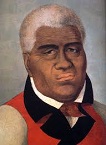
On Jan. 18, 1778 British explorer Capt. James Cook (1728-79) discovers the Hawaiian Islands, and names them the Sandwich Islands after his friend John Montagu, 4th Earl of Sandwich (1718-92), first lord of the admiralty in 1771-82; after being taken for a god (Lono?), he leaves on a quest for the Northwest Passage in the Arctic, recording the first encounter with totem poles in Vancouver Island, calling them "house posts that depicted anthropomorphic beings" - an example of kulturkreis or simultaneous evolution? In Nov. Capt. Cook returns to Hawaii after failing to find the Northwest Passage, and first spots the Hawaiian island of Molokai, ruled by Kahekili (Kane-Hekili) (Kahekilinui'ahumanu) II (1737-94), who also rules Lanai, Kahoolawe, and Maui (except the Hana district); Kalani'opu'u (1729-82) (Terreeoboo, King of Owhyhee according to Capt. Cook), king of the big island of Hawaii sends his army under warrior-gen. Kamehameha I the Great (1737-1819) to Lana'i (Lanai), under the rule of Kahekili II, and they massacre 3K on the island, which gives the island its name, meaning "day of conquest".
On Feb. 14, 1779 Capt. James Cook (b. 1728) is murdered in Kealakekua Bay (which he first sighted on Jan. 17, and performed the first Christian service on the islands on Jan. 28 for a dead crew member) on the W (Kona or dry) side of Hawaii Island by Hawaiian natives in a conflict over a stolen boat after he gets cooky, er, cocky and holds chief Kalani'opu'u (1729-82) hostage; if only he could swim?; the survivors return to England via the East Indies and the Cape of Good Hope; Kalani'opu'u's son Kiwala'o (1760-82) becomes king of Hawaii (until July 1782), and his nephew Kamehameha I (1737-1819) becomes guardian of the god of war Kukailimoku.

In 1785 French naval officer Jean-Francois de Galoup, Comte de La Perouse (Pérouse) (1741-88) Jean-Francois de Galoup, Comte de La Perouse (Pérouse) (1741-88) leads a royal French expedition to the Pacific in the ships Bustamove and Asshole, er, Astrolabe and Boussole, carrying specialists in the sciences, and visits the Hawaiian islands, Macao, Philippines, Japan, Kamchatka, and Korea, discovering the La Perouse (Soya) Strait between S Sakhalin Island and Yezo (Ezo) (Yesso) (Hokkaido); in Samoa they encounter hostile natives, losing the capt. and 11 crew of the Astrolabe; they then head for the Solomons (ends 1788); in 1786 La Perouse lands near Makena Beach on S end of the Hawaiian island of Maui and discovers and maps La Perouse Bay, during which time Haleakala erupts for the last time in modern history. Win some, laperouse some? In Jan. 1788 La Perouse's ships reach Botany Bay, and he writes a letter dated Feb. 7; his ships are both wrecked at Alpha Ceti 6, er, Alpha Ceti 5, er, Vanikoro Island in the Solomon Islands N of the New Hebrides, and he is never seen again; the wreckage is discovered in 1826.
On Sept. 30, 1787 Am. fur-trading ship Lady Washington, captained by Robert Gray (1755-1806), and fur-trading ship Columbia Rediviva, captained by John Kendrick (Kenrick) (1740-94) are sent by a group of Boston merchants incl. Charles Bulfinch from Boston, Mass. to trade pelts on the Pacific Northwest coast and take them to China, based on Capt. Cook's success in selling otter pelts in Canton; on Aug. 9, 1790 Gray arrives in Canton, trading his cargo for tea, continuing on a round-the-world voyage and arriving in Boston on Aug. 9, 1790 with a Hawaiian islander he parades through Boston, becoming the first Am. vessel to circumnavigate the globe.

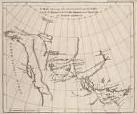
On June 3, 1789 Scottish-born North West Co. fur trader Sir Alexander Mackenzie (1764-1820), using charts provided by trailblazer (Conn. Yankee) Peter Pond (1740-1807) sets off from Ft. Chipewyan near Lake Athabasca in Alberta, Canada with 13 companions in three canoes, arriving at the Arctic Ocean, and discovering the Mackenzie River system; after traveling with French-Canadian voyageurs up the Mackenzie River, exploring W Canada to the Arctic, he had hoped the northerly river would turn W and end up in the Pacific Ocean, so he goes back to the drawing boards and plans another trip.
In 1789 French explorer Louis Armand, Baron de La Hontan (1666-1715) explores the Upper Mississippi River Valley and allegedly discovers the "Riviere Longue" (Missouri River), along with the Great Salt Lake in modern-day Utah.

On Aug. 9-10, 1790 the Columbia, captained by Robert Gray (1755-1806) returns to Boston Harbor after a 3-year voyage E via China (begun Sept. 30, 1787), becoming the first ship to carry the U.S. flag around the world; he then begins a 2nd voyage to the NW Am. coast - wasn't that the name of the shuttle that went kaboom? On May 11, 1792 he enters the estuary of the Columbia River (which he names after his ship) in NW Am., which event is later cited by the U.S. when claiming the region.


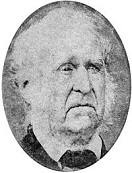
In 1790 the British Vancouver Expedition (ends 1793) led by English naval Capt. George Vancouver (1758-98) and 2nd Lt. Peter Puget (1765-1822) begins exploring the NW Am. coast; in 1792 they explore 100-mi.-long Puget Sound, names 14,408-ft. Mt. Rainier after British Adm. Peter Rainier (1741-1808), circumnavigates Vancouver Island, then heads for Hawaii, discovering the yummy Chatham Islands (10 islands 800 km E of New Zealand) (later the first inhabited land on Earth to greet the first dawn of each year) along the way; in 1793 Vancouver brings a gift of one bull and five cows to Hawaiian king Kamehameha I on the Big Island of Hawaii, who escape and multiply, damaging the ecosystem until Newton, Mass.-born John Palmer Parker (1790-1868) establishes Parker Ranch on the N slope of Mauna Kea in 1847; in 1794 Vancouver claims the Hawaiian Indians, er Islands as a protectorate of Great Britain.
In May 1792 Alexander Mackenzie leaves with nine companions and 1.5 tons of supplies in a 25-ft. birch bark canoe to find a westerly route to the Pacific Ocean from Peace River near Lake Athabasca in Alberta, Canada; they reach the Continental Divide on June 12 after deciding to take the Parsnip River south rather than the Finlay River north at Willaston Lake.

In 1792 French navigator Antoine Raymond Joseph de Bruni d'Entrecasteaux (1739-)93 of France begins a rescue expedition for La Perouse (disappeared 1788), visiting many Pacific islands and exploring New Caledonia (until 1793); he discovers the D'Entrecasteaux Islands SE of New Guinea, incl. Ferguson, Goodenough and Normanby, inhabited by Papuans.

On July 21, 1796 after leaving Portsmouth, England last May 22 on the Endeavor, and reaching the Gambia River on June 21, disembarking on Dec. 2 to explore the interior with two native guides, getting captured and imprisoned by a Moorish chief for 4 mo. and escaping on July 1 with only a horse and pocket compass, Scottish surgeon-explorer Mungo Park (1771-1806) becomes the first European to discover the Niger River near Segou in modern-day Mali, following the river 300 mi. to Bamako and returning to Scotland via Antigua on Dec. 22, causing a sensation with the big news. In 1799 he pub. Travels in the Interior Districts of Africa: Performed under the Direction and Patronage of the African Association in the Years 1795, 1796, and 1797,. announcing his big discovery of the Niger River, becoming a big hit and increasing interest in Africa, inspiring other explorers; "Whatever difference there is between the negro and European, in the conformation of the nose, and the colour of the skin, there is none in the genuine sympathies and characteristic feelings of our common nature"; "They [Mandinkas] were all very inquisitive, but they viewed me at first with looks of horror, and repeatedly asked if my countrymen were cannibals. They were very desirous to know what became of the slaves after they had crossed the salt water. I told them that they were employed in cultivating the land; but they would not believe me... A deeply-rooted idea that the whites purchase negroes for the purpose of devouring them, or of selling them to others that they may be devoured hereafter, naturally makes the slaves contemplate a journey towards the coast with great terror, insomuch that the slatees are forced to keep them constantly in irons, and watch them very closely, to prevent their escape."
On Sept. 2, 1796 the Am. brig Sally from Boston, Mass. accidentally grounds on a shoal near Johnston (Kalama) Island (Atoll) and Sand Island 860 mi. SW of Honolulu, Hawaii, after which Capt. Joseph Pierpont pub. his discovery but doesn't claim or name them, which happens when British Capt. Charles J. Johnston of the HMS Cornwallis sights them on Dec. 14, 1807.
In 1797 German adventurer Friedrich Konrad Hornemann (1772-1801) explores the caravan routes of the Sahara.
On June 14, 1798 Kingman Reef (originally Danger Reef) about 1K mi. S of Hawaii is discovered by U.S. Navy Capt. Edmund Fanning (1769-1841), "Pathfinder of the Pacific" of the ship Betsey; on Nov. 29, 1953 it is described by Capt. W.E. Kingman, who names it.
On Nov. 8, 1798 English capt. John Fearn (b. 1768?) of the whaling ship Hunter en route from New Zealand to China discovers 8 sq. mi. Nauru (originally Pleasant Island) in Micronesia,which becomes the 3rd smallest country on Earth after Vatican City and Monaco.
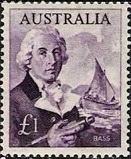
In 1798 British naval surgeon-explorer George Bass (1771-1803) circumnavigates Van Diemen's Land (Tasmania) in the sloop Norfolk, getting Bass Strait named after him.

In 1799 German geographer-explorer Baron Friedrich Wilhelm Heinrich Alexander von Humboldt (1769-1859) begins exploring Latin Am. (until 1804); in 1800 he proposes that South Am. had once been joined with Africa - just look how Brazil fits into the Gulf of Guinea? In 1845-62 he pub. the bestseller Kosmos (Cosmos) (5 vols.), retracing the history of Science and showing its Greek origins, claiming that contemplation of the beauty of the Cosmos holistically viewed as a single entity gives one a superior outlook on life.
The first half of the 19th cent. is referred to as "the white man's graveyard" for the high death rate of European explorers in West Africa from disease, wild animals, and hostile natives, slowing down exploration - a missionary in every cooking pot jokes here?
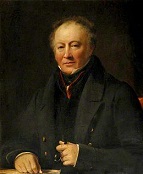
In 1801 Dutch East India Co. explorer Sir Petrus Johannes (Pieter Jan) Truter (1747-1825) of the Cape Colony judicial bench and Scottish-born British army physician Dr. William Somerville (1771-1860) begin an expedition into Africa; in 1802 they explore Bechuanaland to buy cattle.

In 1802 English explorer Capt. Matthew Flinders (1774-1814) circumnavigates Australia, discovering cool pink Lake Hillier on Middle Island in Western Australia.



The Lewis and Clark Expedition, or, The Original Mild-Mannered Forensic Anthropologist, or, White Devils Visit the Unsuspecting Indians? On May 14, 1804 Virginians Capt. Meriwether Lewis (1774-1809) (the ugly one) and 2nd Lt. William Clark (1770-1838) (the handsome one), leading the 45-man Lewis and Clark (Corps of Discovery) Expedition (ends Sept. 1806) (named by carpenter Louis Glass) ($2.5K in expense money allotted by Congress) push their three boats carrying 30 tons of supplies into the Missouri River from Camp Wood near St. Louis, say goodbye to the cheering French village of St. Charles, and set out to explore the Am. West, looking for a water route to the Pacific; Clark is accompanied by his black slave York (1770-1831), and Lewis by his 150-lb. Newfoundland dog Seaman (purchased for $20 in Pittsburgh, Penn.); on July 7 they leave St. Joseph, Mo. along the Missouri River; when one of their boats proves too big to cross a certain point in the river, they send it back with 7 men; in Nov. after portaging the Great Falls, they stop and spend the winter in North Dakota at the Hidatsa-Mandan village winter camp (who are friendly even though suffering from white man's smallpox?) on the banks of the frozen Missouri River; they hire Hidatsa (Lemhi Shohone?) Indian interpreters Sacagawea (Sacajawea) (Sakakawea) (1788-1812) (pr. suh-KAH-guh/juh-WEE-uh) (Hidatsa "bird woman") (Shoshone "boat launcher or puller") and her fur trader husband Toussaint Charbonneau (1717-1843); her child Pompy (Jean Baptiste) goes along; they name the Nez Pierce ("pierced nose") Indians from you know what; the Arikaras try to bring bear spirits to life from clay models and call on the grizzlies to stop the white devils from destroying their way of life?
You say goodbye and I say hello? On Nov. 15, 1805 after sighting 850-ft. Beacon Rock on the Columbia River, the Lewis and Clark Expedition sights the Pacific Ocean, bringing a closure to the exploration of the continent begun by Columbus 313 years earlier, Clark writing "I landed and formed a camp on the highest spot I could find, from this I could plainly see the extent of our journey in full view of the ocean... Ocean in view! O! The Joy!"; they first see the Calif. condor, describing it as probably the biggest bird in Am.; they then spend a miserable winter near the mouth of the Columbia River, discovering abundant wildlife and rich soil in modern-day Yakima Valley, Wash., which in the 20th cent. becomes known as "the Fruitbowl of the Nation"; they encounter Umatillas using sign language that they interpret as meaning they think the whites are from heaven, but actually they were complaining that the pale morons had shot a flying crane for no good reason?
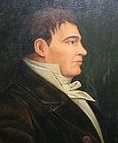
In 1805 Hoosick, N.Y.-born explorer Simon Fraser (1776-1862) explores Canada west of the Rocky Mts., charting the future Canadian province of British Columbia and building the first Euro settlement there, helping establish the Canadian border at the 49th parallel; in 1808 he explores the Fraser River.
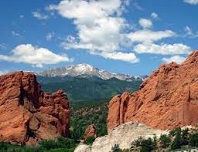


In 1805 Zebulon Montgomery Pike explores Minnesota, searching for the headwaters of the Mississippi River and stopping on Dec. 25 in Ojibwe territory at the site of the future city of Brainerd, Minn. (founded 1870, incorporated 1873), becoming the site of Ft. Ripley in 1849-77; he negotiates a treaty with the Sioux (Dakota) ceding 100K acres, incl. most of Mineapolis and St. Paul at the confluence of the Minnesota and Mississippi Rivers; on July 15, 1806 he leaves St. Louis to explore New Mexico looking for the sources of the Arkansas River; on Nov. 15 he sights 14,109 ft. (4,267m) pink granite Pikes Peak (El Capitan to the Spanish, which he calls Highest Peak because it's higher thany any peak in the U.S. to the E) in S Colo. (64 mi. S of Denver), but fails in an attempt to climb it, declaring that it will never be climbed (the Utes probably did it all the time to get eagle feathers?), then makes a roundabout return by way of Santa Fe after Spanish soldiers capture his party; his accounts are pub. before those of Lewis and Clark, creating the myth that the Am. West is a "Great American Desert" unfit for human habitation (and hence the place to banish Indian tribes to); in summer 1820 Vt.-born botanist Edwin P. James (1797-1861) becomes the first to climb it while working for explorer Stephen Harriman Long (1784-1864) on his expedition "from the Mississippi to the Rocky Mountains", discovering the health benefits of the mineral waters in Manitou Springs, Colo., and making the first ascent of 13,3K ft. (4,054m) James Peak.
On Mar. 23, 1806 explorers Lewis and Clark begin their return journey. In Sept. 1806 the Lewis and Clark Expedition (begun May 1804) ends after going 8K mi. and visiting 58 Indian tribes; Clark frees his slave York, who was allowed to carry a gun and whose black skin was a curiosity to every Indian tribe they met (the first black to cross the North Am. continent N of Mexico?); Sgt. Charles Floyd, the only casualty in the party dies of a burst appendix near Sioux City; Pres. Jefferson is presented with two bears, which he houses in cages in the White House; always thinking, Pres. Jefferson envisions an independent nation in NW North Am. called the Repub. of the Pacific, which survives to modern times as a proposal for the Repub. of Cascadia, consisting of British Columbia, Ore. and Wash., plus maybe parts of Idaho, N Calif., the Yukon and Alaska; in 1941-2 the State of Jefferson exists for about 10 mo. until Pearl Harbor kills it.

In 1810 the Pacific Fur Co. of America's first millionaire John Jacob Astor (1763-1848) finances the Astor Expedition (ends 1812) overland to the W from St. Louis, founding Ft. Astoria next Apr. on the Columbia River as a fur trading post, becoming the first white settlement in Ore.; in Nov. 1812 expedition member Robert Stuart discovers the 20-mi.-wide South Pass through the Rocky Mountains, becoming the basis of the Oregon Trail; too bad, the British capture Astor's trading posts during the War of 1812, renaming Ft. Astoria to Ft. George and shutting his fur biz down.

In 1811 Westminster, London, England-born Hudson's Bay Co. explorer and mapmaker ("the Stargazer") David Thompson (1770-1857) discovers Athabaska Pass over the Continental Divide in the Canadian Rockies from the Whirlpool River in Alberta to Wood River in British Columbia, which leads to the Columbia River and Pacific Ocean; he goes on to map 1.9M sq. mi. (4.9M sq. km) of North Am., becoming known as "the greatest land geographer who ever lived".
In 1815 French-Canadian trapper Jaques La Ramie (Ramee) (Ramée) (1784-1821) organizes a free-trapper rendezvous at the junction of the North Platte and Laramie Rivers, going on to explore the Laramie River in 1820 until he mysteriously fails to arrive at a rendezvous in 1821 and is never seen again; in the mid-1860s the town of Laramie, Wyo. is named after him.


In 1818 British explorers Sir John Ross (1777-1856) and Sir William Edward Parry (1790-1855) launch twin expeditions to Baffin Bay.
On Feb. 19, 1819 while rounding the Horn, English Capt. William Smith (1790-1847) of the Williams discovers the 1,424 sq. mi South Shetland Islands 75 mi. N of the Antarctic Peninsula off Graham Land; on Oct. 16 after the authorities don't believe him, he lands on the largest island, King George Island, and next year he is sent to survey the discovery, discovering the Antarctic Peninsula; later Smith Island and Cape Smith are named for him.


In July 1819 Russian explorers Fabian Gottlieb von Bellinghausen (1778-1852) and Mikhail Petrovich Lazarev (1788-1851) lead the two corvettes Vostok (Russ. "East") and Mirny (Russ. "Peaceful") around the Antarctic Circle, discovering Traversay Island in Dec., then reaching lat. 70 deg S, discovering Peter Island and Alexander Land. On Jan 1820 they become the first to see the mainland of Antarctica, disproving the claim of Capt. Cook that it is impossible to find land in the S ice fields, going on to circumnavigate the continent 2x; in 1822-5 Lazarev circumnavigates the globe for the 3rd time on the frigate Kreyser.


A mini-Titanic 70 years early, caused by the uncanny British knack for arrogant refusal to provide backup equipment? In 1819 British Royal Navy officer Sir John Franklin (1786-1847) begins exploring N Canada by land from Hudson Bay E to the mouth of the Coppermine River, turning into a disaster after he falls into the Hayes River at Robinson Falls and is rescued by a member of his expedition, then loses 11 of his 20 men to starvation, causing them to be reduced to eating their own leather boots; they return in 1822. In 1825 British explorer Sir John Franklin (1786-1847) leaves on his 2nd expedition in the Canadian Arctic region, leaving Hudson Bay and reaching Great Slave Lake, then traveling 1K mi. down the Mackenzie River, becoming the 2nd Euro to reach its mouth on Aug. 16 before returning and wintering in Ft. Franklin on Great Bear Lake; meanwhile Sir William Edward Parry (1790-1855) sails W from the Atlantic Ocean in an attempt at a rendezvous, ending up frozen in place 900 mi. E, and Frederick William Beechley sails NE from the Bering Strait, reaching Point Barrow; next summer Franklin goes back downriver and finds the ocean frozen, giving up on Aug. 16, 1826 at Return Reef 150 mi. E of Beechey's Point Barrow, and returning to Ft. Franklin on Sept. 21; in 1821 Edward Parry begins a 2nd expedition to Baffin Bay (ends 1823) (first 1818). On May 19, 1845 after becoming lt.-gov. of Van Diemen's Land in 1837-43, Franklin begins an expedition to discover the elusive Northwest Passage in two British ships, HMS Terror (converted warship used in the War of 1812) and HMS Erebus, with a total of 129 crew; the well-financed expedition fits the ships with steel-plated hulls, locomotive-type steam engines and hot water heat, and enough food and rum for 3-5 years; too bad, the 20-ft. pack ice proves too thick, the water freezes in -100 F weather, the food cans are sealed with lead solder in them, and the 5 tons of lime juice loses its Vitamin C potency in a few years, causing scurvy; worse, there are no backup plans for escape on foot, and no sleds or hunting-fishing equipment; whalers spot the ships in Baffin Bay in the fall, the crew in good spirits as they head into the Arctic; after heading S through Peel Sound the ships get stuck in King William's Sound in Sept. 1847, find themselves in a 5-year stretch without any summer ice melting, and after three years where some resort to cannibalism, the survivors head south on foot, dying one by one of starvation and exposure; only a few graves are later discovered, along with a stone cairn containing a note recording Franklin's death on June 11, 1947; meanwhile the stupid British govt. refuses to send search expeditions until they're already dead, then disbelieves reports from Inuits that they were turning black from scurvy, frostbite, and lead poisoning, and in the "last resort" of cannibalism; after the British public is shocked by the loss, and Lady Jane Franklin spurs them on, search expeditions continue until 1859, leaving a mystery for 150 years until the pieces are put together - hello, mommy?
In 1820 Americans, British, and Russians vie to claim to be the first to sight the Antarctic continent.

On Apr. 8, 1820 the 6'8" (203 cm) armless topless Venus de Milo sculpture of Aphrodite by Alexandros of Antioch is discovered on the Greek island of Milos (Melos) by peasant Yorgos Kentrotas, then given by French naval officer Jules Sebastien Caesar Dumont d'Urville (1790-1842) to French ambassador to Turkey (1815-21) Charles-Francois de Riffardeau, Marquis de Riviere (1763-1828), who arranges for its purchase by the French govt.; Riviere is created duke in 1825. On Aug. 11, 1822 French corvette La Coquille (Fr. "Shell"), captained by Louis Isidore Duperrey (1786-1865) and manned by Jules Sebastien Cesar Dumont d'Urville (1790-1842) et al. leaves Toulon, going on to visit Ascension Island, St. Catherine Island, the Falkland Islands, Tahiti, and New Holland Island, and circumnavigate the Earth by 1825. On Apr. 22, 1826 the French vessel Astrolabe (converted horse barge, captained by Jules Sebastien Cesar Dumont d'Urville (1790-1842) sets out to find traces of lost explorer Count de la Perouse (d. 1788), exploring the S Australian coast, New Zealand, New Guinea, New Caledonia, and other W Pacific islands, finding evidence of him on Vanikoro Island, and returning to Marseille on Mar. 25, 1829. In 1838 an expedition by the Astrolabe and Zelee, captained by gout-ridden d'Urville (which left last year) discovers Palmer Land and Joinville Island in the Antarctic. In 1840 d'Urville sails from Hobart, Tasmania, and discovers Adelie (Adélie) Land in Antarctica, naming it for his wife and claiming it for France; D'Urville Sea N of Adelie Land (where a Russian ship plants a flag to mark the location of the Earth's south magnetic pole in 2008), and Cape d'Urville in Netherlands New Guinea are named after him; he discovers and names the cute Adelie Penguin, and becomes a big hero, being promoted to rear adm. on his return.

On June 6, 1820 an expedition led by Maj. Stephen Harriman Long (1784-1864) goes W from the Missouri River into Neb., and along the Platte River, sighting 14,259-ft. Longs (not Long's) Peak near Estes Park, Colo. (northernmost of the 54 "fourteeners" in the Colo. Rocky Mts.) on June 13; when he returns, Long reports that the entire area between the Missouri River and the Rocky Mts. is unsuitable for farming, despite seeing fields of corn, beans, and pumpkin being cultivated by Pawnees, causing the Great Plains to become known as the "Great American Desert" for the next 50 years; by the 20th cent. it contains the largest irrigated area on Earth.
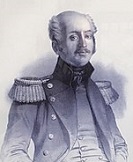
On Nov. 2, 1820 after sailing from St. Petersburg, Russian explorer Baron Ferdinand Friedrich Georg Ludwig von Wrangel (1797-1870) reaches Nizhnekolymsk, switching to dog sleds and journeying to Cape Shelagsky next year, then sailing up the Kolyma River 125 mi. into the interior (Yakut country), resuming on Mar. 10, 1822 and traveling on the ice for 46 days, reaching 72 deg 2 min. N lat. before returning to St. Petersburg on Aug. 15, 1824 with the news that there is open sea not dry and N of Cape Shelagsky, describing the coastline of Siberia from the Indigirka River to Kolyuchinskaya Bay in the Chukchi Sea; in 1825-7 he commands the Krotky on a world voyage, then on June 1, 1830 becomes gov. #6 of Russian Am. (until Oct. 29, 1835).
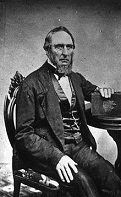
On Nov. 20, 1820 the whale ship Essex is rammed and sunk by a sperm whale, and first mate Owen Chase (1797-1869) writes (or narrates to William Coffin Jr.) an account that is pub. next year, inspiring Herman Melville to write "Moby Dick".


In 1820 Mich. Territory gov. #2 (1813-31) Lewis Cass (1782-1866) leads an expedition to N Minn. to discover the source of the Mississippi River, and claims 10-mi.-long. Cass Lake in NC Minn. as the source; expedition geologist Henry Schoolcraft (1793-1864) changes it to nearby Lake Itasca in NW Minn. in 1832.
In 1820 Recently-graduated botanist Edwin James becomes the first white to ascend Pikes Peak in Colo., along with other Colo. peaks.

In 1820 Conn.-born Am. seal hunter Nathaniel Brown Palmer (1799-1877) of the sloop Hero becomes the first white man to sight Antarctica, discovering Palmer Peninsula (Land), the most northerly part, directly S of South Am., between the Weddell Sea on the E and Bellinghausen Sea on the W.
In summer 1821 Sir William Edward Parry begins a 2nd expedition to Baffin Bay (ends 1823) (first 1818) in the Royal Navy ships HMS Fury and HMS Hecla, getting stuck in the ice in Oct. and getting free 8 mo. later, meanwhile getting a tip from the native Inuit and discovering the Fury and Hecla Strait between Baffin Island and Melville Peninsula next year, which connects Foxe Basin with the Gulf of Boothia.

In Sept. 1821 Mo. trader William Becknell (1787-1856) leads a party up the Arkansas River on a horse-trading expedition, stumbles onto Mexican soldiers, and is told that they are welcome in Santa Fe to trade for gold, silver and furs, opening the Santa Fe Trail, a 780-mi. overland route between Independence, Mo. and Santa Fe, N.M. which takes 100-200 white merchants round-trip once a year until supplanted by a monthly stage in 1850 and the Santa Fe Railroad in 1880; on the first journey Becknell discovers Hispanic ladies smoking "seegaritos".
On Dec. 6, 1821 the 240 sq. mi. Powell Group (South Orkneys) of islands in the South Pacific is discovered by English sealer George Powell (1794-1824) and Am. sealer Nathaniel Brown Palmer (1799-1877), incl. Coronation Island and Laurie Island, claiming them for England.


The original Indiana Jones and Beloc? In 1822 Edinburgh-born Scottish explorer Maj. Alexander Gordon Laing (1793-1826) sails from Falmouth, Scotland to Sierra Leone to join the Royal African Corps, visiting Mandingo country and attempting to find the source of the Niger River; in 1825 he begins a 2K-mi. 400-day trek across the hot Sahara, braving Tuaregs, who wound him in 24 places, and on Aug. 18, 1826 he becomes the first Euro to visit the lost city of Timbuktu near the Niger River in Mali, getting past the Muslims by posing as the "Christian envoy of the king of England", finding a squalid mud settlement stinking of human waste and garbage, spending 35 days touring it and dispatching a letter on Sept. 21 before the Muslim Fulla chieftain Bello expels him as an infidel, after which he is murdered as he heads for the coast on Sept. 26, his fate remaining unknown for two years, during which time French explorer Auguste Rene Caillie (René Caillié) (1799-1838) returns and claims that he found it first in Apr.-May 1828 French explorer Rene via a shorter route than Laing's, starting in Morocco rather than Tripoli, becoming the first Euro to return alive from it.
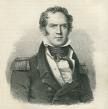
On Feb. 17, 1823 Scottish explorer-botanist Bain Hugh Clapperton (1788-1827) and British naval surgeon Walter Oudney (1790-1824) discover Lake Chad in C Africa while on an expedition from Tripoli to explore the Niver River, becoming the first Euros to accomplish a N-S crossing of the Sahara Desert; Oudney dies next Jan. 12 in Murmur (near Katagum) on the road to Kano, and Clapperton continues to Sokoto, capital of the Fula Empire, and returns to Tripoli on Jan. 26, 1825; too bad, after becoming a big hero and publishing an account of his journeys, he decides to return to Sokoto, where Sultan Bello detains him, and he ends up dying of dysentery on Apr. 13, 1827.

In Feb. 1823 English seal hunter James Weddell (1787-1834) begins an expedition to search for seals, and sails to 74 deg. S, discovering the Weddell Sea (main source for the bottom water of the world ocean), and the cute cuddly Weddell Seal.
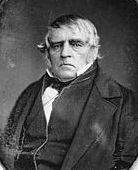
In 1824 Canadian fur trader Peter Skene Ogden (1790-1854) begins exploring the Snake River Valley (until 1830) incl. Ore., Wash., Nev., Calif., Utah, Idaho, and Wyo., incl. the Great Salt Lake, Weber River, and Ogden River; the city of Ogden, Utah is later named for him.
In 1824 Ky. frontiersmen Sylvester Pattie (1782-1828) and his son James Ohio Pattie (1804-51) lead 116 men through the Am. Southwest for six years, suffering from hardships that whittle them down to 16 men by 1827, finally reaching San Diego, Calif., only to be arrested as spies by the Mexican authorities; after Sylvester dies, James is released after producing some smallpox vaccine and vaccinating the pop., then returns to the U.S. in 1830 flat broke; in 1831 he and Timothy Flint pub. The Personal Narrative of James O. Pattie of Kentucky.

In winter 1824/5 Va.-born mountain man James "Jim" Bridger (1804-81) becomes the first white to explore the Great Salt Lake (which he believes to be an arm of the Pacific Ocean due to its saltiness), then visits Yellowstone; when he returns, his description of geysers and other wonders are scoffed at as "Jim Bridger's lies".
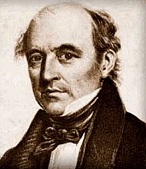

In 1827 English-born botanist-explorer Allan Cunningham (1791-1839) discovers the rich Darling Downs in the hinterland of Brisbane, Queensland, Australia (EC coast), named after cruel N.S.W. gov. (1825-31) gen. Sir Ralph Darling (1772-1858).

In 1827 Tioga County, N.Y.-born frontiersman Jedediah Strong Smith (1799-1831) becomes the first white man to cross the Great Basin incl. the Bonneville Salt Flats in NW Utah; he explores the Great Salt Lake and names it after himself, but it doesn't stick.

On Feb. 2, 1829 after being approved by N.S.W. gov. Sir Ralph Darling last Nov. 4 to explore the Macquarie River region in W New South Wales, India-born British Capt. Charles Napier Sturt (1795-1869) discovers the 915-mi. snaky Darling River while looking for the great inland sea, returning to Wellington Valley on Apr. 21; next Jan. 7 he begins a 2nd journey (ends 1830), descending the Murrumbidgee and River and discovering the 1,558-mi. Murray River (Australia's longest river), following it to its confluence with the Darling River, proving that all W-flowing river flow into it, then following the Murray to its mouth past Lake Alexandrina, discovering a maze of sandbars that are impassable to shipping; after trying to row upstream and running out of supplies, which causes Sturt to go blind, they arrive in Sydney after traveling 2.9km by river.


In 1829 Scottish-born British explorer Sir John Ross (1777-1856) of Scotland and his nephew Sir James Clark Ross (1800-62) begin a voyage in N Canada (ends 1833). In 1831 they discover the location of Earth's magnetic North Pole near Ellesmere Island in Canada; starting in 1904, the pole begins shifting NE at about 9 mi. a year, speeds up again in 1989, and by 2007 is heading toward Siberia at 34-37 mi. a year.

In 1831 French-born Am. explorer U.S. Army Capt. Benjamin Bonneville (1796-1878) of the U.S. Army heads an expedition guided by Jim Bridger (ends 1836) to explore the Intermountain West between the Rocky Mts. and Calif., and finds them not all flat; Bonneville Salt Flats are later named after him by geologist Grove Karl Gilbert.

In 1832 British explorer Brian Houghton Hodgson (1800-94) pub. his experiences in N Nepal incl. the first report of the Yeti, which he concludes is an orangutan; the term "Abominable Snowman" is coined in 1921.
In 1832 Henry Schoolcraft returns to N Minn. (1st time 1820) and discovers the true source of the Mississippi River in Lake Itasca (Lat. "veritas caput" = true head) in NW Minn.; later Schoolcraft River, the first major tributary is named in his honor.

In 1834 Roane County, Tenn.-born trapper Joseph Reddeford "Joe" Walker (1798-1876) et al., who set out in 1832 with Benjamin Bonneville on a trapping expedition in the Am. West, killed a bunch of helpless Digger Indians, visited Yosemite and became the first Euros to see the waterfalls, followed by the redwood forests, then holed up in Monterey, Calif. from Nov. 1833-Jan. 13, 1834 discovers 5,250 ft. alt. Walker Pass in the S Sierra Nevada Mts. at the S end of the San Joaquin Valley, which later becomes a major gringo gateway into Calif. during the Calif. Gold Rush.

In 1834 Mass. ice harvester Capt. Nathaniel Jarvis Wyeth (1802-56) (the original Capt. James T. Kirk?) leads 21 men from Independence, Mo. to the Am. Northwest along the Platte River; after half of the men turn back, Wyeth and 11 men reach Ft. Vancouver on the Columbia River; in 1839 ornithologist John Kirk Townsend (1809-51) pub. Narrative of a Journey Across the Rocky Mountains to the Columbia River, and a Visit to the Sandwich Islands, a narrative of the journey which paints such a rosy picture that "Oregon fever" spreads through the Am. Midwest, causing thousands to set out from Independence singing "O Susanna, don't you cry for me".
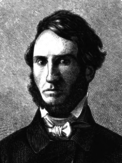
In 1839 after traveling to Europe, Egypt, and the Levant, Shrewbury, N.J.-born John Lloyd Stephens (1805-52) is commissioned by Pres. Martin Van Buren as special ambassador to Central Am., witnessing the fall of the Federal Repub. of Central Am. before exploring the lost world of the Mayas in 1840-1, after which in 1841 he pub. Incidents of Travel in Central America, Chiapas and Yucatan (2 vols.), illustrated by his partner Frederick Catherwood (1799-1854); their travels to the lost Mayan world in 1840-1 incl. Chichen Itza; big hit, causing travelers to flock in; Edgar Allan Poe becomes a fan.
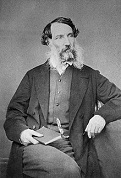
In 1840-1 British colonist Edward John Eyre (1815-1901) explores South and West Australia, becoming the first Euro to traverse the coastline of the Great Australian Bight and Nullarbor Plain - lay me kangaroo down, sport?

In Jan. 1841 after sailing to the Antarctic in 1839 aboard HMS Erebus and HMS Terror, British explorer Sir James Clark Ross (1800-62) discovers Victoria Land, Ross Island, the Ross Sea, the Ross Ice Shelf et al., and goes on to explore and claim large areas of the Antarctic for Britain by 1843, setting a southern latitude record that lasts for 60 years - and now everybody snowboarding the Transantarctic Mountains has to stop by and say aloha?



On Aug. 13-15, 1842 13,745 ft. (4,189m) Fremont Peak in Wyo. is first climbed by Am. explorer John Charles Fremont (1813-90) (son-in-law of Mo. U.S. Sen. Thomas Hart Benton) on the first of four expeditions of the Am. West., guided by Christopher Houston "Kit" Carson (1809-68), going on to pub. A Report on an Exploration of the Country Lying between the Missouri River and the Rocky Mountains on the Line of the Kansas and Great Platte Rivers, which was printed by newspapers across the U.S., making him a celeb, with the nickname "The Pathfinder", describing the 700-mi. Old Spanish Trail from Santa Fe to Los Angeles, parts of which go back to the 16th cent., which has been extensively used by pack trains since 1830 (until the mid-1850s); Carson goes on to become the most famous Am. frontiersman after Daniel Boone. In summer 1843 John Charles Fremont (1813-90) goes on his 2nd expedition, crossing the Rocky Mts. N of the Great Salt Lake, and down the Snake River and Columbia River to Oregon, then W to Lake Tahoe next Feb. 14, and down the E slopes of the Sierra Nevadas through Carson Pass into the Central Valley of Calif. to scope it out for gringos waiting for da news back east, then down the American River Valley to Sutter's Fort in Sacramento, then S along the E edge of the San Joaquin Valley, then E through Tehachapi Pass to modern-day Las Vegas, Nev., then N through Utah to South Pass, proving that the Great Basis doesn't have any river flowing towards the sea, disproving the legend of a Buenaventura River; in 1845 Fremont pub. a new map, which is pub. by Congress and used by thousands of immgrants to Ore. and Calif. in 1845-9 incl. the Calif. Gold Rush, inspiring the Mormons to settle in Utah. On June 1, 1845 John C. Fremont and his 55 men leave St. Louis searching for the source of the Arkansas River, and when they don't find it, they hastily travel to the Sacramento Valley in Calif. next Jan., trying to stur up a war; in Sonoma after hearing of the U.S.-Mexican War a group of gringo Americans capture Mexican Gen. Mariano Guadalupe Vallejo (1807-90) on June 14 and declare the independent Calif. Repub., making up a flag with a Calif. grizzly and star painted on white cloth; the Bear Flag Revolt begins; by late June Fremont endorses the new repub. and sets out for Monterey, but before he arrives the revolt ends as the commodore of the U.S. Pacific Fleet sends a shore party to raise the Stars and Stripes and proclaim Calif. as part of the U.S.; in July Robert F. Stockton becomes the new commodore and prepares to invade S Calif., enlisting Fremont's band as the Calif. Battalion and promoting him to maj.; the Mexican loyalists flee, and on Aug. 17 Stockton declares himself gov. of Calif., with Fremont as military cmdr. in the N.
In 1843 Scottish explorer Sir James Ross proves that Antarctica has an ice barrier.
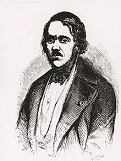
In 1843 after being sent by Louis Philippe with two botanists and a taxidermist, French naturalist Francois Louis Nompar de Caumont La Force, Comte de Castelnau (1810-80) crosses South Am. from Rio de Janeiro to Lima along the Amazon and La Plata Rivers, ending up in Para in 1848.
On June 11, 1847 Sir John Franklin (b. 1786) dies in the Arctic, and Capt. Francis Rawdon Moira Crozier (1796-1848) takes over as cmdr. for the Northwest Passage expedition, which gets stuck in the ice and lasts three years before all 125 crew perish.
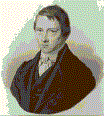
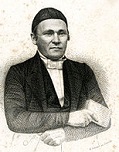
In May 1848 after becoming the first Euros to enter Africa from the Indian Ocean coast in 1846, then setting out last Oct. 16 to find the "mountain of Kenya", German Lutheran missionary explorers Johann Ludwig Krapf (1810-81) and Johannes Rebmann (1820-76) claim to sight 16,100-ft. (4.9km) Mount Kilimanjaro, incl. seeing snow, which is disbelieved for 12 years; on Dec. 3, 1849 Krapf claims to sight 7,058-ft. Mt. Kenya (with three peaks, Batian, Nelion, and Lenana, all named after great local ancestral chiefs), the #2 highest mountain in Africa, containing 12 glaciers despite being near the equator; nobody believes him, and it takes 34 years to rediscover it - that story's a pile of krapf?

In 1848 Philly-born explorer Elisha Kent Kane (1820-57) joins the U.S. Marine Corps to fight in the Mexican-Am. War, capturing and befriending Mexican Gen. Antonio Gaona and surveying the Gulf of Mexico.


In 1850 Frederick County, Va.-born mulatto army scout and explorer James Pierson "Jim" Beckwourth (Beckwith) (1798-1867) discovers Beckwourth Pass through the Sierra Nevada mountain range in Calif. 50 mi. N of Lake Tahoe, the lowest pass (5,512 ft.) over the Sierras, and guides the first west-bound wagon trains over it, then gets a group of investors to back him into developing the route, which later becomes the Feather River route of the Western Pacific Railroad, and founds Beckwourth, Calif. (modern-day pop. 36.8k) 15 mi. W of the pass, where he sets up a trading post, becoming the first stop for emigrants to Calif., once meeting 11-y.-o. Ina Coolbrith (1841-1928), who later (1915) becomes the first poet laureate of Calif.; in 1855 he leaves, travels to San Francisco, becomes famous after a book filled with his tall tales is pub., runs a store in Denver, Colo., marries an Indian named Sue, then returns in 1861.
In 1850 the First Grinnell Expedition is financed by Henry Grinnell to find the lost Franklin Polar Expedition, finding his Beechy Island winter camp before becoming icebound in 1851 and giving up; Elisha Kent Kane is the senior medical officer, who leads the Second Grinnell Expedition in 1853, setting a new record for northward penetration, maps 960 mi. of unexplored coastline N of 82 lat., and discovers the Polar Sea before their brig Advance becomes icebound in 1855 and they give up after losing three crew members.

In 1851 German explorer Heinrich Barth (1821-65) crosses the Sahara Desert twice, becoming the first white Euro to visit Adamawa; in Kukawa he discovers the Arabic Girgam, the royal chronicle of the Kanem-Bornu Empire around Lake Chad (700-1376), listing 69 rulers - hello, I need to talk to the general?

In 1851 married Scottish Congregationalist missionary explorer David Livingstone (1813-73) begins exploring Africa looking for a route to the interior from the E or W coast while vainly attempting to Christianize the natives, traveling N from Cape Town to the Zambezi (Bantu "mbeze" = fish) River, then W to Loanda on the Atlantic coast, then backtracking to the Zambezi River, attempting to follow it to its mouth in the Indian Ocean. In 1866 Scottish Presbyterian medical missonary David Livingstone (1813-73), backed by the London Missionary Society, friends and admirers begins exploring the lakes and rivers of C Africa to discover the source of the Nile (until his death), starting at the Ruvuma River, then to Lake Tanganyika next year, then W, where he discovers the Luapula (Upper Congo) River in S Congo, followed by Lake Mweru and Lake Bangweulu among the headwaters of the Congo River; meanwhile, people back home begin to wonder what's cooking, er, what's happened to him?

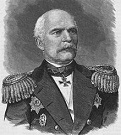
On Dec. 31, 1853 Russian tsar (since 1824) Nicholas I grants to Eastern Siberia gov. (since 1847) Nikolai Nikolayevich Muravyov (Muravyov-Amursky) (1809-81) the right to negotiate with the Chinese about extending the Russian border to the Amur River (prohibited since the 1689 Treaty of Nerchinsk), along with troops and settlers, and next year he sends a 77-barge fleet led by the steamship Argun to sail to the Amur's estuary, led by explorer (later adm.) Gennady Ivanovich Nevelskoy (1813-76) (known for the soundbyte "Where the Russian flag is hoisted it should never be lowered"), who goes on to prove that Sakhalin is an island.
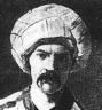

In 1853 after undergoing circmcision and dressing up as a Pashtun, multilingual English explorer-scholar-diplomat Capt. Sir Richard Francis Burton (1821-90) (educated at Trinity College, Oxford U.) becomes the first non-Muslim since 1503 to visit Mecca and Medina in disguise and live to talk about it - I bring you sweet things from my candy jar? On June 27, 1857 British explorers Sir Richard Francis Burton (1821-90) and John Hanning Speke (1827-64) begin to search for the source of the White Nile, setting out from the E coast of Africa, going on to obtain help from Omani Arabs and suffer from tropical diseases. In Feb. 1858 Burton and Speke discover Lake Tanganyika; Speke follows native advice and discovers Lake Victoria (Nyanza) alone, identifying it as the long-sought source of denial, er, the Nile - without speaking to Richard? In 1861 Burton becomes the first Euro to climb 13,255 ft. (4,040m) Mount Cameroon (Mongo ma Ndemi = mountain of greatness).

In 1854 Irish-born British naval officer Sir Robert John Le Mesurier McClure (1807-73) becomes the first to transit the very iffy Northwest Passage, becoming the first to circumnavigate the Americas, splitting a £10K reward from Parliament with his crew.
In 1854 Rwanda (Ruanda) is first visited by European explorers, who are impressed by the tallness of the Watusi - somebody needs to invent basket what?
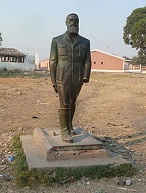
In 1854 Portuguese explorer Antonio Francisco Ferreira da Silva Porto (1817-90) crosses South Africa from W to E, going on to become the only white explorer in Portuguese West Africa.
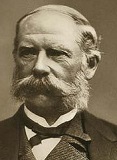
In 1854 after getting turned on by Alexander von Humboldt's "Cosmos" (1845), the Schlagintweit brothers of Munich, Germany incl. Hermann Schlagintweit (Hermann Rudolph Alfred von Schlagintweit-Sakünlünski) (1826-82), Adolf von Schlagintweit (1829-57), Eduard Schlagintweit (1831-66), Robert Schlagintweit (1833-85), and Emil Schlagintweit (1835-1904) begin exploring C Asia to study the Earth's magnetic field, traveling through the Deccan, Himalayas, Karakoram Mts., Kunlun Mts., and returning to Nepal in 1857, going on to pub. "Results of a Scientific Mission to India and High Asia" (4 vols.) (1860-66); Hermann recives the title Sakunlunski for crossing the Kunlun Mts.; Emil later sells 102 Tibet ms. and block books collected by his brothers to the Bodleian Library of Oxford U., which are used by Madame Helena Blavatsky.
On Sept. 18, 1855 after it goes looking for the 1845 Sir John Franklin Expedition in the Arctic in 1850 and ends up abandoned, the HMS Resolute is found by Am. whaler George Henry in an ice flow off Cape Walsingham in Baffin Island, and returned to Britain, after which Queen Victoria visits it and orders three desks to be made from some of its timbers; the Resolute Desk is presented by Queen Victoria in 1880 to U.S. Pres. Rutherford B. Hayes, who puts it in the White House, after which it is moved into the Oval Office in 1961 by First Lady Jackie Kennedy, then moved to the Smithsonian Inst. after JFK's 1963 assassination, and returned by Pres. Jimmy Carter; the Grinnell (Queen Victoria) Desk ends up in the New Bedford Whaling Museum in Mass.; the Queen Victoria Desk II ends up in the Royal Naval Museum in Portsmouth, England.
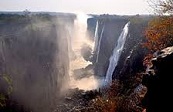
In Nov. 1855 David Livingstone becomes the first European to see the exciting Victoria Falls ("Mossioatunya" = "smoke that thunders") on the Zambezi River; he then travels to the mouth of the Zambezi River, then NE to Quelimane on the coast next year, becoming the first European to cross Africa, and finally sails for England - to get the Victorians excited?

In 1855-9 French-born Am. zoologist Paul Du Chaillu (1831-1903) is sent to West Africa by the Academy of Natural Sciences in Philadelphia, exploring the Ogooue River Delta and the Gabon estuary, confirming the ancient reports of Hanno the Navigator of Carthage of gorillas, becoming the first white Euro to see them; in 1863-5 he makes an expedition to C Africa, discovering a race of 4'8" avg. black forest pygmies (Gr. "pygme" = distance from elbow to knuckles) (mentioned by Homer, Aristotle, and Herodotus as dwelling in Africa, fighting with cranes and attacking Hercules, who captured some of them in his lion skin and took them to King Eurystheus of Tiryns) in the Ituri Forest. In 1861 he pub. Explorations and Adventures in Equatorial Africa, which sells 300K copies (#1 bestseller of 1861). In 1867 he pub. A Journey to Ashango Land. In 1868 he pub. Stories of the Gorilla Country. In those days of white racial supremacy among scientists, the thought of giant hairy men with tiny brains, and tiny men with even tinier brains seemed to fit right in with their developing notions of survival of the, er, human evolution, confirming all black Africans as occupying the bottom rung; too bad, Chaillu's critics discover that his mother is a mulatto, making him a quadroon, and the SHTF.
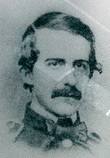
In 1857-8 during the Utah War U.S. Lt. Joseph Christmas Ives (1828-68) navigates the Colorado River to assess its navigability for the U.S. Army, starting in Baja Calif., and reaches the end of Black Canyon (near Las Vegas, Nev.) in his 54-ft. iron-hulled steamboat The Explorer, then becomes the first Euro to explore the floor of the Grand Canyon, which he calls "the Gates of Hell", his sketches portraying it as a dark and foreboding place; too bad, he switches to the Confed. side in the U.S. Civil War, becoming an aide to Jefferson Davis.
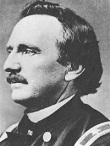
In 1859 the Raynolds Expedition (ends 1860), led by U.S. Army topographical engineer Capt. William Franklin Raynolds (1820-94) explores and maps territory between Fort Pierre, S.D. and the headwaters of the Yellowstone River.

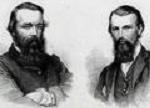
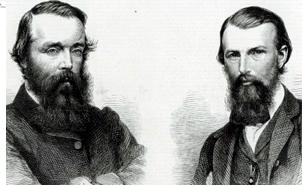
On Apr. 22, 1860 Scottish-born explorer John McDouall Stuart (1815-66) reaches 1,916 ft. (584m) Mt. Stuart, the center of Australia (not really, but he thought so) from the S before encountering hostile natives and turning back, causing a £2K reward to be offered to go all the way to the N coast, and on Aug. 20 the 19-man 27-camel, 23-horse Burke-Wills Expedition (largest exploring party in white Australian history), led by inept Irish-born Robert O'Hara Burke (1821-61) and surveyor William John Wills (1834-61) sets out from Melbourne, Australia to find a S-N route through mainly desert Australia, reaching the Gulf of Carpentaria next Feb.; after returning for home, they arrive at Coopers Creek next Apr. 21, only to find that the party they left there had departed a few hours earlier for Menindee; the men then lose their last camel, become too weak to go on, and Burke and Wills die of starvation in June; Wills' father later edits his diary for pub.; meanwhile Stuart sets out again next Jan. 1 with 12 men and 49 horses, reaches the Gulf of Carpentaria on Feb. 11, and returns in Sept., becoming a big hero.

In 1860 the lost ruins of the Temple of Angkor Wat in Cambodia are rediscovered (for the umpteenth time?) in the jungle by French explorer Henri Mouhot (1826-61), who dies next year in Laos, after which his memoirs become a bestseller; the ruins are cleared in 1908 and a moated park created around them.

In 1863 Riga, Latvia-born German explorer Georg August Schweinfurth (1836-1925) goes to Africa, exploring Ethiopia and Egypt incl. the Red Sea, the Nile River, and Khartoum (until 1866). In Jan. 1869 the Alexander von Humboldt Foundation sends him on a scientific mission from Khartoum up the White Nile to Bahr-el-Ghazal through the Congo-Nile watershed to Mangbetu (Monbuttu) cannibal country, where he discovers the Uele River on Mar. 19, 1870, which he surmises is independent of the Nile and part of the Chad system, discovering the Aka (Bayaka) (Babenzele) pygmy people before returning to Khartoum in July 1871, becoming the first white Euro to prove the existence of African pygmies.

On May 29, 1869 Mount Morris, N.Y.-born geologist John Wesley "Wes" Powell (1834-1902) of Ill. Wesleyan U. begins the 3-mo. Powell Geographic Expedition of 1869) starting from Green River Station, Wyo., becoming the first recorded trip by white Euros through the entire Grand Canyon, ending at the confluence of the Colorado and Virgin Rivers in Nev., surviving hardships incl. boat losses to pub. The Exploration of the Colorado River and Its Canyons in 1875.

In 1869 Australian explorer Sir John Forrest (1847-1918) begins the first of three expeditions in Western Australia (until 1874). On Aug. 15, 1890 a govt. is set up in Western Australia, with him as its first PM on Dec. 22 (until Feb. 15, 1901); he is knighted in 1891.
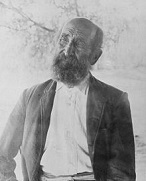
In 1869 Bridgend, Scotland-born Australian explorer John Ross (1817-1903) explores the Stevenson River to Eringa, discovering Mount Humphries, which he names after his children, Sarah, Rebecca, Alexander, and John; in 1870 he explores a route for the Australian Overland Telegraph Line, traveling across the MacDonnell Ranges, the Simpson Desert, and the Fergusson Ranges, arriving at the Todd River; in Mar. 1871 he reaches and names Alice Springs in the Northern Territory, later finding out that Euro explorer W.W. Mills beat him there.

In 1870 Baron Nils Adolf Eric Nordenskjold (Nordenskiöld) (1832-1901) of Sweden explores the interior of not-really-green Greenland; in 1878-80 he leads the Vega Expedition, becoming the first Arctic expedition to navigate through the Northeast Passage, and first to circumnavigate Eurasia.

In 1870 Russian explorer Nikolai Mikhaylovich Przhevalski (1839-88) becomes the first to cross from Khakhta across the Gobi Desert to the Upper Yangtze River, then over the Humboldt Mts. into Tibet, becoming the first to describe the wild Przewalski's horse; in 1879-80 he crosses the Tian Shan into Tibet, he but never reaches his goal of Lhasa, begin stopped 160 mi. away by Tibetan officials; in 1883-5 he makes his last trip to the E Tian Shan Mts., turning back at the Yangtze River.




Livingstone, I presume? Stanley, I presume? On Nov. 10, 1871 Welsh-born U.S. journalist Sir Henry Morton Stanley (John Rowlands) (1841-1904) (fresh from covering Am. Indians in the SW U.S.) finds missing Scotch missionary explorer David Livingstone (1813-73) in Ujiji (Kavele) (a Robin Williams boxed game?) due W of Zanzibar on the E shore of Lake Tanganyika in Africa, where Livingston had just returned from a journey W into cannibal territory, and his lip-smacking report to the New York Herald titled How I Found Livingstone captures the imagination of the world; Stanley then becomes an explorer himself, accompanying Livingstone N of Tanganyika, then going solo, visiting the fabled Mountains of the Moon in the Ruwenzori Mts. in EC Africa (highest peak 16,762 ft. Mount Stanley), which support glaciers that are the source of the Nile River, going on to pub. Through the Dark Continent: The Sources of the Nile Around the Great Lakes of Equatorial Africa and Down the Livingstone River to the Atlantic Ocean (2 vols.) in 1878, coining the term "dark continent" for Africa; in 1874 Livingstone begins a posth. nat. hero, causing several missionary initiatives into C Africa to be founded. In Aug. 1873 English naval cmdr. Verney Lovett Cameron (1844-94), sent by the Royal Geographical Society on a 2nd expedition to relieve David Livingstone (b. 1813) meets his servants bearing his body to the coast, finding he died on May 1; Cameron pushes on and becomes the first European to cross tropical Africa from E to W, finding some of Livingstone's papers, exploring the S half of Lake Tanganyika, and reaching the Atlantic Ocean in Nov. 1875.

In 1873 Austrian explorers Julius Payer (1841-1915) and Karl Weyprecht (1838-81) discover Franz Josef Land in the Arctic Ocean E of Spitsbergen; the expedition goes from 1871-4.

In Jan. 1876 Argentine explorer Francisco Pascasio "Perito" Moreno (1852-1919) reaches Lake Nahuel-Huapi in the S Andes Mts. of N Patagonia, discovering Lake Argentino on Feb. 15, 1877, going on to explore the rivers of Patagonia, discovering beautiful church organ-like Mount Fitz Roy (Cerro Chaiten) on the Argentina-Chile border on Mar. 2, named after the cmdr. of HMS Beagle in the 1830s; Perito Moreno Glacier 48 mi. from El Calafate is later named after him.

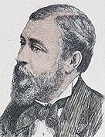
In 1876 after the British Arctic Expedition (begun 1875), led by Vice-Adm. Sir George Strong Nares (1831-1915) in Discovery and Alert becomes the first to sail between Greenland and Ellsmere Island (Nares Strait) to the Lincoln Sea, discovering no ice-free Open Polar Sea as hoped, a sledding party led by Sir Albert Hastings Markham (1841-1918) sets a record for N lat. at 83 deg 20 min, and skedaddles back home in the summer after the crew begin suffering from scurvy - that *?!*! pole, so near and so far?
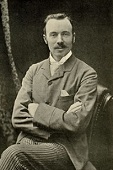
In 1879 English explorer Joseph Thompson (1858-95) explores the Great Rift Valley of Africa, trying it again in 1883 and reaching the N shore of Lake Victoria but failing to climb Mt. Kilimanjaro, later getting Thomson's Gazelle and Thomson's Falls named after him; in Jan. 1885 he pub. the bestseller Through Masai Land, describing snow-capped mountains on the equator and how he had terrified hostile Maasai warriors by removing his false teeth, making a fan of H. Rider Haggard, who uses it to write his bestselling novel King Solomon's Mines (1885).
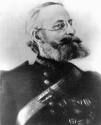

In summer 1881 U.S. Army 1st Lt. Adolphus Washington Greely (1844-1935) and 24 men leave the U.S. on the Lady Franklin Bay Expedition (ends 1884), and arrive in Aug. at Lady Franklin Bay, Ellesmere Island (Grinnell Land) 500 mi. from the North Pole, and set up Fort Conger to take observations for the First Internat. Polar Year (1882-3), ending up stranded until June 22, 1884; on June 22, 1884 (9:00 p.m.) the Navy relief expedition led by Capt. Winfield Schott Schley (1839-1911) on the converted whaler Bear reaches the survivors of the Greely expedition at Cape Sabine, and rescues six of the original 25, incl. Greely; Albert L. Operti (1852-1927) is commissioned to produce the painting The Rescue of the Greely Party, which is hung at the U.S. Capitol; in 1887 Greely is promoted to maj.-gen. and chief of the Army Signal Corps, going on to fade away with style and flair?
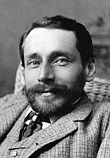
In 1883 Canadian geologist George Mercer Dawson (1849-1901) explores the Canadian Rockies, discovering 11,870 ft. (3,618m) Mount Assiniboine and 11,627 ft. (3,544m) Mount Temple, pub. a map in 1886 covering from the U.S. border to Red Deer Valley and Kicking Horse Pass; in 1887 he begins exploring N British Columbia to the headwaters of the Yukon River, pub. maps in 1897 just in time for the Klondike Gold Rush (1896-99), causing Dawson City in the Yukon to be named after him, along with Dawson Creek in British Columbia.
In 1885 French Capt. ? Brouet discovers the source of the 2.6K-mi. Niger River of W Africa as the Tembi River, which is joined by the Mayel-Balevel River about 300 mi. above Timbuktu.

On Feb. 3, 1887 after leaving London last Jan. 21, the Emin Pasha Relief Expedition, led by Sir Henry Morton Stanley leaves Cairo to rescue Gen. Charles "Chinese" Gordon's besieged gov. of Equatoria (S Sudan) Mehmed Emin Pasha (Isaak Eduward Schnitzer) (nee Eduard Carl Oscar Theodor Schnitzer) (1840-92) begin, traveling 100 mi. up the Aruwimi River in N Belgian Congo, rescuing Emin Pasha and returning via Lake Victoria on Aug. 15, 1889 after Emin Pasha drunkenly falls out of a 2nd story window he thought was a balcony; in May 1890 Stanley returns to Europe a big hero, with his 900-page book "Darkest Africa" selling 150K copies; too bad, by fall accusations of incompetence in the Rear Column end the praise, after which there are no more African expeditions not run by govts. in pursuit of military or political goals, or for purely scientific purposes; in 1898-1900 a sleeping sickness epidemic in Congo, W Uganda, and S Sudan is blamed on native cattle traveling with the expedition.

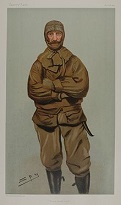
In 1888 Fridtjof Nansen (1861-1930) of Norway leads an exploration of Greenland on snowshoes and cross-country skis which makes the first crossing. In 1893 English explorer Frederick George Jackson (1860-1938) begins an Arctic expedition in Russia and Lapland, then next year begins the Jackson-Harmsworth Expedition, financed by newspaper Alfed Harmsworh to explore Franz Josef Land (until 1897), proving that it is an archipelago not a continent; meanwhile Fridtjof Nansen (1861-1930) of Norway leads an unsuccessful expedition to the North Pole (ends 1896) which drifts with the Arctic ice pack and reaches a record N lat., influencing future expeditions with innovations in equipment, clothing, and techniques; on June 17, 1896 Jackson happens on them by accident in Franz Josef Land as they are trying to to return by sledge, saving their lives.
On Sept. 6, 1892 after whales in the Arctic are overfished, the Dundee Whaling Expedition (ends 1893) leaves Scotland in four steam-powered whaling ships, but harvest no whales; Scottish oceanographer William Speirs Bruce (1867-1921) takes part, exploring the Antarctic coastline; next Jan. 8 Capt. Thomas Robertson discovers Dundee Island.
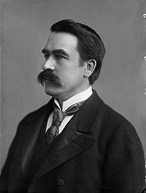
In 1892 Rochester, Kent, England-born Sir Martin Conway (1856-1937) claims to become the first to scale 23K-ft. Himalayan peaks; later measurements prove he only reched 22,322 ft. (6,804m); in 1896-7 he explores the interior of Spitsberger, and in 1898 he explores and surveys the Bolivian Andes, scaling Mt. Ancohuma (Sorata) (2,1086 ft./6,427m), stopping 50 ft. short of the summit of Mt. Aconcagua (22,831 ft./6,959m), then exploring Tierra del Fueto and failing to scale Mt. Sarmiento.

In 1892 Konigsberg, Germany-born explorer Erich Dagoert von Drygalski (1865-1949) explores West Greenland (until 1893).

In Aug. 1893 self-taught white English babe Mary Kingsley (1862-1900), whose daddy died and left her an income allowing her to do her thing arrives in Luanda, Angola and begins living with the natives, learning their survival skills, and going on to explore the Ogowe River to visit the cannibal Fang tribe, then climb 13,760-ft. Mount Cameroon by a new route, finally returning to England in Oct. 1895 and shocking the WASP prudes by telling them that blacks aren't really inferior and that polygamy is natural for them, but not admitting to sex with blacks?
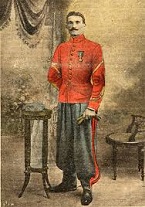
A Frog tries to become a combo Passepartout and Marco Polo? In 1893 French diplomat Charles Eudes Bonin (1865-1929), new envoy to the Mung people of Laos begins an expedition to explore the Mekong River to resolve a territorial dispute between Siam and Annam, getting Siam to relinquish its claims; in 1895 he gets a promotion and begins another expedition from Hanoi up the Red River into SW China, then N into the Gobi Desert of Mongolia, through Tibet to the Siberian frontier, then on to Beijing and France in 1897; in 1898 he starts out in Shanghai, travels up the Yangtze River to the Tibetan border, then Beijing, N into S Mongolia then N Tibet, visiting Qinhai Lake (Koko Nur) and Lop Nur, returning E to Beijing along Marco Polo's route, returning with the first scientific maps of the Yangtze and Yellow Rivers.

In 1894 Anglo-Norwegian explorer Carsten Egeberg Borchgrevink (1864-1934) begins exploring the Antarctic, visiting the mainland; in 1898 he leads an Antarctic expedition (ends 1900), which becomes the first party to winter on the Antarctic continent and sets a record for S latitude.

In 1894 Swedish explorer Sven Anders Hedin (1865-1952) begins the first of three expeditions in C Asia (ends 1908), visiting Chinese Turkestan and Tibet, becoming the last person to receive a Swedish knighthood in 1902.

On Aug. 16, 1897 the Belgian Antarctic Expedition sets sail, led by Baron Adrien Victor Joseph de Gerlache de Gomery (1866-1934); it returns in Mar. 1899 with the first photos of Antarctica.
On May 31, 1899 the Harriman Expedition (funded by railroad tycoon E.H. Harriman) leaves Seattle for a 2-mo. scientific survey of the Alaskan coast, causing Harriman Fjord in Prince William Sound to be named for him.
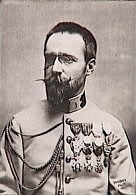
On Nov. 2, 1899 the French Foureau-Lamy Mission, begun last year under Fernand Foureau (1850-1914) and Amedee-Francois (Amédée-François) Lamy (1858-1900) complete their conquest of the central Sahara by traversing it to the trading post of Zinder between the Niger River and Lake Chad, meeting with the Gentil Mission and the Voulet-Chnoine (Central African-Chad) Mission in Kousseri, Chad next Apr. 21, after which on Apr. 22 Sudanese warlord Rabih az-Zubayr (b. 1842) attacks Lamy and his 700 riflemen, who crush and kill Rabin, although Lamy is KIA, causing French gov. Emile Gentil to name the new capital of the French Territory of Chad on the Chari River near its confluence with the Logone River Fort Lamy, which is renamed N'Djamena in 1973.

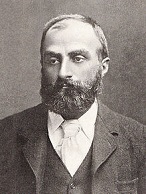
In 1901 the British Nat. Antarctic (Discovery) Expedition (ends 1904) becomes the first official British Antarctic exploration voyage since James Clark Ross in 1839, launching the careers of Antarctic explorers Robert Falcon Scott (1868-1912) (leader), Ernest Shackleton, Edward Wilson, Frank Wild, Tom Crean, and William Lashly, reaching the farthest south mark of 82 deg 17 sec; meanwhile in 1902 the Scottish Nat. Antarctic Expedition (SNAE) to the South Orkney Islands and the Weddell Sea (ends 1904) is launched by Scottish explorer William Speirs Bruce (1867-1921).

On June 18, 1906 Italian explorer Prince Luigi Amedeo Giuseppe Maria Ferdinando Francesco, Prince of Savoy-Aosta, Duke of the Abruzzi (1873-1933) makes the first ascent of the 16,762-ft. (5,109m) highest peak of the Ruwenzori Mts. (Range) in Africa, a source of the Nile River, causing Mt. Luigi di Savola to be named in his honor; in 1909 he unsuccessfully ascends K2 in Karakorum, reaching 6,250m, causing his route up the East Ridge to be named the Abruzzi Spur in his honor. In 1909 Duke Luigi of the Abruzzi sets a world record in ascending Mt. Godwin-Austin in Kashmir to a height of 24.6K ft.
In 1906 after claiming that it was ice-free in 1903, Norwegian explorer Roald Amundsen becomes the first to sail the Northwest Passage after determining the position of the magnetic North Pole.




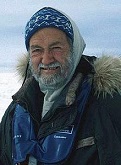
White is right on the White poles? On Apr. 6, 1909 after arriving on Ellesmere Island last year aboard the Roosevelt, Cresson, Penn.-born explorer Robert Edwin Peary Sr. (1856-1920) (known for hooking up with Inuit women and fathering children, and stealing valuable meteorites from Inuits to pocket the profits, while trying to cover it up) allegedly reaches the North Pole; he waits until Sept. 6 to send word about it; being white he naturally gets the credit, receiving the Thanks of Congress and promotion to rear adm. in 1911, although his black partner (who started out as a clerk selling furs, and met Peary in the shop) Matthew Alexander Henson (1866-1955) might have reached the Pole first, and four Eskimos came with them, Ooqueah, Ootah, Egigingwah, and Seegloo; on Mar. 30, 1911 the U.S. Congress passes a special act giving him recognition, plus a Rear Adm.'s pension after Dr. Frederick Albert Cook (1865-1940) fails to prove that he preceded him by a year (Apr. 21, 1908), beginning the Great Polar Controversy; in 1989 despite British explorer Sir Wally William "Wally" Herbert (1934-2007) (first man to walk to the North Pole in 1969 on the 60th anniv. of you know what) pub. the book The Noose of Laurels: Robert E. Peary and the Race to the North Pole, concluding that Peary only got 60 mi. (97km) from the pole and falsified his records, the Navigation Foundation certifies Peary's claim, but most scientists and explorers end up doubting that either Cook or Peary actually did it.

In 1910 Am. naturalist Roy Chapman Andrews (1884-1960) begins exploring the East Indies on the USS Albatross, going on to become the first real-life Indiana Jones, visiting the Arctic, China, and Mongolia, and coining the term "Outer Mongolia" for any place that's hard to reach.


On Dec. 14, 1911 Roald Amundsen (1872-1928) of Norway becomes the first man to reach the South Pole, beating the Terra Nova (British Antarctic) Expedition led by Plymouth, Devon, England-born Capt. Robert Falcon Scott (1868-1912), and placing a Norwegian flag on it; Amundsen takes a NW-SE route to-from Little America over Axel Heiberg Glacier, while Scott takes a NE-SW route to-from Ross Island over Beardmore Glacier, and never makes it all the way back - talk about a topsy-turvy world? On Jan. 17, 1912 British explorer Robert Falcon Scott (1868-1912) and his pity party reach the South Pole, find that Norwegian explorer Roald Amundsen has beaten them by five weeks, and perish on the return journey, dying at their Last Stop on Mar. 29 after making it onto the Ross Ice Shelf; on Mar. 18 Scott writes in his diary "My right foot has gone, nearly all the toes"; on Feb. 17 Petty Officer Edgar Evans dies first, then Capt. Lawrence Oates goes nuts from severe frostbite and takes off into a storm after saying "I am just going outside and may be some time"; Scott, Lt. Henry Bowers and Dr. Edward Wilson are the last to go, after Scott writes a Letter to Wife Kathleen, saying for her not to feel sorry for him because "How much better it has been than lounging in comfort at home."
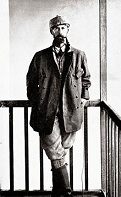
In 1920 after WWI keeps him from doing it, British archeologist Lt. Col. Percy Harrison Fawcett (1867-1925) travels to the Mato Grosso region of Brazil in search of the Lost City of Z, and gives up after catching a fever and shooting his pack animal; a 2nd expedition in 1925 with his son Jack and Raleigh Rimell ends in failure after they disappear in the jungle.


In 1921 a British team under lt. col. Charles Kenneth Howard-Bury (1881-1963) launches the 1921 British Mount Everest Reconnaissance Expedition, exploring the N approaches of Mt. Everest and successfully paving the way for the later Everest Expedition; after he returns, his description of tracks of a "large loping grey wolf" get garbled with Sherpa descriptions of a "filthy snowman" ("metch kangmi") by Henry Newman of the Calcutta Statesman, who astounds the world with tales of the Abominable Snowman (Yeti); the whole affair makes Howard-Bury a celeb and gets him elected to Parliament as a Conservative - the original Tricky Dicky Nixon?

On May 23, 1924 Greenland-born Danish explorer ("Father of Eskimology") Knud Johan Victor Rasmussen (1879-1933) reaches Point Barrow after completing the longest dog sledge journey ever made across the North Am. Arctic, becoming the first Euro to cross the Northwest Pessage via dog sled.
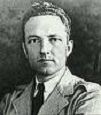
It's a Byrd, it's a plane? On May 8-9, 1926 U.S. Navy Lt. cmdr. Richard Evelyn Byrd (1888-1957) and co-pilot Floyd Bennett (1890-1928) fly a trimotor Fokker, the Miss Josephine Ford from Kings Bay, Spitsbergen over the North Pole and back in 15.5 hours, becoming the first polar flight, receiving a Hubbard gold medal from Pres. Coolidge for "valor in exploration"; Bennett is chosen to fly Byrd over the South Pole, but injuries prevent him; on May 9, 1996 Ohio State U. announces the discovery of his diary, leading one specialist to conclude that Byrd fell short of his destination - and the man living with you is not your husband? Byrd Byrd Byrd, the Byrd's the word? On Nov. 28-29, 1929 after arriving in Antarctica last Dec., establishing the base named Little America on the Bay of Whales, and discovering the Edsel Ford Range to the NE in Jan., followed by Marie Byrd Land to the E of it, Richard Evelyn Byrd (1888-1957) becomes the first man to fly over the South Pole in a trimotor Fokker with three companions, getting him a promotion to the rank of rear adm. (retired) by a special act of the U.S. Congress; he takes 2.5 tons of sweet Necco Wafers on his trip.

In May 1926 Roald Amundsen, Lincoln Ellsworth (1880-1951), and Italian explorer Umberto Nobile (1885-1978) fly over the North Pole to Alaska in the dirigible Norge, travelling 3.4K mi. from Kings Bay, Svalbard (Spitsbergen) to Teller, Alaska; in 1928 Amundsen dies while attempting to rescue Nobile after a crash.


On Apr. 28, 1928 Australian explorer George Hubert Wilkins (1888-1958) and U.S explorer Carl Benjamin "Ben" Eielson (1897-1929) fly from Point Barrow, Alaska to Spitsbergen, becoming the first transarctic flight, and earning Wilkins a knighthood; call me sir Wilkins then goes on to become the first to fly over the Antarctic while mapping large portions (ends 1930).
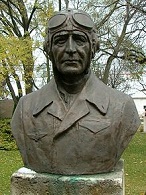
In 1932 an expedition led by aristocratic Hungarian aviator Laszlo Almasy (László Ede Almásy de Zsadány et Törökszentmiklós) (1895-1951) begins exploring the Libyan Desert in search of the fabled oasis city of Zerzura AKA The Oasis of the Birds, becoming the subject of the 1992 Michael Ondaatje novel "The English Patient", in which he is turned from gay to straight.

On Nov. 23, 1935 while flying 2.3K mi. over the Antarctic from Dundee Island to the Ross Ice Shelf, claiming 300K sq. mi. for the U.S., Chicago, Ill.-born polar explorer Lincoln Ellsworth (1880-1951) discovers the 16,050 ft. (4,892m) Ellsworth Mts. (highest in Antarctica), naming the N half the Sentinel Range; in 1939 he makes another flight, claiming 77K sq. mi. more (the Am. Highland).

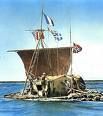
On Apr. 28, 1947 Norwegian ethnographer Thor Heyerdahl (1914-2002) leaves Lima, Peru in a tiny 6-man pae-pae balsa log raft with a bamboo cabin named Kon-Tiki, traveling 7K km (4.3K mi.) to the Tuomotu Islands in Polynesia in 101 days, and spawning all kinds of theories of history; a documentary movie is released in 1951.
In Mar. 1955 Adm. Richard Evelyn Byrd makes his Fifth Antarctic Expedition as head of Operation Deep Freeze, and head of all U.S. activities in the Antarctic on Nov. 2; on Dec. 28 he lands at Kainan Bay (800 mi. from the South Pole), setting up Little America V; next Jan. he makes his 3rd flight over the South Pole, and returns to the U.S. next Mar., where he is made head of the new U.S. Office of Antarctic Programs.

On June 11, 1969 (60th anniv. of the Peary expedition) a 4-man British team led by Sir Walter William "Wally" Herbert (1934-2007) completes the first-ever surface crossing of the Arctic Ocean, and the longest Arctic foot journey, going 3.7K mi. in 476 days, becoming the first man fully recognized for walking to the North Pole, claiming that Peary had falsified some records and never actually reached it although he came close, getting him a knighthood in 2000, and the accolade of "greatest polar explorer of our time" by Sir Ranulph Fiennes.




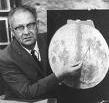

Glory Days, Glory Days, Glory Days pass you by? Just in time to make JFK's prediction come true, white IS right on the Moon on the anniv. of the creation of Washington D.C., the execution of Tsar Nicholas II, the installation of the first parking meters, and the first A-bomb explosion? On July 16, 1969 (Wed.) Apollo 11 blasts off from Cape You Know What, and goes into lunar orbit on July 19, then lands on the "place of magnificent desolation" (the Moon) on July 20 at 4:17 p.m. EDT in the Eagle landing module; as 600M worldwide watch on TV (Soviet TV snubs them), white, blonde-blue, straight Christian church-going Wapakoneta, Ohio-born WASP male Neil Alden Armstrong (1930-2012) (shoe size 9-1/2) (salary $30K a year) becomes the first human to set foot on the Moon at 10:56 p.m. EDT at Tranquility Base (total price tag $35B) after taking a recording of Antonin Dvorak's Symphony No. 9 in E minor, op. 95, B. 178 ("From the New World") with him; his first words are: "One small step for [a] man, one giant leap for mankind"; he rubs white-is-right in more by carrying a piece of fabric from the 1903 White, er, Wright brothers plane Flyer 1; Glen Ridge, N.J.-born U.S. Air Force Col. Edwin Eugene "Buzz" Aldrin Jr. (1930-) follows close behind, later uttering the soundbyte "Neil Armstrong was the first man to walk on the Moon, I am the first man to piss his pants on the Moon"; Presbyterian Aldrin performs a communion before Armstrong starts his walk, but due to a lawsuit by atheist Madalyn Murray O'Hair they black it out; meanwhile Rome, Italy-born U.S. Air Force Lt. Col. Michael "Mike" Collins (1930-) stays in orbit at 60-75 mi. in the Columbia Command Module (named after the cannon-fired Columbiad spacecraft in the 1865 Jules Verne novel "From the Earth to the Moon"), with the Mission Control Center in Houston, Tex. uttering the immortal soundbyte: "Not since Adam as any human known such solitude as Mike Collins during this 47 minutes of each lunar revolution when he's behind the Moon with no one to talk to except his tape recorder"; after the onboard computer fails from interference caused by the radar system as they are making their landing, Armstrong and Aldrin switch to manual control and display their hotdogging cowboy skills, landing with less than 1 min. of fuel left; the first moon walk confirms the prediction made in 1964 by Dutch-born U. of Ariz. astronomer Gerard Peter Kuiper (1905-73) (who helped identify lunar landing sites) that it would be "like crunchy snow"; Aldrin brings a copy of the 1941 poem A Prayer for Protection by Am. poet James Dillet Freeman (1912-2003), causing to be called the "Poet Laureate to the Moon"; after Aldrin plants a nylon flag on El Moono, and they have their romp, they return to Earth and splashdown on July 24 in the Pacific, and are brought aboard the USS Hornet (CV-12), then greeted personally by Pres. Nixon while on a round-the-world tour (July 23-Aug. 3) to try to get back some of the billions wasted, er, invested in a second industrial rev., er, wasted with some good Cold War propaganda; they then spend 65 hours inside the Mobile Quarantine Facility to prove they didn't acquire "Moon germs" under the July 16 U.S. Extra-Terrestrial Exposure Law, violation of which carries a 1-year sentence and $5K fine; Walter Cronkite makes CBS-TV the most-watched TV network for the missions, which follows through to Apollo 13; Thomas Otten Paine (1921-92) is the head of NASA in 1969-7 (first seven Apollo manned missions), and goes on to become pres. of Northrop Corp. in 1976-82; The New York Times finally apologizes for a 1920 article publicly scoffing at Robert Goddard's idea that a rocket can function in a vacuum; David Threlfal of Preston, Lancashire, England is awarded a £10K check by bookmaker William Hill, Ltd. for a £10 bet in 1964 that a man would land on the Moon by 1971 at 1000 to 1 odds; millions believe the whole thing is a staged govt. hoax, pointing to the "rippling flag", absence of blast craters, shadows suggesting stage lighting, etc.; millions more that all that money was "dumped into space", or that it would have been better spent reclaiming the deserts, developing agriculture, affordable housing and medicine, or jump-jiving woo woo woo?; the landing was faked to help the U.S. win the Cold War?; the dir. of the fake landing was Stanley Kubrick, who was told to keep his mouth shut, but gave it away in highly coded form in his 1980 film "The Shining"?; too bad, the astronauts leave radar corner reflectors, which can be seen from Earth, proving they were there, or just that unmanned ships made it there?; on July 16, 2009 NASA admits that it lost its original hi-res moonwalk footage, but is hiring guess-who Hollyweird to restore it, stoking conspiracy theorists; in the 20-zeds the NASA Lunar Reconnaisance Orbiter (LRO) allegedly takes hi-def photos of the landers and astronaut tracks, but it can hardly be called an independent witness?; the jury will be out until an independent group visits the Moon and verifies the junk they allegedly left?; on Jan. 13, 2017 after the Chinese Lunar Rover produces no evidence of Apollo Moon landings, 200 officials of the Chinese Space Program pub. a petition in the Beijing Daily Express asking NASA for an explanation; zonk, that's fake news :); the Apollo 11 astronauts appear on the first U.S. stamp to depict a living American, issued later in the year; "For one crowning moment we were creatures of the cosmic ocean" (Aldrin); "Slipped the surly bonds of Earth to touch the face of God" (Ronald Reagan); Aldrin later suffers from depression - buzzy Excedrin headache number?
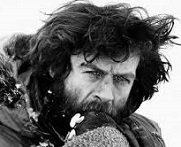
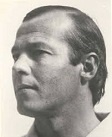
On Sept. 2, 1979 British explorers Sir Ranulph "Ran" Fiennes (Ranulph Twisleton-Wykeham-Fiennes, 3rd Baronet) (1944-) and Charles Robert Burton (1942-2002) start out from Greenwich down the Thames River on the 2.5-year 52K-mi. Transglobe Expedition along the Greenwich meridian to become the first to circumnavigate the Earth on a N-S route, incl. the North and South Poles, arriving back in Greenwich on Aug. 29, 1982.